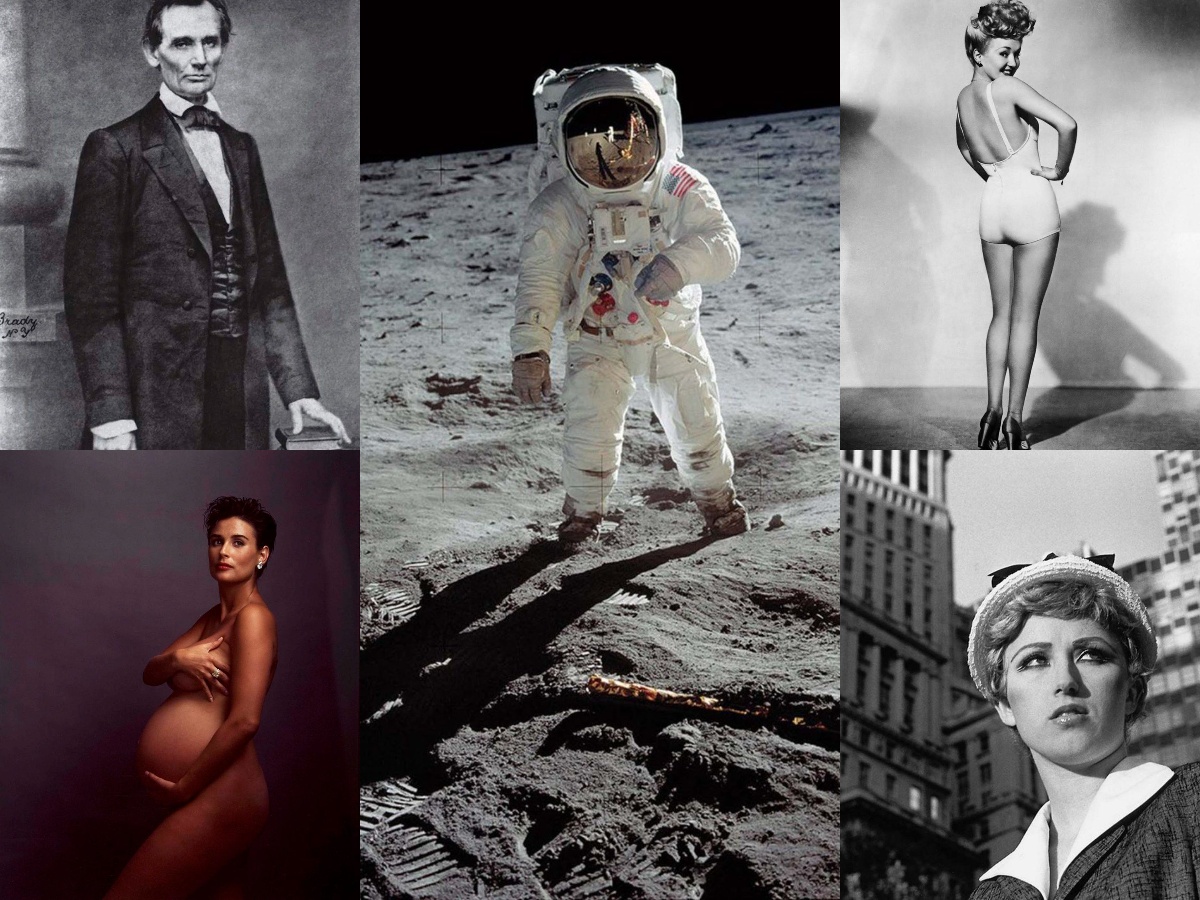 These historical photos reflect the most important moments of humanity. In 2016, Time magazine created a project aimed to gather 100 most influential photos ever, printed as a book “100 Photographs: The Most Influential Images of All Time”.
These historical photos reflect the most important moments of humanity. In 2016, Time magazine created a project aimed to gather 100 most influential photos ever, printed as a book “100 Photographs: The Most Influential Images of All Time”.
How these historical photos were selected?
But how can you pick the most valuable historical photos among the thousands and thousands of excellent and noteworthy pictures? The editorial team surveyed many opinion leaders, history, and photo specialists to create a great and inspiring list. Depicted things and events are important because they affect our lives a lot.
Ben Goldberger, Paul Moakley, and Kira Pollack, responsible for the list formation, noted that photography is the long-lasting evidence of the past, and they should be taken, shared, and free to access. All of these historical photos deliver the atmosphere and spirit of old times.
The first picture in the list was taken in 1826, last – in 2015. One hundred eighty-nine years of human history, joyful and tragic, are assembled to show our story from the camera objective.
Oldpics.net decided to enrich many of the stories behind the historical photos in this list, adding interesting facts or even dedicated publications to the fascinating images.
All these historical photos are shown in chronological order, starting with the oldest ones, as we avoid ranking.

`1. View from the Window at Le Gras, Joseph Nicéphore Niépce, 1826.
To create the first photo, Joseph Nicéphore Niépce used camera obscura – a “dark chamber” combined with lithography printing to catch the sunlight illuminating the view outside his window. His first camera allowed him to depict and print images – Niépce spends a lot of time searching for suitable photosensitive substances (silver-containing liquids, lavender oil, etc.) and printing surfaces (pewter, paper, tissue) and calls the process “heliography.” Joseph Nicéphore Niépce was not gifted as a painter, but he indeed was a great inventor. Trying to catch the real image of the surrounding world without hand-painting, he created many pre-photos, and the one above, printed on the bitum, survived till now, becoming the precursor of the era of photography. In the next years, on the base of Niépce’s invention, Louis Daguerre built the daguerreotype – another milestone of photography evolution. The photo history has been started!

2. Boulevard du Temple, Louis Daguerre, 1839.
Joseph Nicéphore Niépce, in tandem with Louis Daguerre, resulted in the improvement of heliography and the creation of a much faster and convenient depicting method – the daguerreotype. While heliograph gave poor images of outside exposition and mainly was used to reproduce pictures and paintings, daguerreotype allowed more explicit photos. This method was used to make the first photographic image of a human being. A sunny spring day on Paris’ Boulevard du Temple, where a random shoe shiner polished his customer’s footwear, was captured by Louis Daguerre and was saved in the annals of history. This technique rapidly spread worldwide, and in 1840 the firth photo atelier was opened in New Your. Daguerreotypy remained popular over the decade. Nowadays, it is rarely used as a kind of art, and this photo is just a part of photography history.
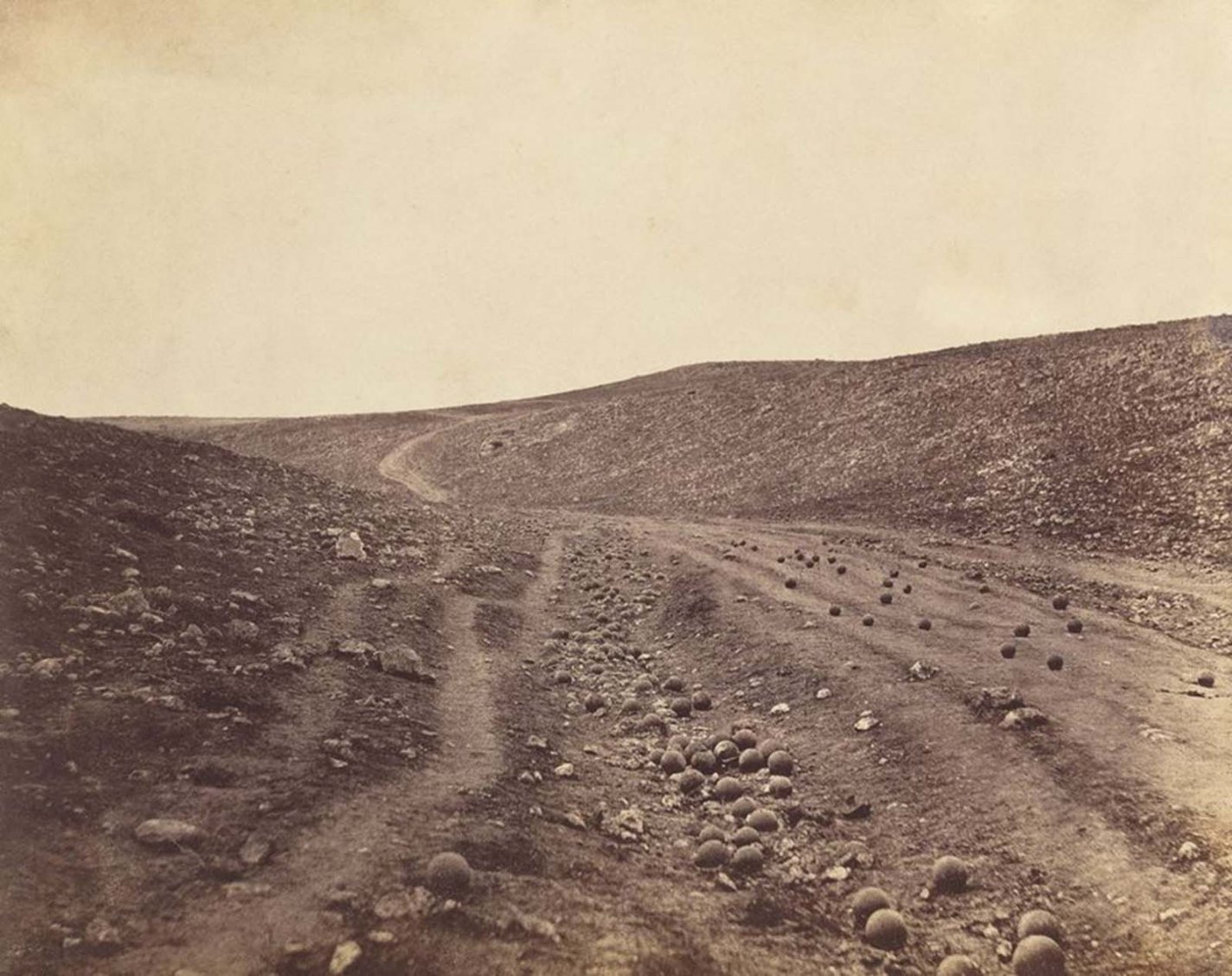
3. The Valley of the Shadow of Death, Roger Fenton, 1855.
A full story about this historical photo
British photographer Roger Fenton made the “first iconic photograph of war” in 1855 during Crimean War as a part of international territorial conflict. The name of the photo refers to the King James Version of David Psalm “Yea, though I walk through the valley of the shadow of death, I will fear no evil: for thou art with me; thy rod and thy staff they comfort me,” due to which Alfred Tennyson used it as the illustration to the poem “The Charge of the Light Brigade” devoted to the incident of British army attack in the battle on the nearby location.
Roger Fenton was not only the first war photographer – but he also was the first one who took part in the Great Exhibition of the Works of Industry of All Nations with the history photo images.
The land covered with cannonballs became the symbol of the war, but Fenton’s pictures during his visit to Crimea underwent the author’s criticism. There are no dead bodies, only landscapes to please the British public, including the Royal Family.
Interesting fact: Roger Fenton made numerous portraits of the Crimean War’s combatants but none combat pictures for one simple reason. His first camera required several-hours of exposure for a decent image, which is not possible during the actual battle.
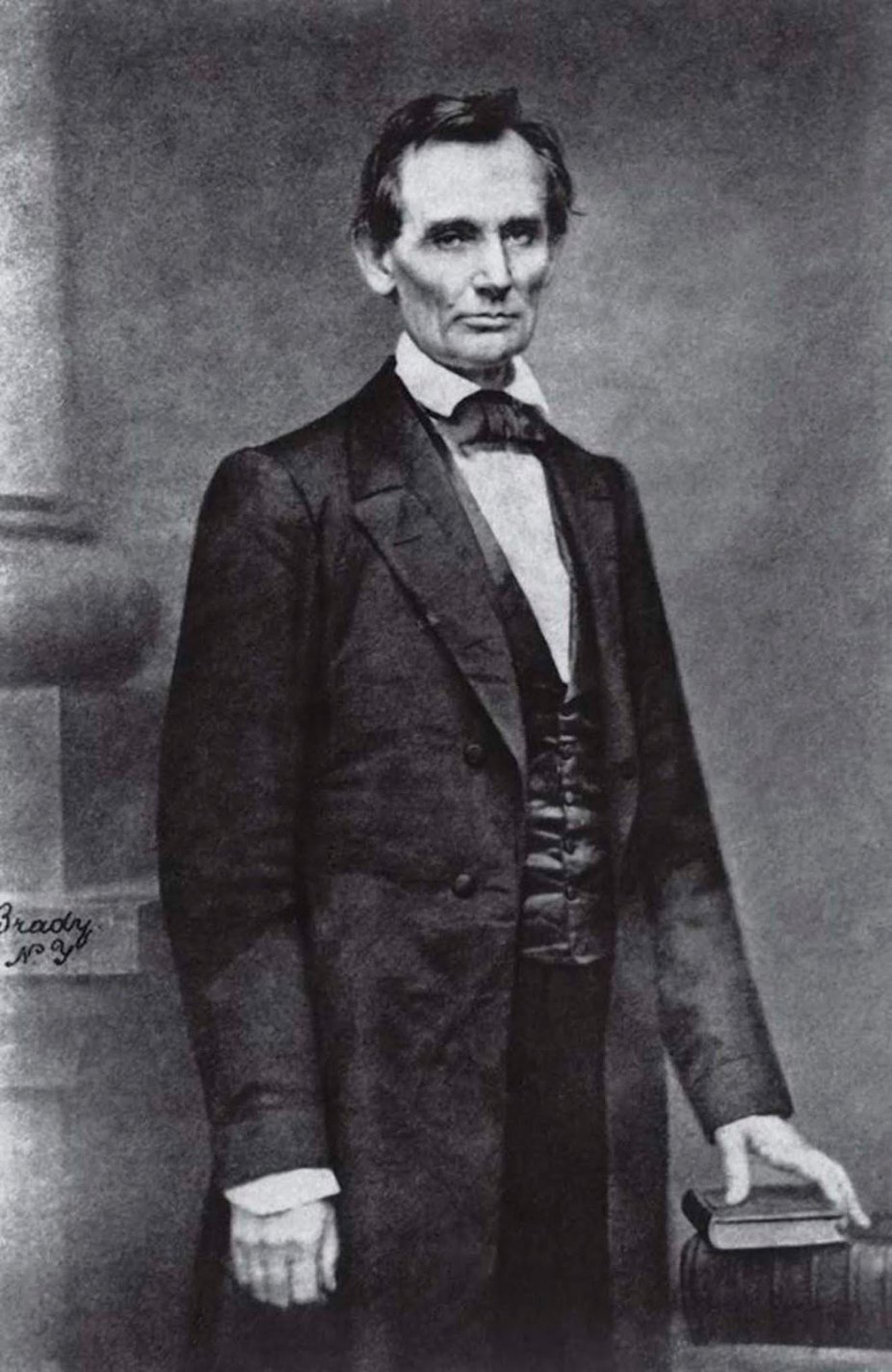
4. Abraham Lincoln, Mathew B. Brady, 1860.
At the moment of taking this photo, Lincoln was not a well-known person. A little bit later, he will make one of his greatest speeches at the Cooper Union and enter the USA’s history. Photographer Mathew B. Brady was already making portraits of famous people, but this portrait made the person famous – it was one of the first photos used in propaganda. During his career, Lincoln many times returned to Brady for new images. As Lincoln later admitted, “Brady and the Cooper Union speech made me President of the United States.”
When admiring Lincoln’s success, such persons as Brady stay in the shadows. Anyway, his contribution to the documenting of the Civil war is one of the largest, that’s why he is known as the father of photojournalism.
If you see the 19th-century photos where people lean on the high table or stand to keep the posture, Brady was the designer of the first one because this piece of furniture is called “Bready stand.”
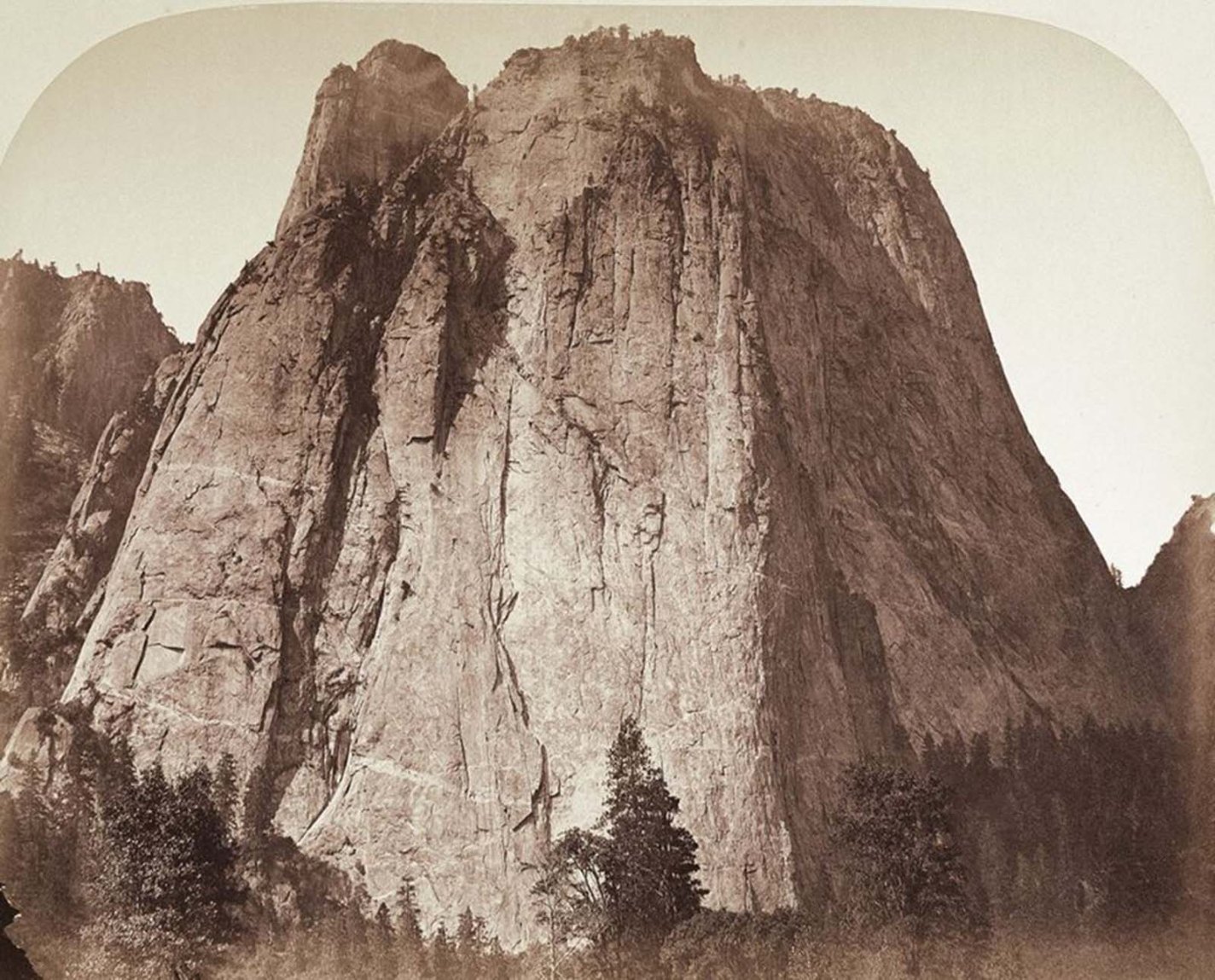
5. Cathedral Rock, Yosemite, Carleton Watkins, 1861.
Yosemite National Park is one of the most beautiful places on the Earth, and since 1864 it is protected by the law, thanks to President Abraham Lincoln. The set of 130 historical photos, made by Carleton Watkins during his visit to this fantastic mountain range. Park was already used as a resort, and these photos were bought by Senator John Conness, who started the protection campaign of the area. Thankfully to this preservation bill, we have the opportunity to see the Yosemite nature as it was centuries ago.
Yosemite was Watkins’ favorite objects, and he did a lot for its popularisation. Even now, his photos are attractive and inspiring to visit Yosemite, and this environmental-friendly tendency also supported the Yosemite Grant. In regard, one of Yosemite’s peaks was named Mount Watkins.
Interesting fact: Carleton Watkins was a talented photographer and a no-good businessman. He didn’t bother about any copyright protection and lost the rights on his photos several times. The ‘Cathedral Rock’ was among other images that were stolen and published by other photographers.
6. The Dead of Antietam, Alexander Gardner, 1862.
Alexander Gardner, the employee of Matthew Brady, was the person who delivered the horror of the Civil War to the general public. The exhibition of almost a hundred photos from the Antietam battlefield, Sharpsburg, Md. was the first time dead bodies appeared in the picture. The notable feature of these photos was the method they were taken. Alexander Gardner and his assistant James Gibson used a new device – stereograph, to capture the moment with a 3d effect. Among 95 photos, 70 were stereo images. The copies of these photographs spread through America and the originals were put on display at Brady’s gallery.
Papers described these horrifying photoshoots as evidence of the massive death of more than half a million people during 1865—fields covered with unburied bodies, results of the arbitrariness of warring armies. Gardner nailed the horrors of Civil war with his combat historical photos.
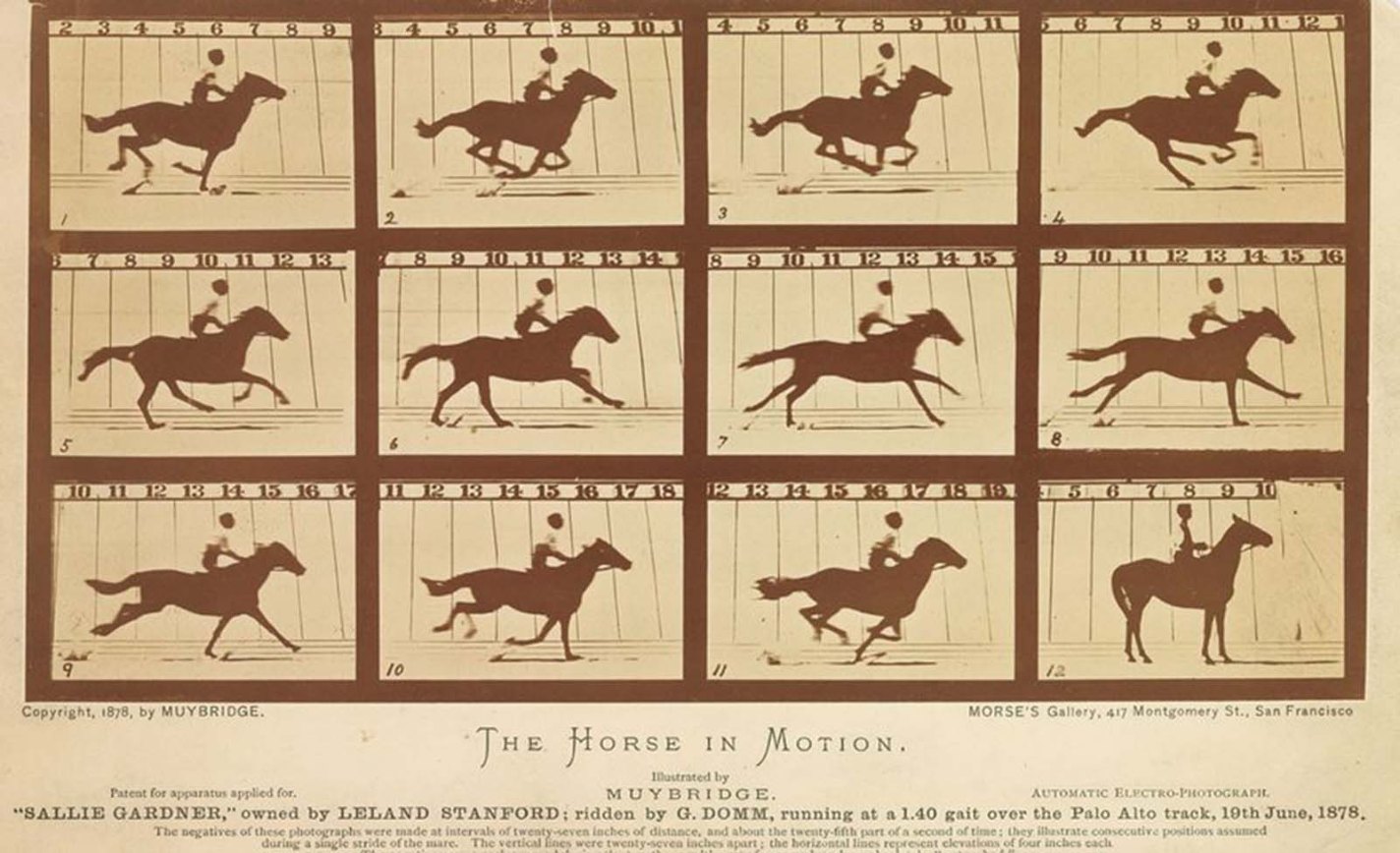
7. The Horse in Motion, Eadweard Muybridge, 1878.
An experimental photo set of Eadweard Muybridge demonstrating the horse movement during running was an ambitious large scale project. It all started from a dispute between the governor of California, Leland Stanford, who claimed that horses during gallop became airborne, and his opponent claimed that at least one leg touched the ground.
There is no chance to catch this moment by the naked eye, as well as by a single photo. So, the government-sponsored the construction of a whole “photo dome” – a long white wall and 12 cabins with cameras. Black horses (for maximum contrast) run a wooden track, alternately triggering cameras and capturing all horse running phases. As a result, Muybridge received 12 shots, and among them were those who recorded the moments when all four legs of the horse were in the air. Animation history starts with this picture.
Lately, he repeated this experiment with 24 cameras and created the first animation in his “zoopraxiscope,” which pushed animation and cinema development.
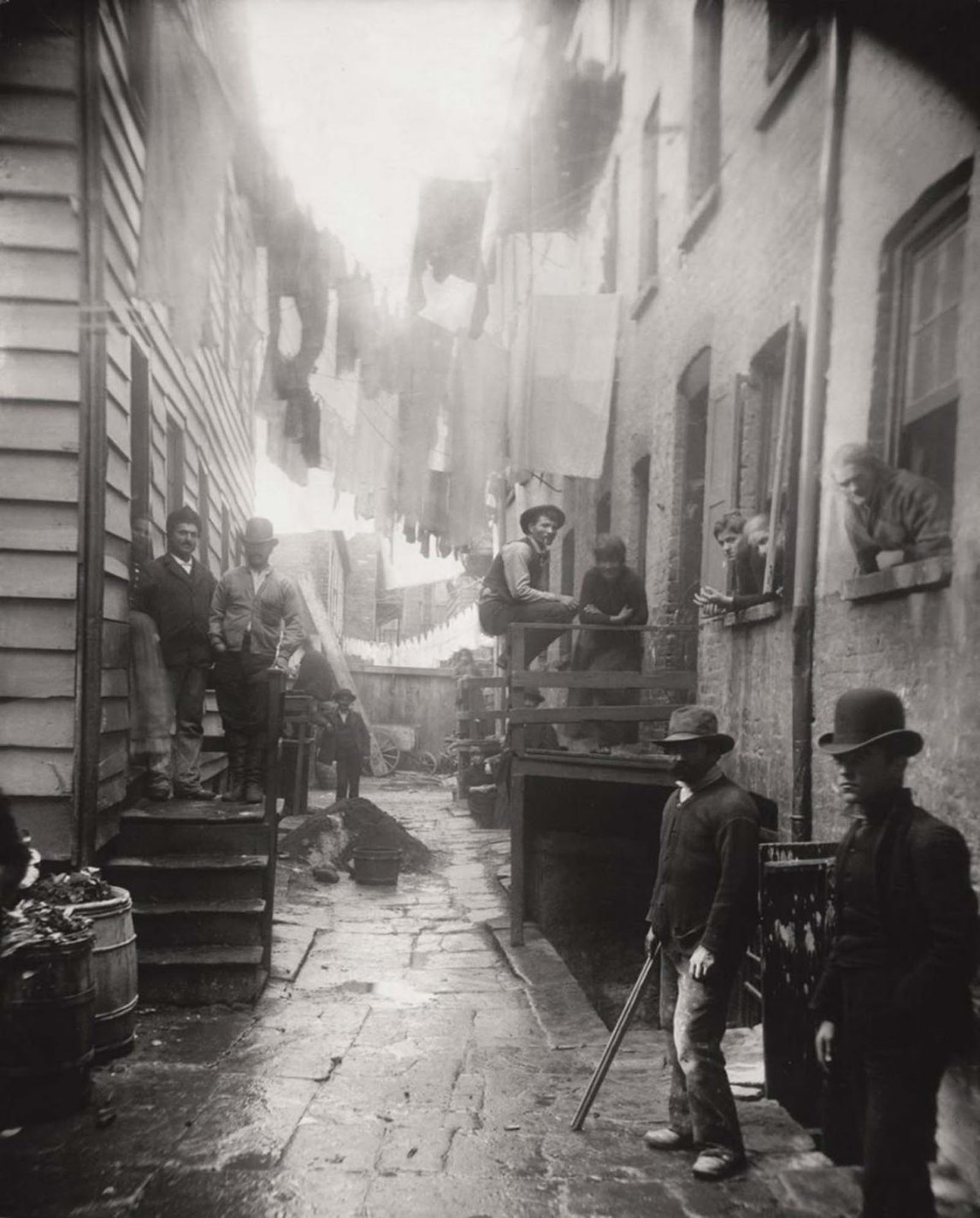
8. Bandit’s Roost, 59½ Mulberry Street, Jacob Riis, 1888.
The end of the 19th century in New York City is called the “Progressive era” – fast growth of the industry, an increase of the population, enlargement of the city line. But this growth had its price. The dream attracted him. A lot of people left for the Big Apple and faced poverty and need. This side of future metropolis life was on the blind spot of society, and Jacob August Riis uncovered the life of poor people in his book “How the Other Half Lives: Studies among the Tenements of New York.” One of the most capturing photos is Bandit’s Roost 59½ Mulberry Street showing the criminal environment’s reality in the slums of the Lower East Side. He captured unknown heroes of the criminal history in one sharp photo.
This work created a basement for a new branch of journalism – “muckraking,” connected brave reporters who unveiled a dirty truth of life.
During the work on the book, Riis was one of the pioneers of flash photography and obtained the ability to take photos in the nighttime.

9. The Hand of Mrs. Wilhelm Röntgen, Wilhelm Conrad Röntgen, 1895.
The first published X-ray image demonstrates Anna Bertha Röntgen, wife of first Nobel laureate Wilhelm Conrad Röentgen. Before proved evidence of X-ray harmful effect, Röentgen images were entertainment and were taken commonly just for fun. Anna was probably the first person Wilhelm told about his great invention, and a few years later, it was widely used for medical purposes. Like many great inventions, this one was made by an accident when Röentgen worked late and found that non-visible rays emitted from Lenard’s tubes can affect the paper covered with barium platinocyanide. Here’s how this photo began a new chapter in medical history. It took seven weeks to study the newly discovered emission, which Röentgen called X-rays.
It is hard to underestimate the meaning of this invention to humanity. While Röentgen refused to patent his results, this method’s availability raised medical diagnostics and treatment on the new level.
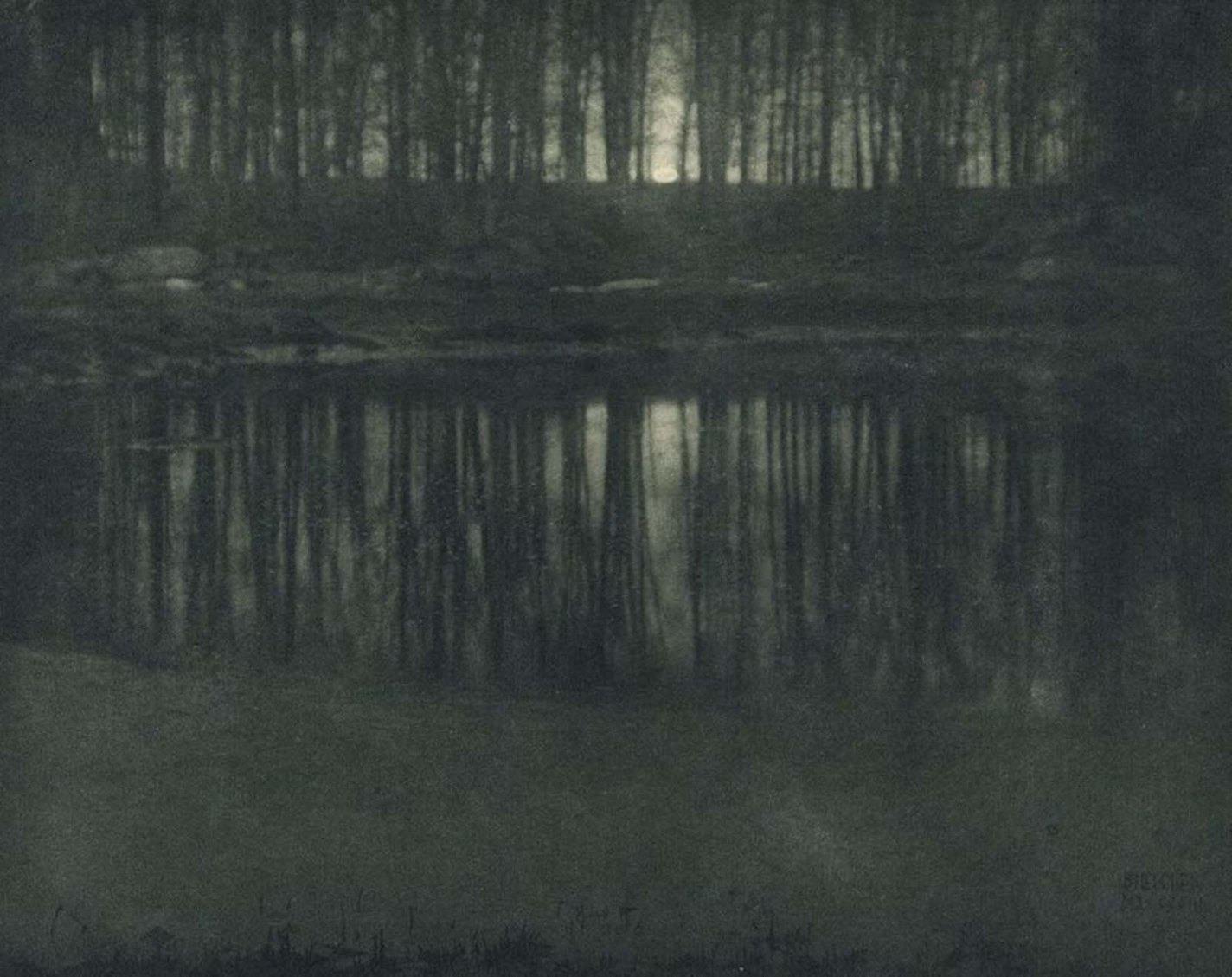
10. Moonlight: The Pond, Edward Steichen, 1904.
The Pond—Moonlight is the most expensive photo ever – it was sold for almost $3 million. For making this photo in 3 examples, Edward Steichen used the gum printing technique. The adding gum dichromate layers to the black-and-white images created a tender picture, the most famous Pictorialist masterpiece. For this movement, photography was instead the piece of art, then just the record of reality, so many pictorialist creations have visible manipulations. In this particular photo, the Moon was added. The movement was popular until new photo techniques with more sharp focus became available, but it influenced the development of photography a lot. The main statement of pictorialism in general and Edward Steichen as an influencer personality was that processing the photo is the same as looking for the scape to capture.
This picture also is in the list of the TOP 10 most expensive photos
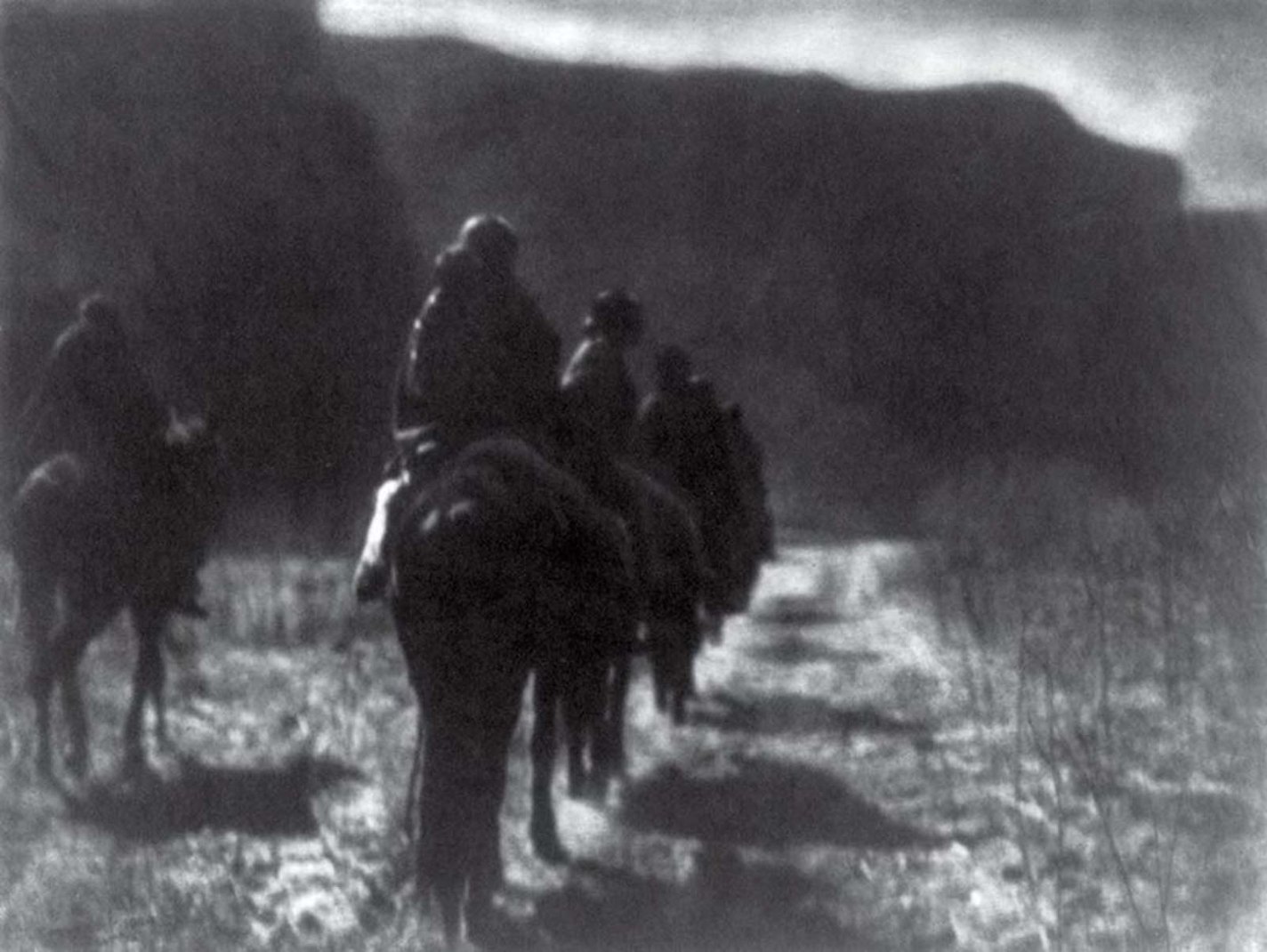
11. The Vanishing Race, Edward S. Curtis, 1904.
The late story of Native Americans is full of sorrow. Whole tribes were erased, evicted in reservations; almost the entire culture stratum was lost. Edward S. Curtis cared about this incident and tried to document as many aspects of Native American’s life as possible. His heritage in 20 volumes of The North American Indian published during 1907–1930 was highly praised.
The attraction of attention to the Native Americans was aimed to improve their status, but it imprinted the cliche of the “vanishing Indian.” This character became a symbol of anachronism, noble savage, and was used to lure tourists. Lately, Edward S. Curtis was criticized for staging his photos and making the image of Indians from a subjective point of view. Anyway, his collection of music and language samples on wax cylinders, the number of photo materials have ethnographic value.
The Vanishing Race image is a signifier of the whole race’s unknown future, symbolizing dark times and a hard road to survive.
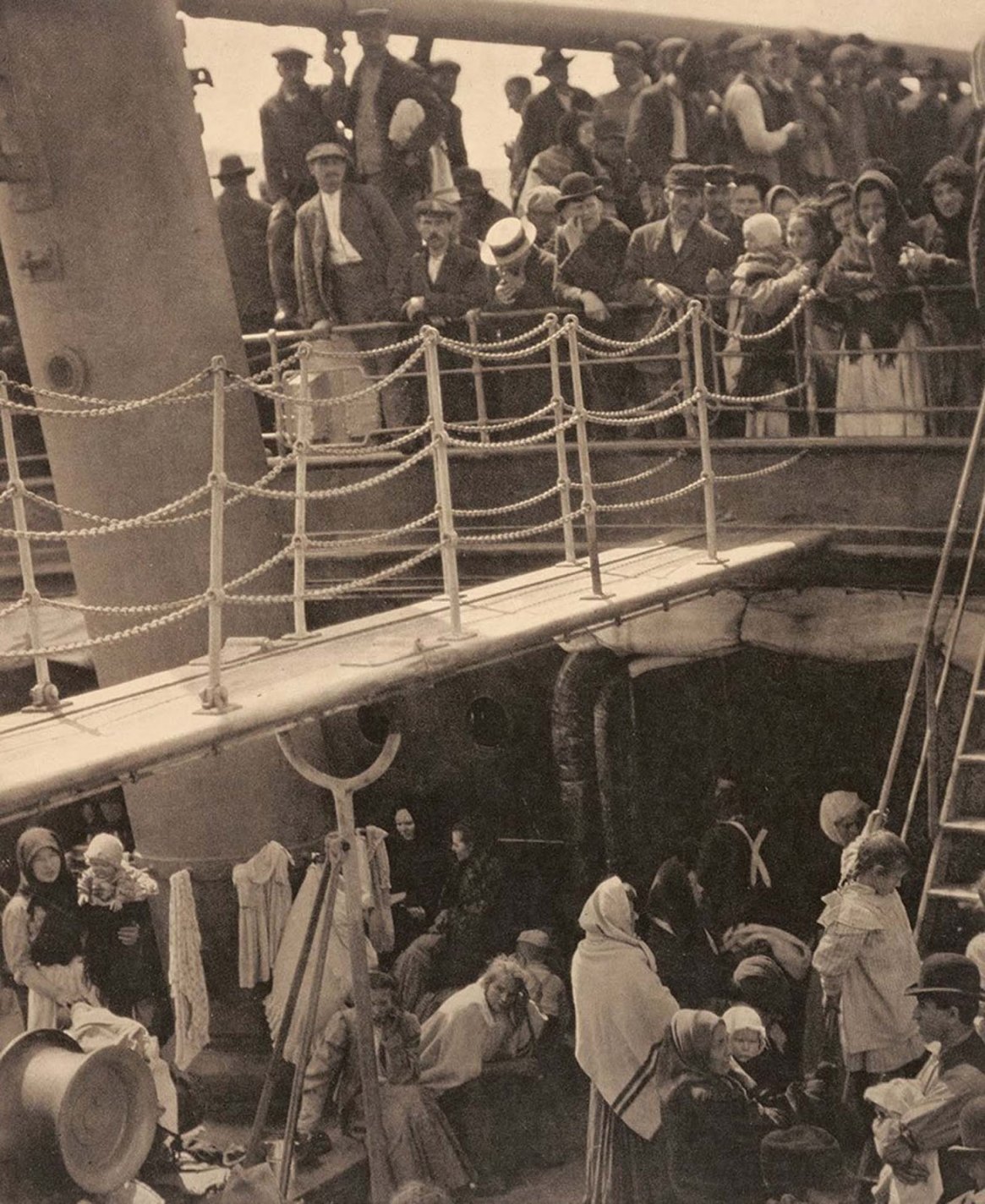
`12. The Steerage, Alfred Stieglitz, 1907.
A full story about this historical photo
Alfred Stieglitz founded the Photo-Secession to promote photography as a form of art in 1902 and became its ambassador. The most notable photo of Alfred Stieglitz depicted workers’ arrival in the lower class of the ship. The Steerage became an icon in photography: it is unique due to its documentary value and, at the same time, is a piece of modernism.
This scene marked a new photography feature – to be an independent form of art, not the way to substitute the painting. Lately, Alfred Stieglitz wrote, “I saw shapes related to each other. I was inspired by a picture of shapes and underlying that the feeling I had about life”, describing this moment, and Picasso admitted that “This photographer is working in the same spirit as I am” when he saw The Steerage, which delivered the atmosphere of that time.
Interesting fact: Alfred Stieglitz was a wealthy man, and he traveled with a first-class during ‘The Steerage’ voyage. While he was exploring ‘the screaming social inequality on the ship,’ a sailor-guard escorted him.
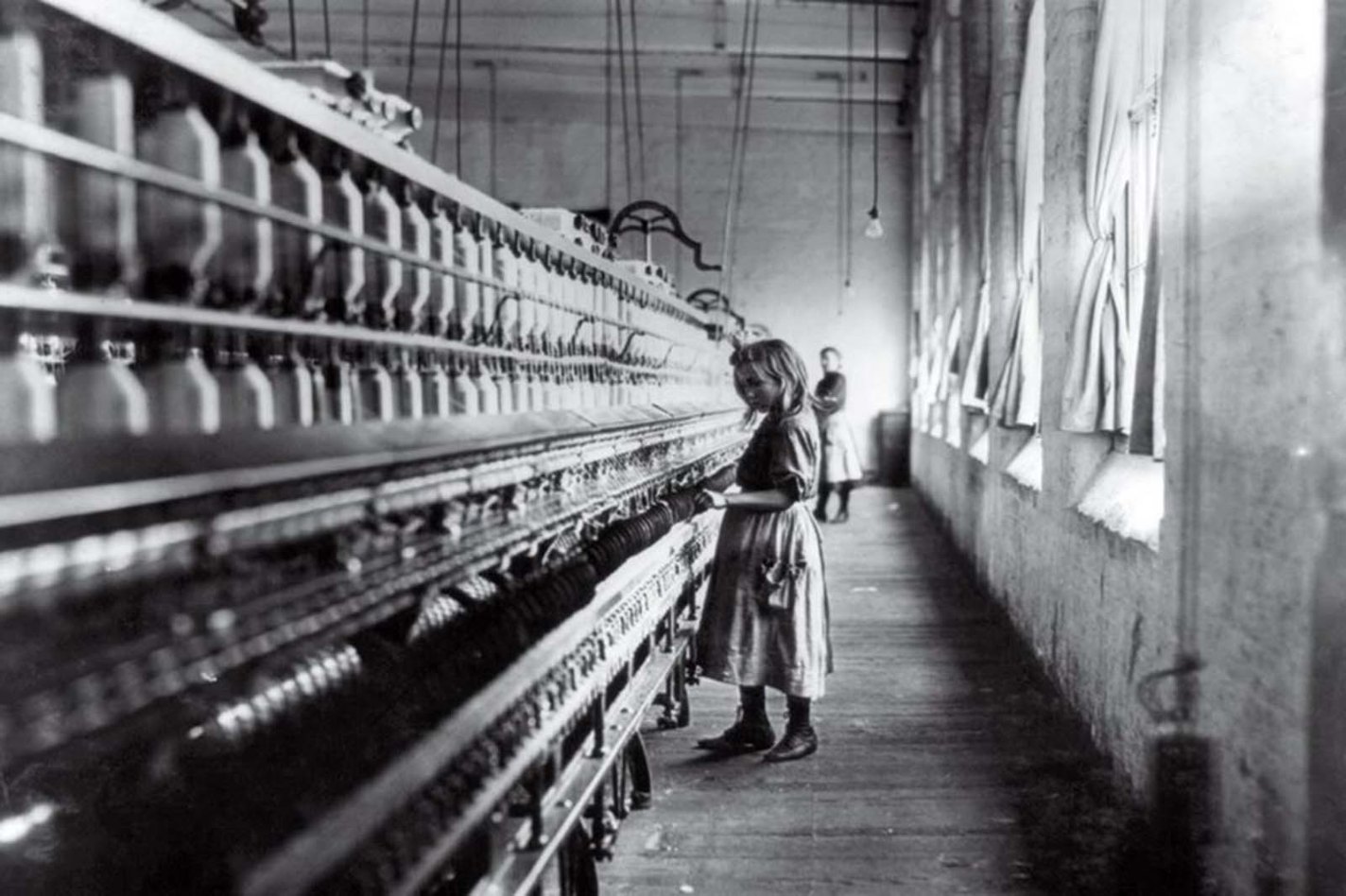
13. Cotton Mill Girl, Lewis Hine, 1908.
Child labor was common in the early 1900s, even being considered immoral. Many manufacturers hid that they use child labor. The newly founded National Child Labor Committee started the campaign against child labor and invited Lewis Hine as a photo reporter. Next ten years, he made thousands of photos of little boys and girls under 16 involved in manufacture with low payment.
His ability to sneak into the most closed factories and mines made him one of the most famous muckrakers. He pretended to be an inspector, vendor, industrial photographer, faced the violence, risking his health to take photos of child labor conditions. Being a documentary photographer, Hine didn’t use any photo editing to show the real picture, and his shots become a great example of influential photography.
Historical photos, like one above, where little Sadie Pfeifer operates a cotton-spinning machine, helped protect youngsters’ rights and fight against child labor.
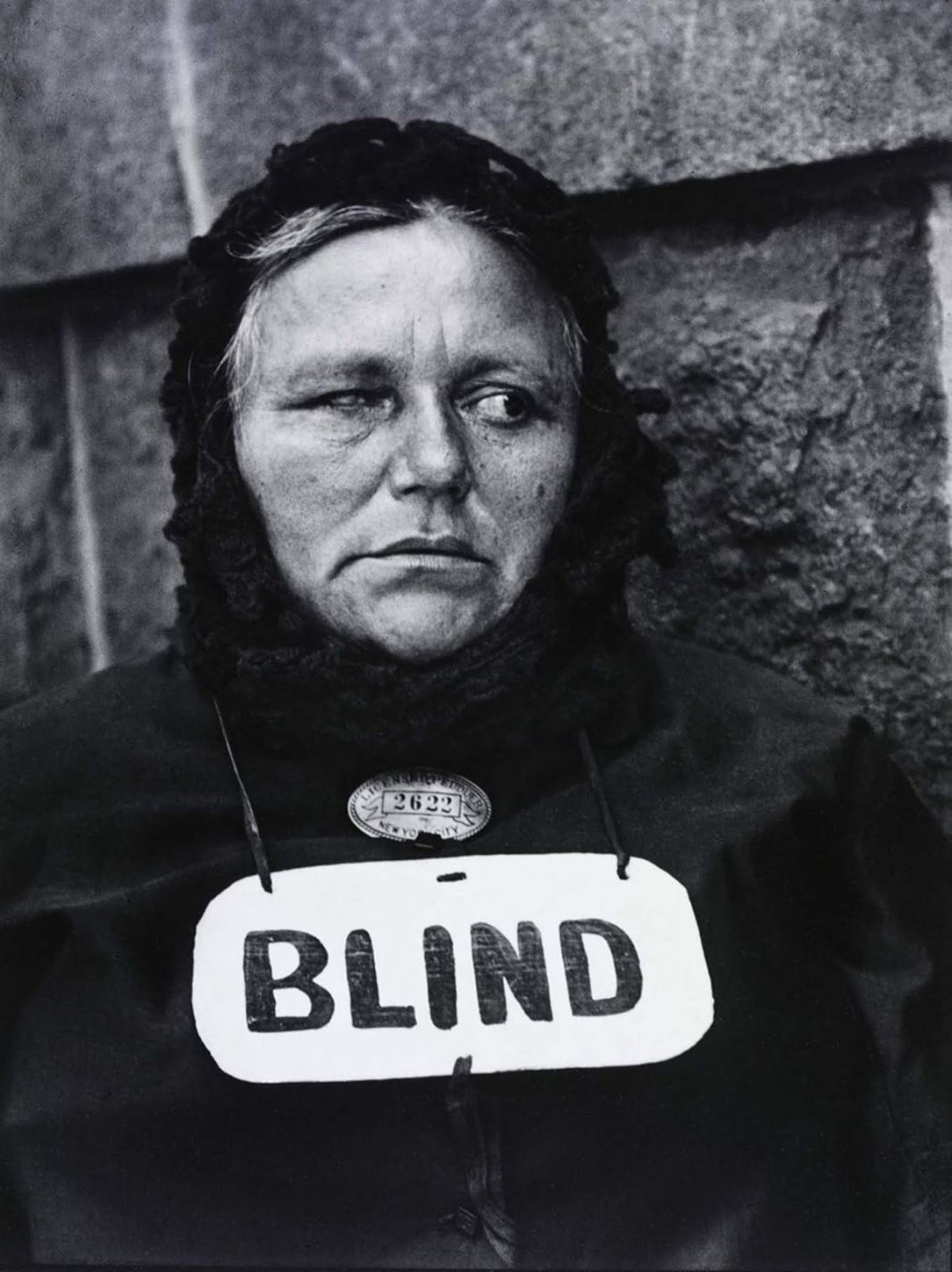
14. Blind, Paul Strand, 1916.
Paul Strand was the first one who started to take street historical photos. He moved aside from posture portraits to unrehearsed peoples’ depiction. His city street portraits imagine random people, mostly immigrants. Like the blind woman who was selling newspapers, models didn’t realize that the artist took pictures of them. Strand’s goal was to capture real expression without posing. So he used a trick – a false lens pointed the other direction than an actual photo lense. He was close enough to other modernist photographers, and this photo was published in Alfred Stieglitz’s magazine Camera Work and thus became a part of history. Strand’s portraits marked another tendency – a humanistic documentary.
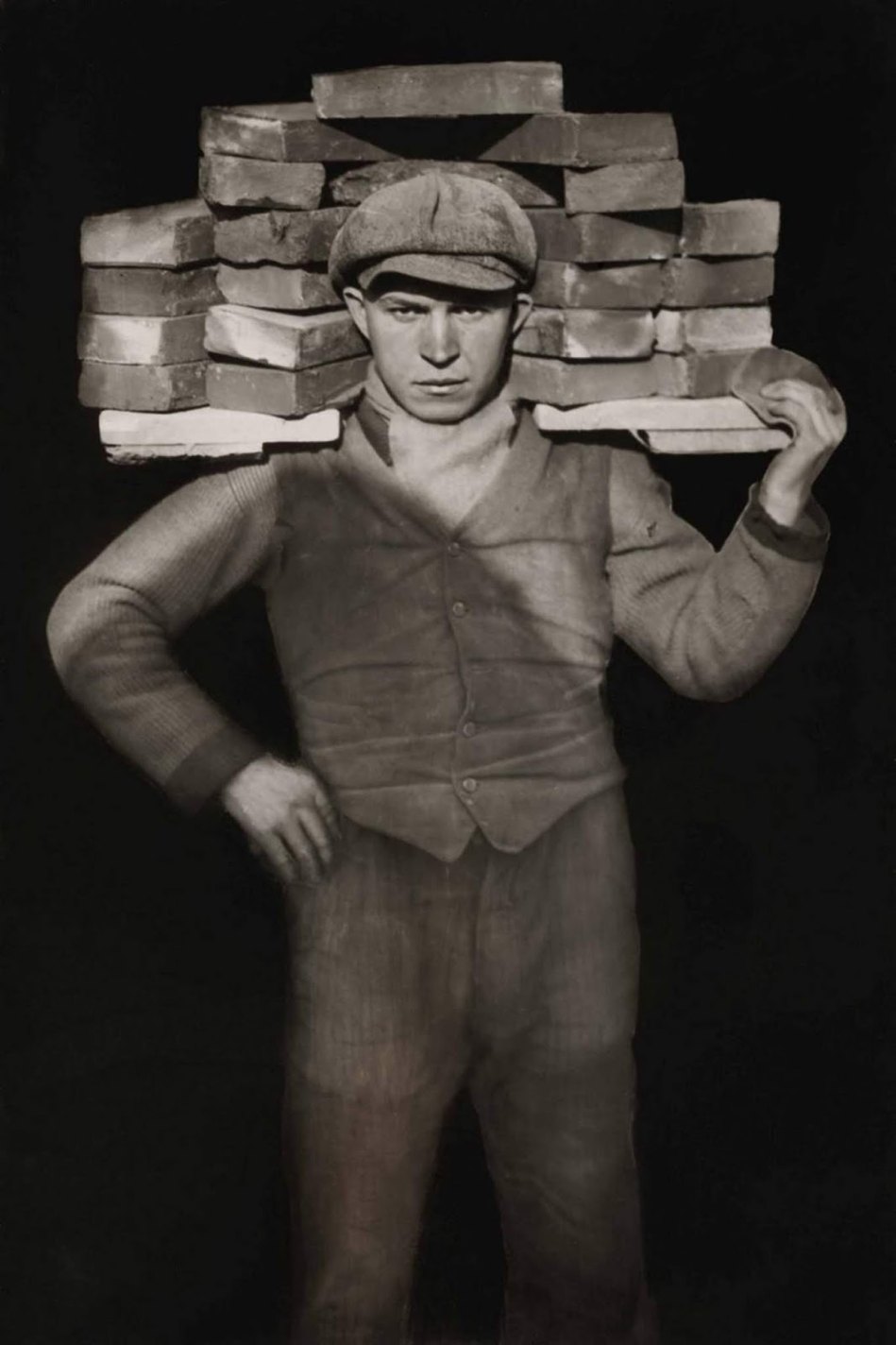
15. Bricklayer, August Sander,1928.
A full story about this historical photo
August Sander is famous for his attempt to document German people’s lives in his “People of the 20th Century” portrait series. At first, photography was his hobby, but soon he opened his photo studio in Cologne. Under the influence of his friends from Neue Sachlichkeit, or New Objectivity movement, he started an ambitious project – series of German people portraits of different social strata. In his photo, he marked the surrounding and professional peculiarities of each person. The Bricklayer is one of the most well-known due to the sharp historical photos and very modern exposition. The project’s goal was to show the connection between appearance and profession on one side and all people’s likeness on another. As a result, now we have an almost encyclopedic gathering of German people typology, which made August Sander a remarkable and influential figure of the 20th century.
Interesting fact: August Sander photographed only Germans for his “People of the 20th Century” series. Does it mean that he shared the nazi race superiority concepts? No, he never admitted that. Moreover, his son died in a concentration camp for his Socialistic party membership.
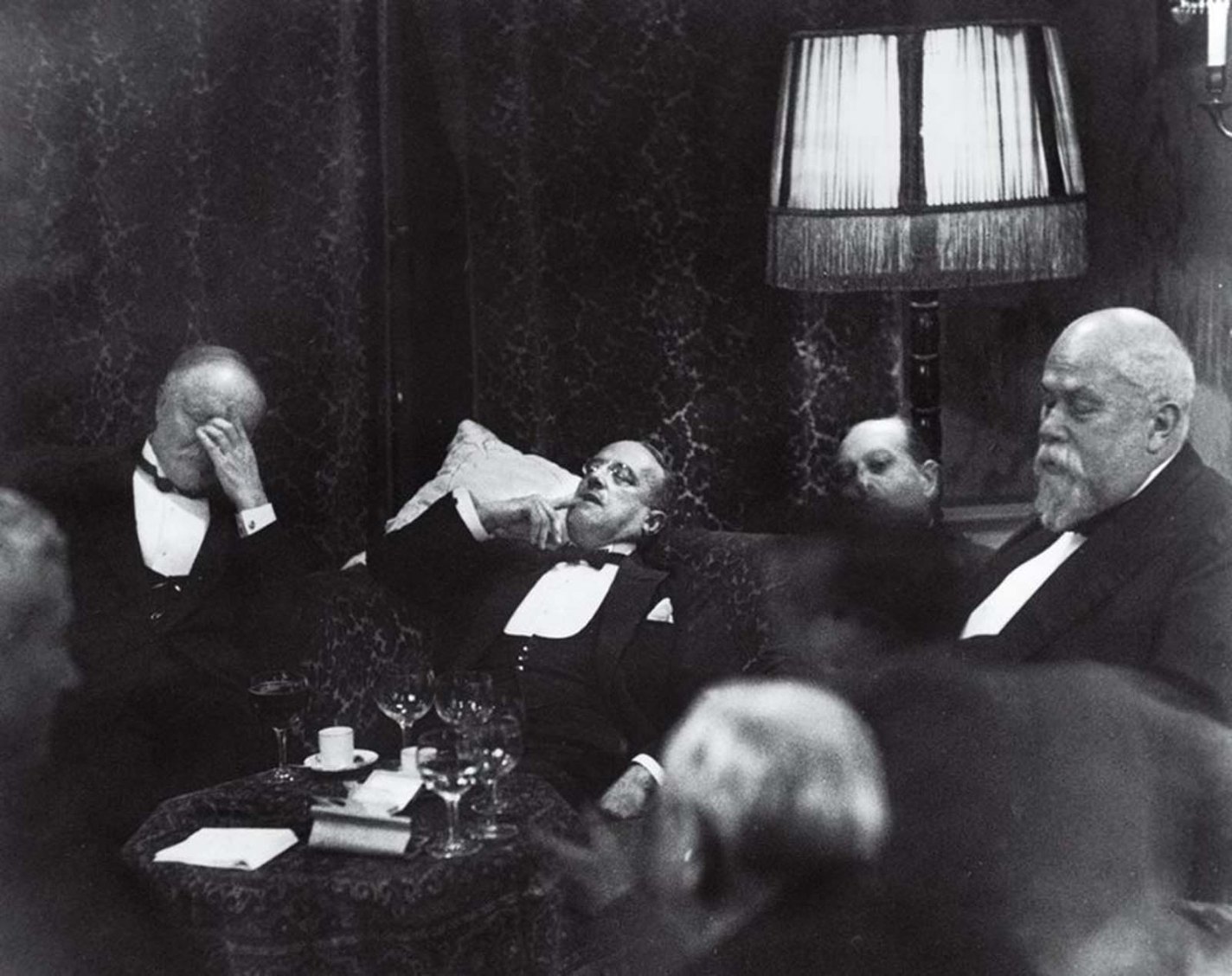
16. The Hague, Erich Salomon, 1930.
A full story about this historical photo
Politics is a public arena, but most crucial and essential occasions often take place in couloirs. Erich Salomon uncovered to broad mass how the fate of countries is decided. His photos from negotiations in the Hague, 1930 made a sensation – the first time the backstage of politics was documented. 2 a.m., tired out after a long day Ministers, surrounded by smoke and empty glasses, didn’t notice Solomon with a small camera. During his career, he created many methods to hide cameras in hats, cases, and books; he used the newest light-sensible devices to make quality photos of famous people in an informal atmosphere. His pictures brought his fame all over Europe and the USA and started a new trend of photojournalism. Solomon captured the critical moments of European states with his historical photos.
Interesting fact: Erich Salomon acted as a paparazzi. None of these politics expected him to take this photo at 2 a.m.
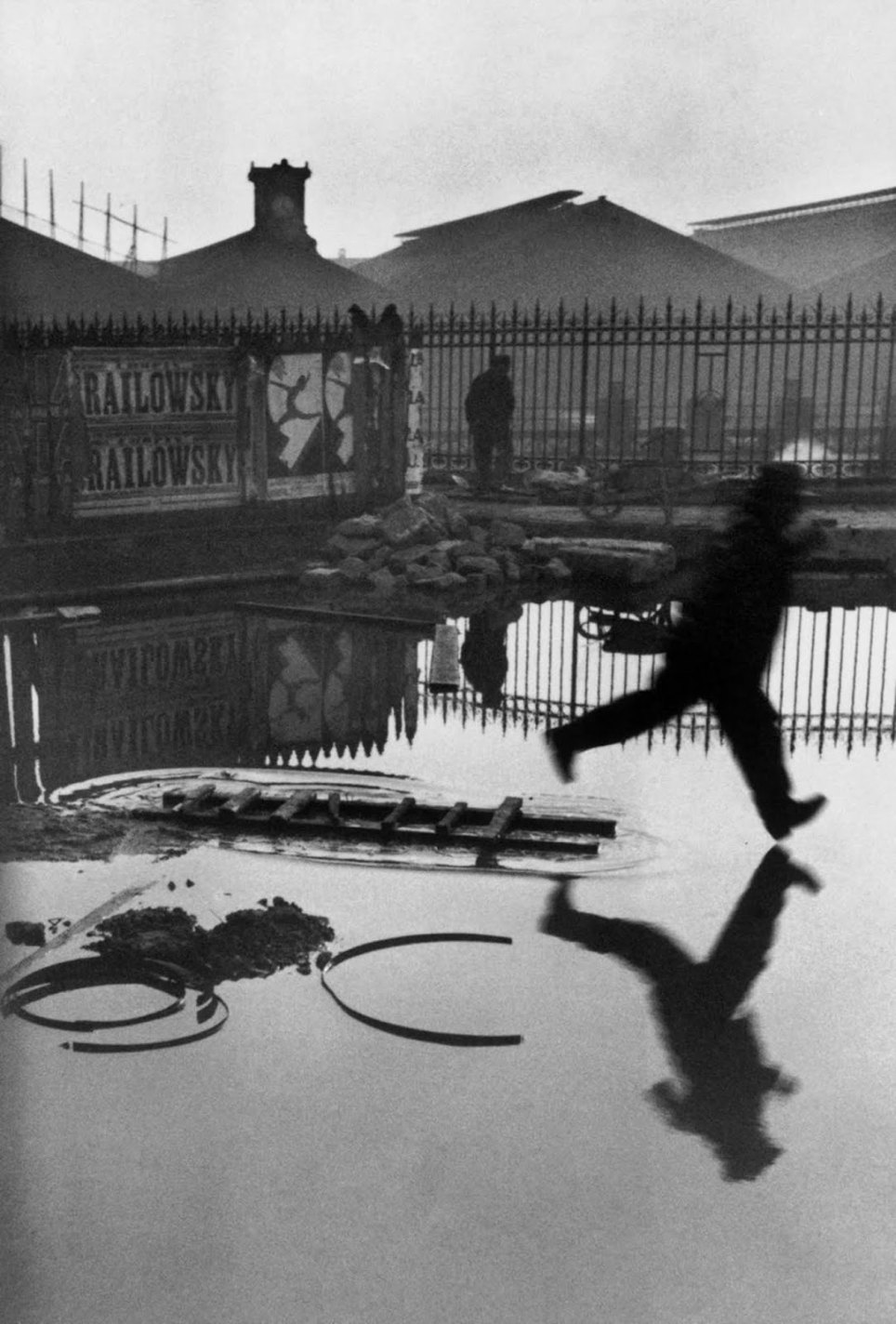
17. Behind the Gare Saint-Lazare, Henri Cartier-Bresson, 1932.
Henri Cartier-Bresson is one one the pioneers of street photography. His images are remarkable for capturing “a decisive moment” – a moment of the most significant emotional tension and impressive visual sense. As he described, «instant recognition, in a split second, of the significance of what is happening and at the same time precise organization of forms, which give this event expression corresponding to it.» Due to such an attitude for timing, the whole modern trend formed – to catch the right moment.
Cartier-Bresson himself was a remarkable figure of the 20th century in the photography sphere who started many traditions. The interesting one is to check the lens features by taking photos of ducks in the nearest park or to take spontaneous pictures on the streets.
Interesting fact: Henri Cartier-Bresson used to say that ‘Behind the Gare Saint-Lazare’ image was unstaged. You should have a leprechaun luck to capture a moment of this kind with camera capabilities of the mid-30s.
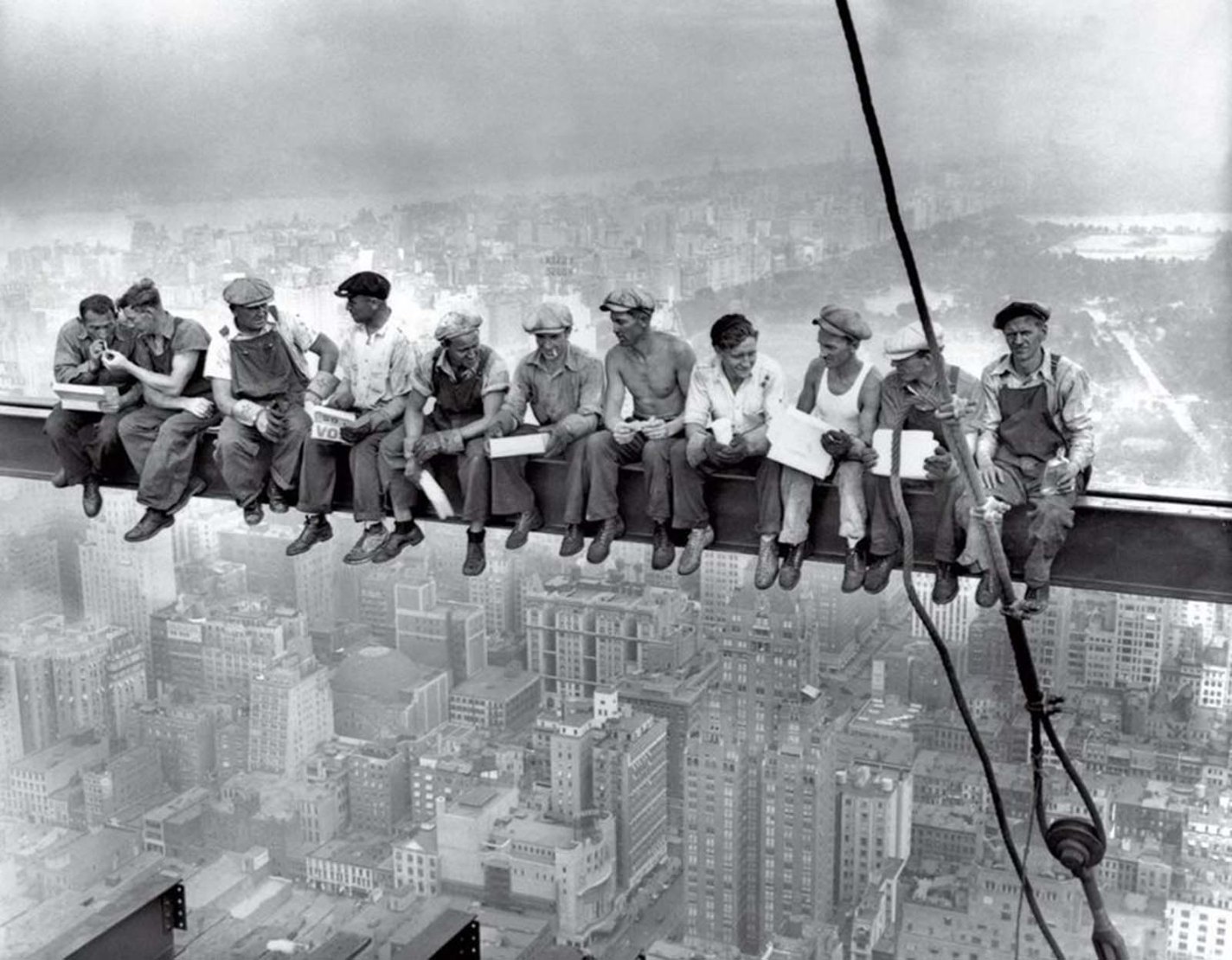
18. Lunch Atop a Skyscraper, Unknown, 1932.
Photo of the workers’ lunch during Rockefeller Center construction became one of the symbols of New York City. At the times of the Great Depression, this photo stated the strength and hardness of workers. Many rumors and mysteries are surrounding this photo: the author is unknown despite efforts of private detectives to find him; the personalities of only two workers are identified, the only information that they mostly were immigrants; there is no evidence was this photoshoot dangerous or there was some protection from falling from the height of 840 feet and so on. The photo was taken on the 69th floor; the real workers are depicted in comfy positions as they did it every day. Even knowing that the set was staged as a publicity campaign of the complex, it is still iconic and claimed as the most sold photo from the Corbis photo agency. Here’s how this image became one of the best-known historical photos.
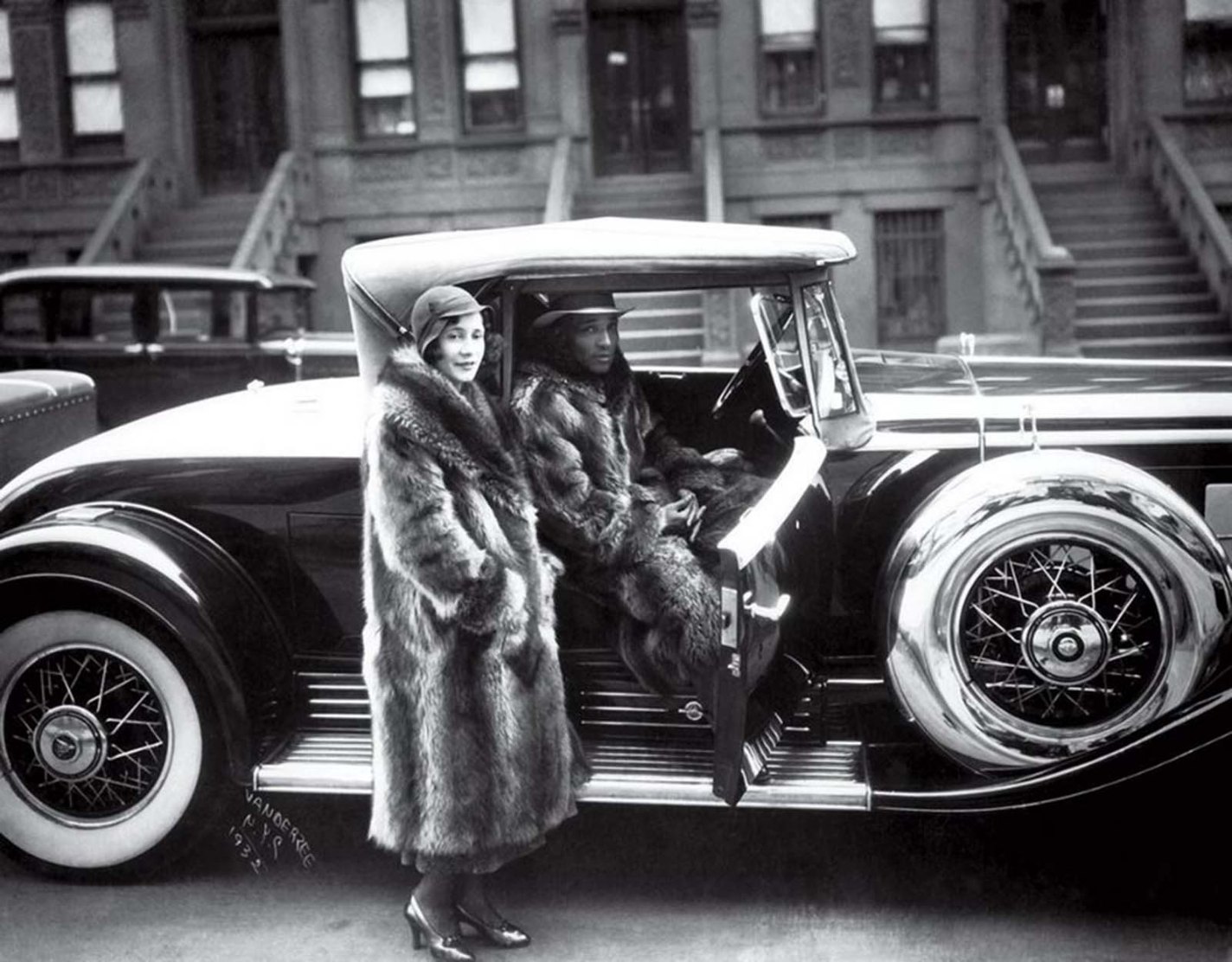
19. Couple in Raccoon Coats, James VanDerZee, 1932.
Harlem Renaissance raised African-American culture despite racial segregation and intolerance against people of color, and James VanDerZee was its chronicler. He mostly portrayed the life of middle-class black people on different occasions and created a stack of documentary photos of this social layer. Also, he made images of Harlem Renaissance iconic figures – Marcus Garvey, Bill “Bojangles” Robinson, and Countee Cullen.
He tried to overcome the stigmatized vision of black people, formed at those times by taking stylish and beautiful pictures full of pride and honor in his studio and outside. Nowadays, his works are held in many museums and exhibitions and are used to illustrate the modern vision of victorian portrait traditions – very staged, plenty retouched, quite idealized. One of these historical photos, where a young African-American couple posing with the car in fancy raccoon coats, is considered VanDerZee’s most famous masterpiece.
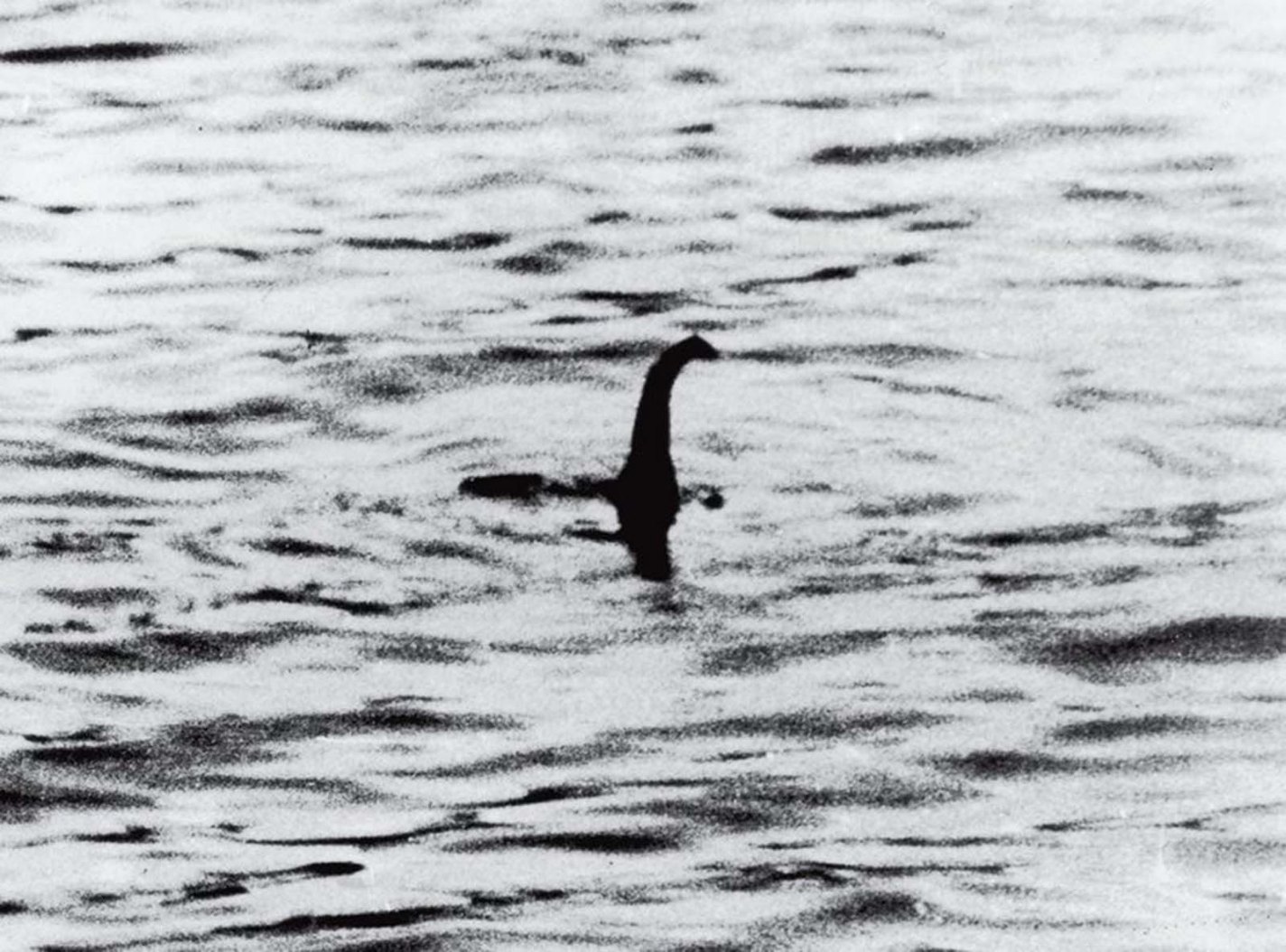
20. The Loch Ness Monster, Unknown, 1934.
Mythical creatures appeared in folklore during humanity’s whole history, but The Loch Ness Monster was the first one, captured on photo. The “surgeon’s photo,” attributed authorship by Robert Wilson, demonstrated the head and the neck of Nessie – for sixty years served as a proof of monsters’ existence. Even after it was considered a hoax, it is still used by conspiracy theorists.
While mystifications were popular since the rise of photography, and it wasn’t something new, people wanted to believe that the depicted monster is real. One single photo has launched extensive scientific research of the lake and attracted tourists to the Loch Ness. The commercialization of the Loch Ness Monster’s image affected life in the region and became a reason and basement for further mystifications.
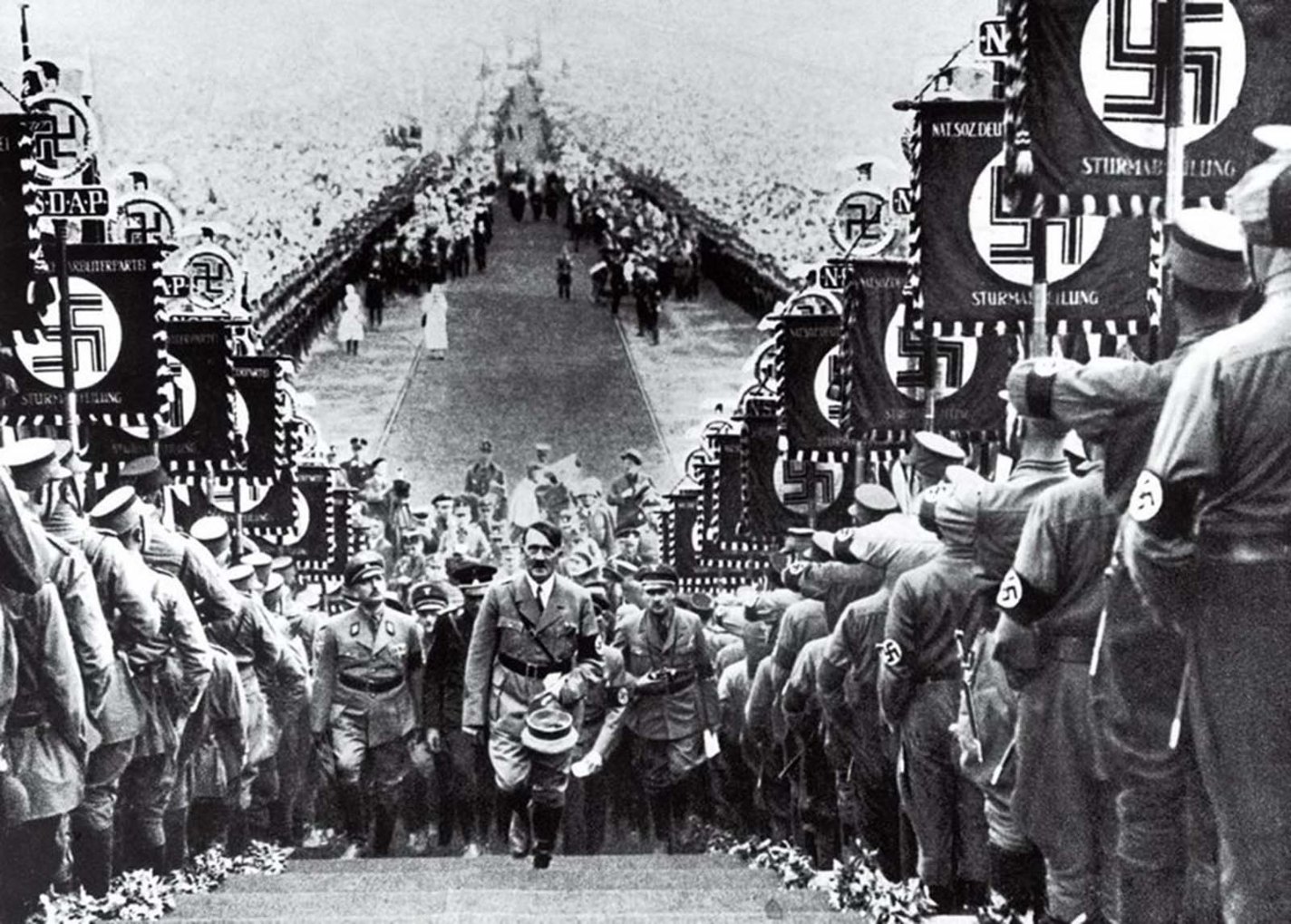
21. Hitler at a Nazi Party Rally, Heinrich Hoffmann, 1934.
Powerful propaganda was one of the reliance of the Nazi regime in Germany. To use this tool in politics, Hitler needed dramatic visual materials. Heinrich Hoffmann, Hitler’s official photographer, provided such historical photos on an industrial scale. Through his talent, he demonstrated fuhrer as the atlas of the German nation, a mighty ruler, bringing pride, glory, and wellness to people. Triumph of the Will and beautiful Hoffmann’s photos made during the 1934 Nazi Party Congress, was used for the next decades to keep the public’s attention to the positive sides of the Nazi regime. This image is an iconic example of how professional photography can make whole masses adore and believe in a terrific ideology—the tipping point of human history in a single photo.
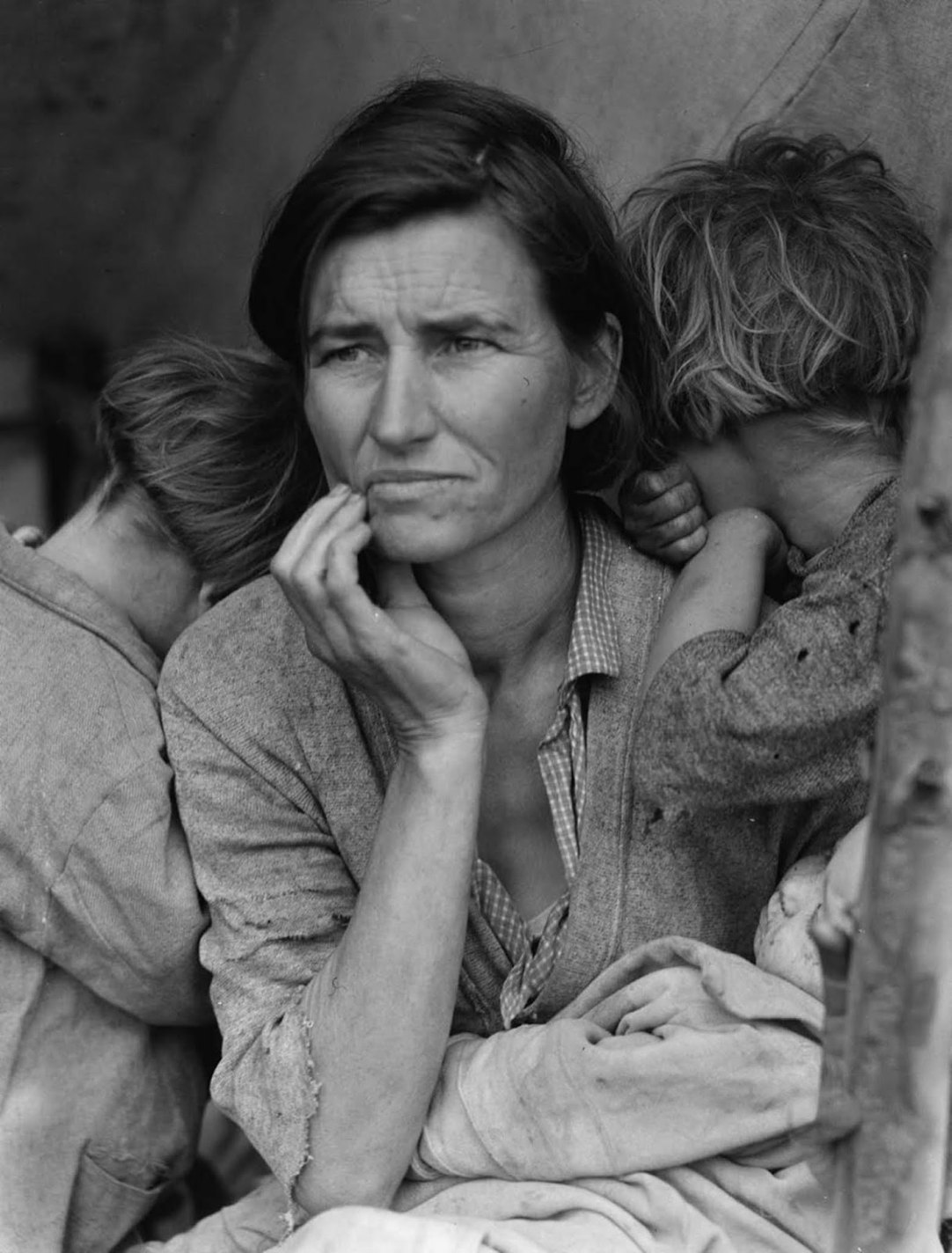
22. Migrant Mother, Dorothea Lange, 1936.
The migrant mother delivers the spirit of the Great Depression-era – desperate woman holding her children in Nipomo camp. Only after 40 years, the person’s identity was established; she was the mother of 6, Florence Owens Thompson. This photo had a very pronounced impact on the situation in the camp, where pea-pickers found shelter. After publication, authorities sent food, but Thompson’s family was already far away in their search for a job.
The story behind the photo is controversial – the Lange version differs from the memories of one of Thompson’s sons, but it had a continuation. In 1983, at the age of 80, Florence was hospitalized, and her fame as the Migrant Mother helped her family deal with medical bills.
As for Lange, the Migrant Mother brought her fame and recognition, and the photo itself became a part of photography history.
Interesting fact: Florence Owens Thompson wasn’t a migrant at all. She was a Cherokee, Oklahoma-born. It seems that Dorothea Lange gave this photo name by mistake.
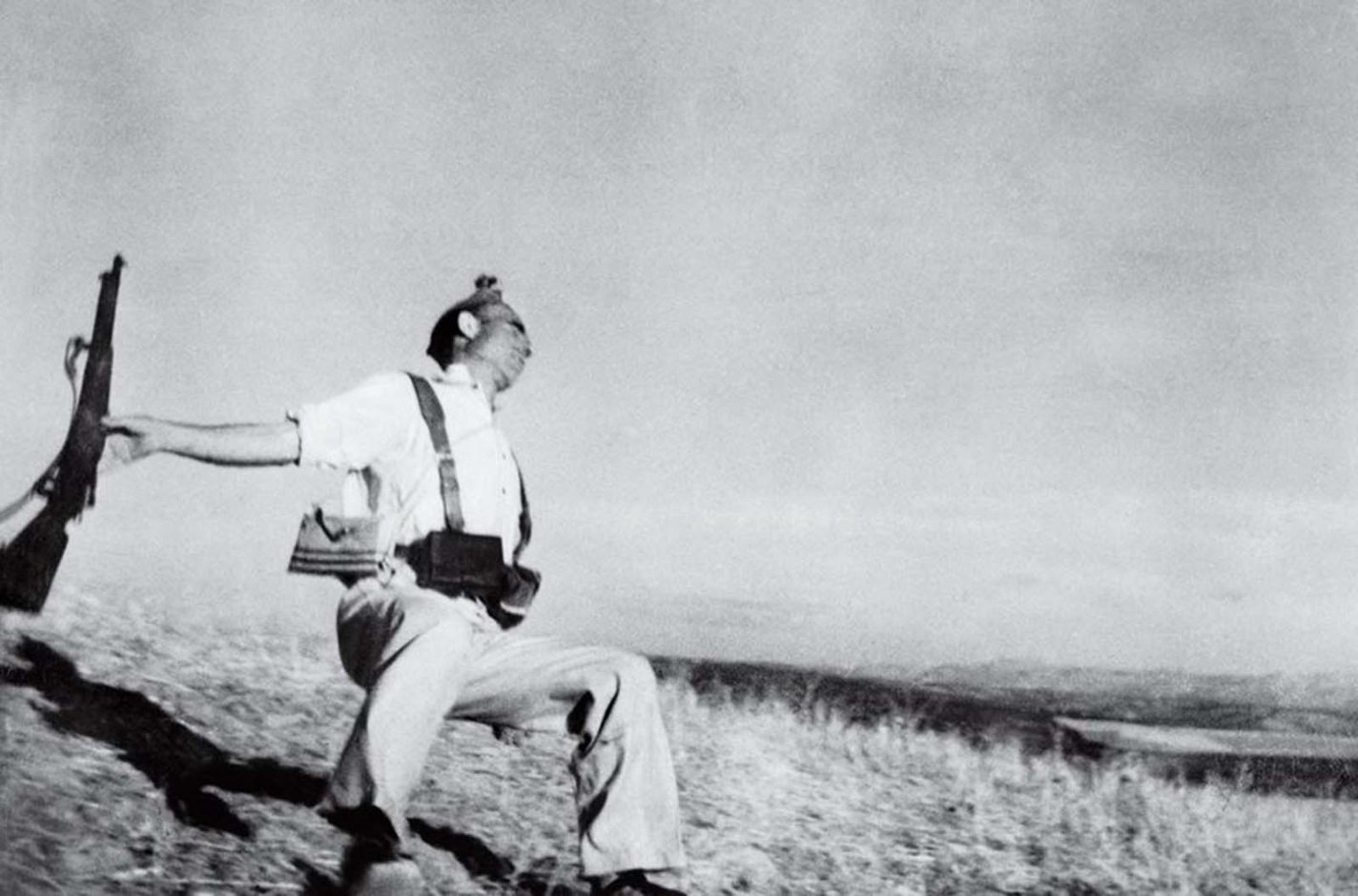
23. The Falling Soldier, Robert Capa, 1936.
A full story about this historical photo
The Falling Soldier photograph caused many authenticity debates due to the differences in the actual location and place described by Robert Capa, how the soldier dies (from the single bullet or machine-gun fire), was it staged, and many other photos from the Spanish Civil War period. Cappa claimed that it was taken blindfolded, and accidentally, many critics and journalists investigated its story and incriminated Cappa in staging. The theory that his historical photos were pre-staged and a soldier died because of it appeared. Nevertheless, was it staged or candid, this photo is one of the most recognizable war photographs. The moment of milicianos death, captured by Robert Capa, was widely spread by newspapers and magazines, such as Vu and LIFE, but the print itself is unique. In 2007, when the “Mexican Suitcase” with most of Cappa’s negatives became public, The Falling Soldier negative wasn’t there.
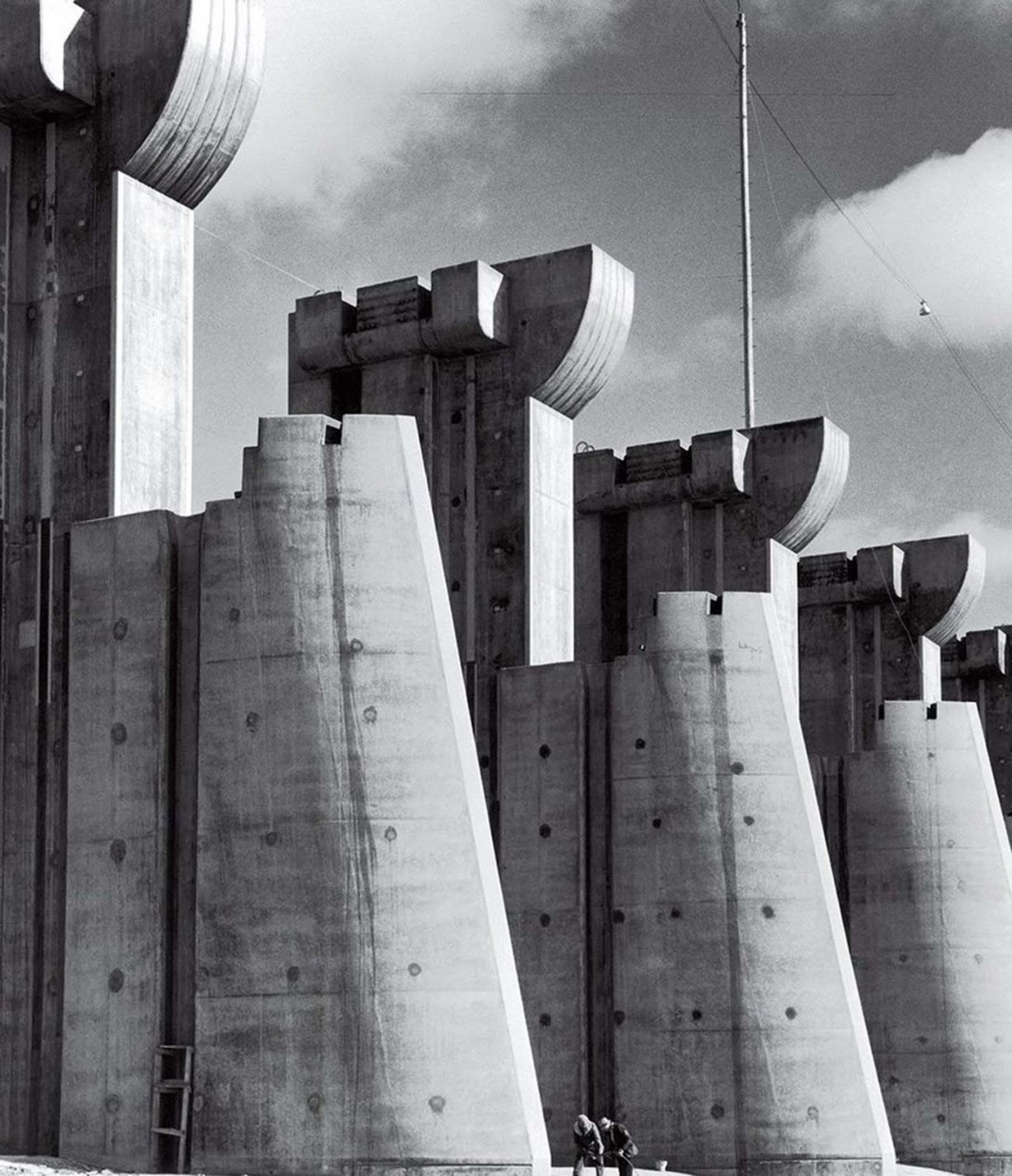
24. Fort Peck Dam, Margaret Bourke-White, 1936.
A full story about this historical photo
The first issue of LIFE magazine is marked with a majestic photo of the colossal Fort Peck Dam. It set the trend in industrial photography and was used for postage stamps, bringing both the dam and Margaret Bourke-White fame. She was the first American photographer to take photos in the Soviet Union and early LIFE’s female photojournalist.
The dam was constructed with several failures, but successfully implemented, and started to produce electricity in 1943. The noticeable photo of Bourke-White made it a symbol of the industrial power of the 20th century, yet unseen in human history.
Interesting fact: Margaret Bourke-White is one of the two photographers who have two images on this list of the Most important historical photos.
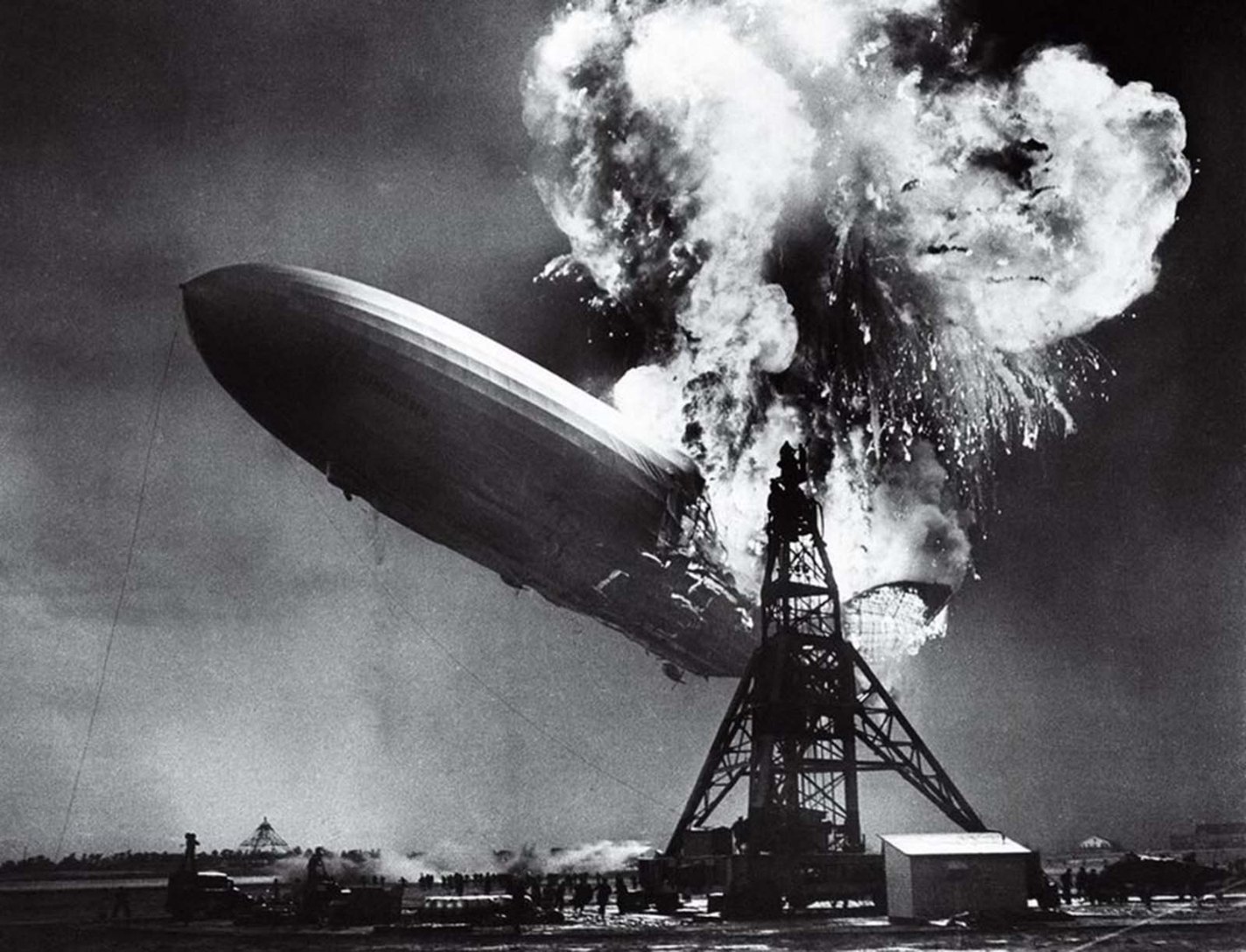
25. The Hindenburg Disaster, Sam Shere, 1937.
The period between I and II World Wars was the golden age of airships. The Hindenburg made 63 long-distance flights and was the biggest airship at those times.
Its habits were adapted to helium usage, but veto for it’s export from the USA to Germany forced Zeppelin to use flammable hydrogen. Dozens of photographers captured its last flight, but the Sam Shere’s photo, printed in LIFE, became the nail in the coffin of airship popularity. At that time, airships were safer than any other skyship, but public resonance after the Hindenburg Disaster and 36 people’s death shifted the vector in air transport development. One of the earliest sky catastrophe historical photos caused a very strong influence on popular culture in the next decades.
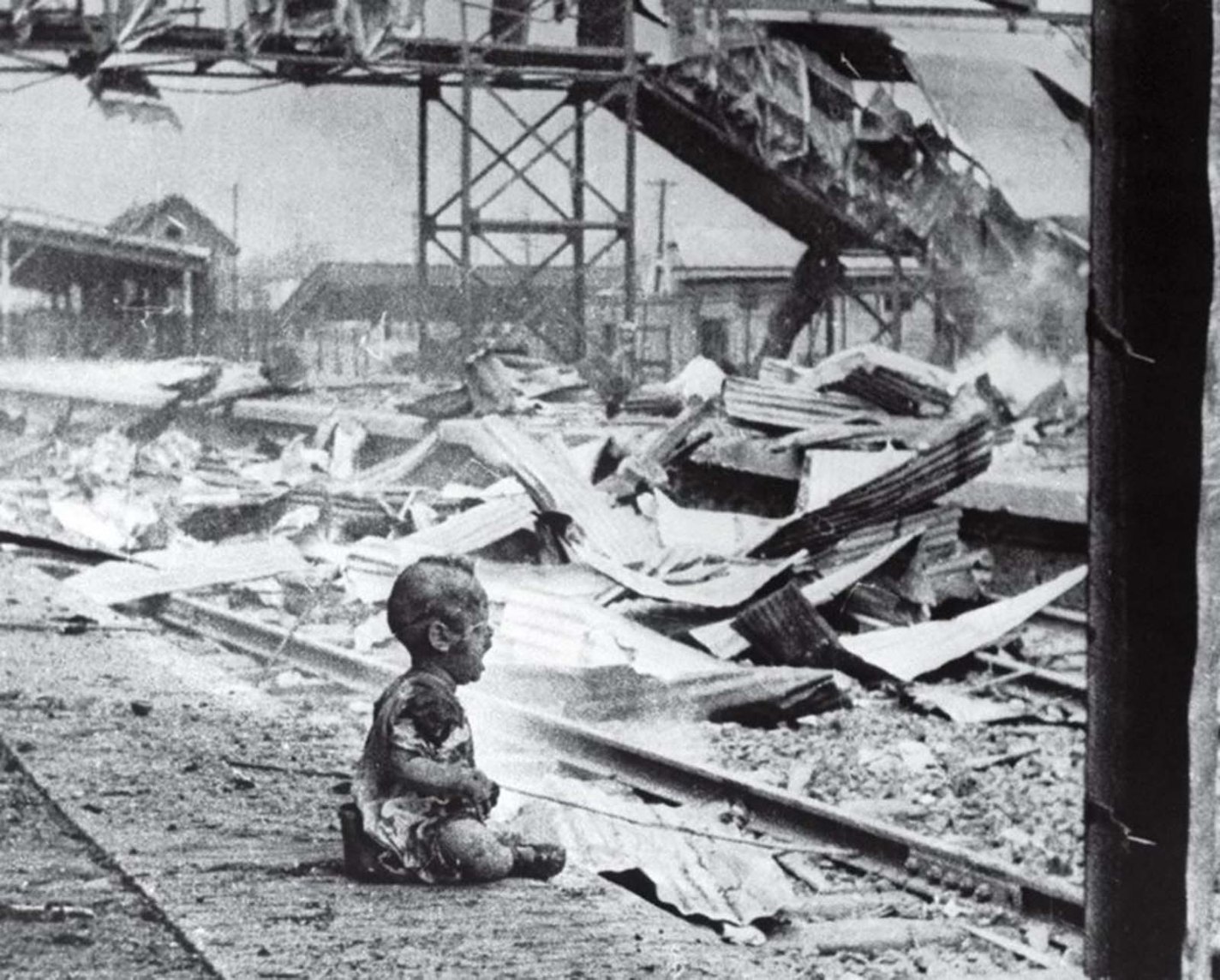
26. Bloody Saturday, H.S. Wong, 1937.
Territorial and national conflicts were worldwide during the first half of the 20th century. While Europe was in-between wars, Japan attacked China several times. While it was far away from western society, it wasn’t even noted by most countries. After Japan dropped bombs on Shanghai South Railway Station, the photo of crying Chinese children changed the situation a lot. Firstly published in LIFE, October 1937, reprinted by many other papers and magazines, exposed to 136 million people, it got its legacy. As a result of one single photo, the USA, Great Britain, and France provided help to China. Instead, Japan acquired epithets “butchers” and “murderers,” used in anti-Japan propaganda during World War II.
For this photo, the Japanese government set H. S. Wong’s head’s price claimed picture staged and manipulative to prepare Western society to the war with Japan, but history remembers. Was it so or not, but Bloody Saturday is the fist photo document of bloodbath against civilians in international conflicts.
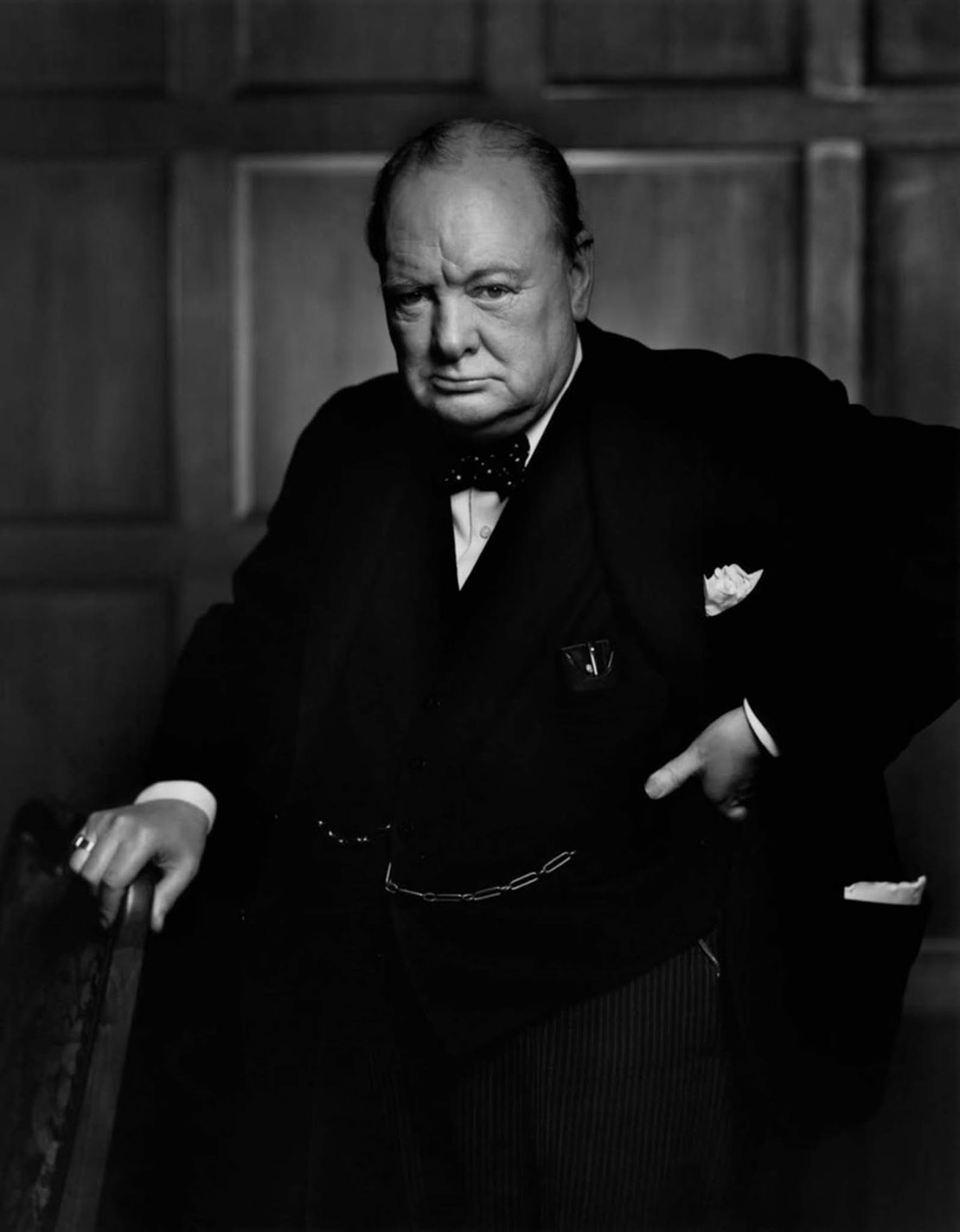
27. Winston Churchill, Yousuf Karsh, 1941.
The photo was taken during Churchills’ visit to the Speaker of the House of Commons’ chamber in the Canadian Parliament in Ottawa. The name of the picture, given by the author, is “The Roaring Lion” – at the moment of a photoshoot, Churchill said, “You can even make a roaring lion stand still to be photographed.” To make Winston Churchill look like the country’s leader in war, Yousuf Karsh took out a cigar from the Prime Minister of the United Kingdom and captured his aggressive posture and facial expression. USC Fisher Museum of Art described it as a “defiant and scowling portrait [which] became an instant icon of Britain’s stand against fascism.” This iconic Churchill portrait brought Karsh fame, and during his long career, his historical photos appeared as LIFE cover 20 times.
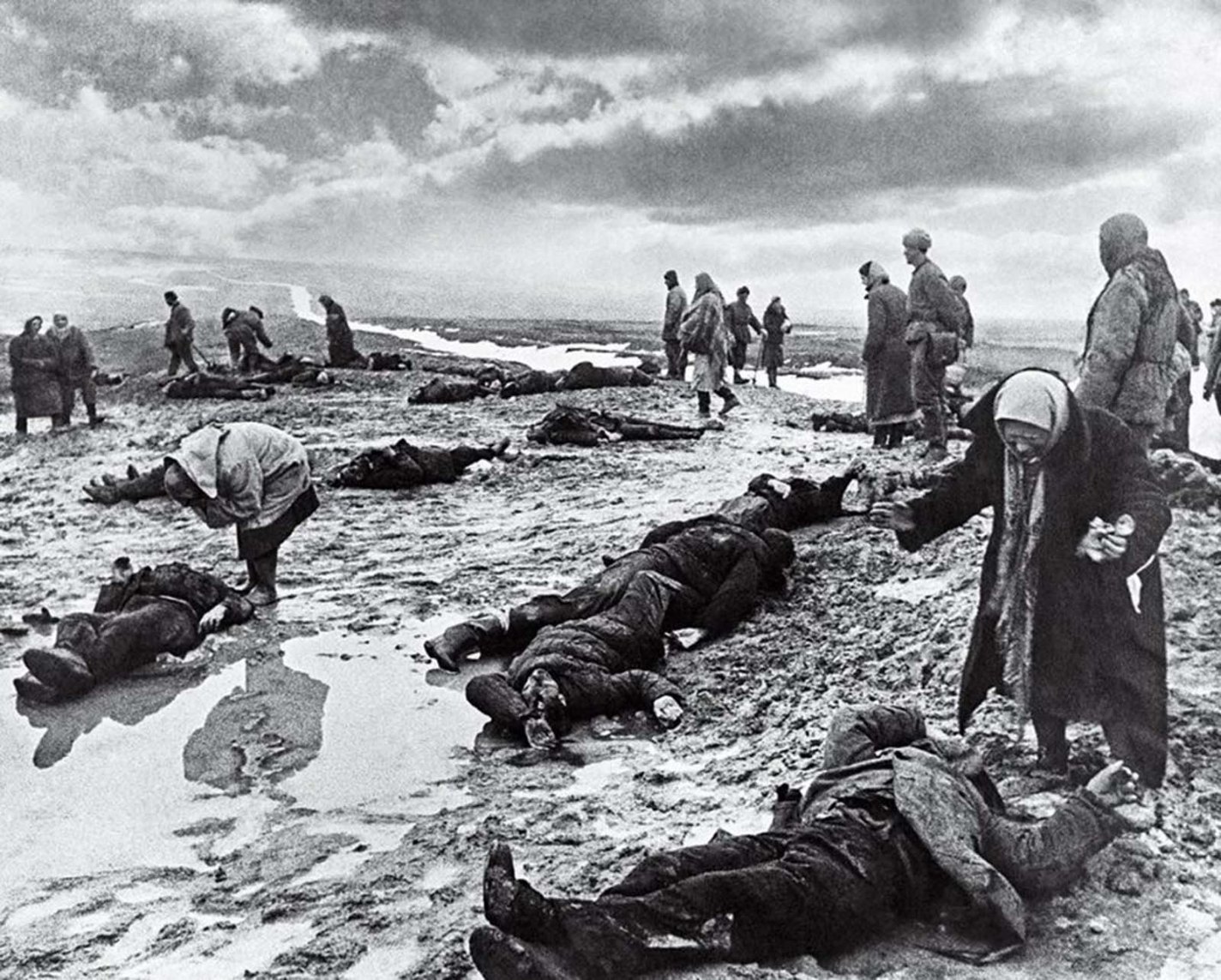
28. Grief, Dmitri Baltermants, 1942.
Dmitri Baltermants refused an academic career for photojournalism. He agreed to report western Ukraine’s annexation for one of the central Soviet paper, Izvestia, without doubts. As his daughter remembers, he said: “It took a little time to think – my soul was already poisoned by photography. It remains to pick up the camera.”
But this work wasn’t easy. During his trip to Kerch, Crimea, occupied by nazi, he captured the irredeemable and horrible pictures. Corpses of 7 thousand Jew, whole families were murdered. Censorship didn’t allow this photo for print, replacing it with the different historical photos by Baltermants. Later, when they were published, they affected the history and vision of future generations’ war.
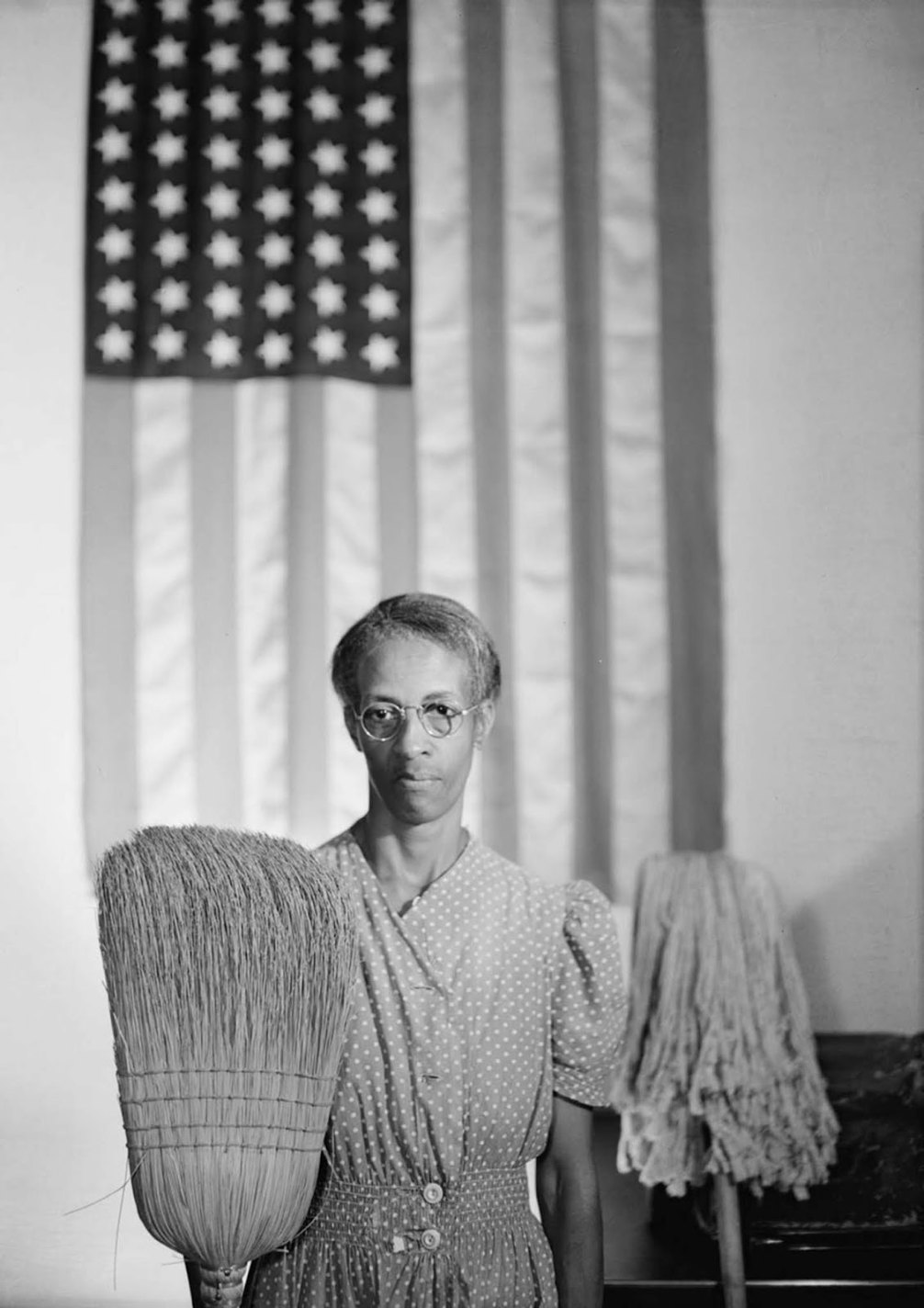
29. American Gothic, Gordon Parks, 1942.
Racial segregation in the 1940s and 1950s changed – arose the question of social and economic inequality based on racial affiliation. Being the first African-American LIFE reporter, he started to talk about racial discrimination. His photo homage to the famous Grant Wood drawing with the same name “American Gothic” depicts cleaner Ella Watson. Later he took more historical photos of her life, illustrating poverty and the daily struggle of black peoples’ experience of that time. Nobody cared about lynch mobs, the absence of civil rights of people of color. When talking about that period, Parker said once: “What the camera had to do was expose the evils of racism, by showing the people who suffered most under it.”
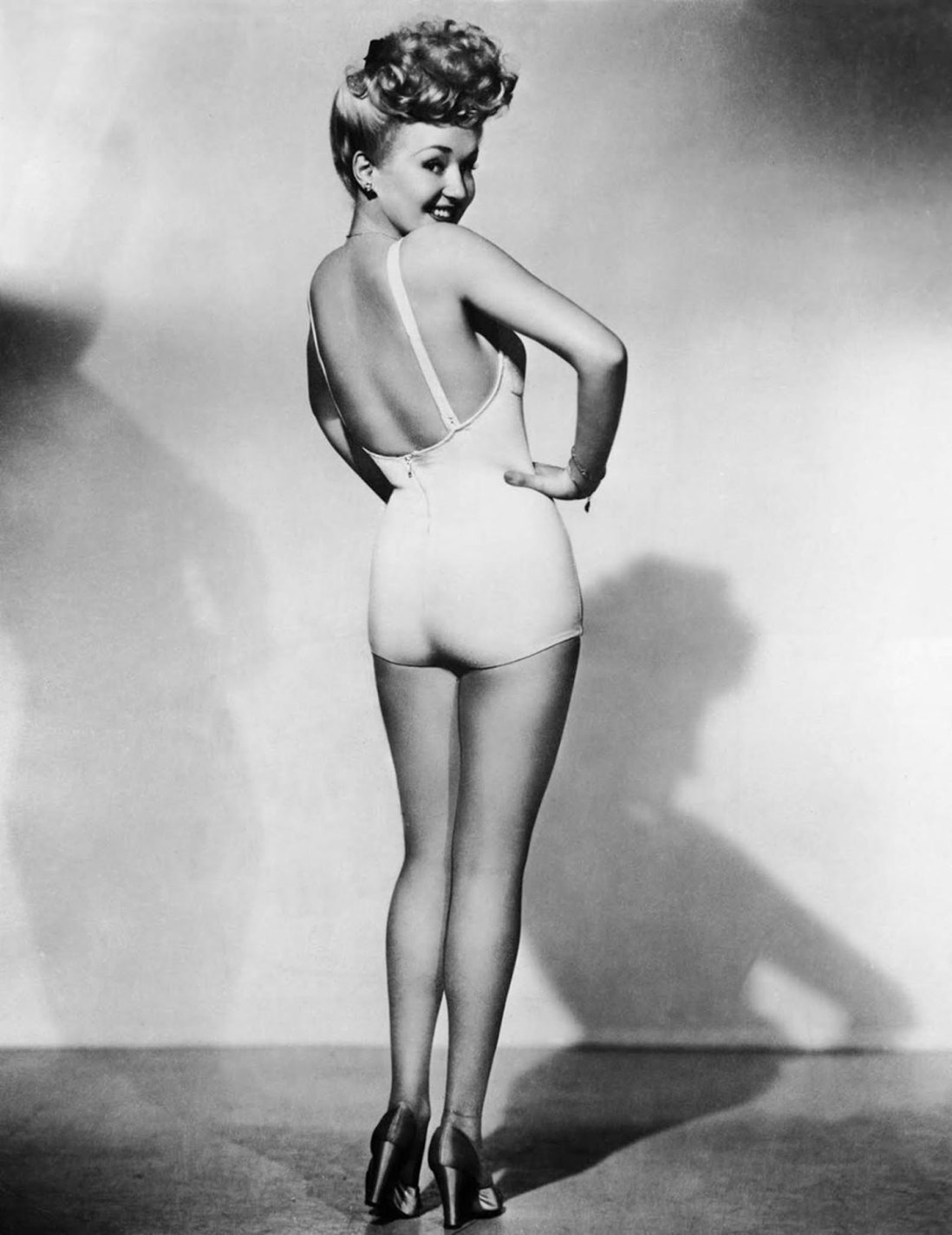
30. Betty Grable, Frank Powolny, 1943.
The iconic pin-up picture of Betty Grable delighted men’s eyes and hearts during World War II. It became the most requesG.I.shoto GIs stationed overseas. This poster’s fame affected Betty’s acting career, making Hollywood starlet a top-star of the 40s’. The flirty pose of a blonde in a one-piece bathing suit was repeated over and over again – it was drawn on the bombers, submarines, barrack walls, reprinted on cards – a valid symbol of homeland waiting for American soldiers to return. Also, Grable was accessible at home, and her name on the movie poster was a guarantee of its success.
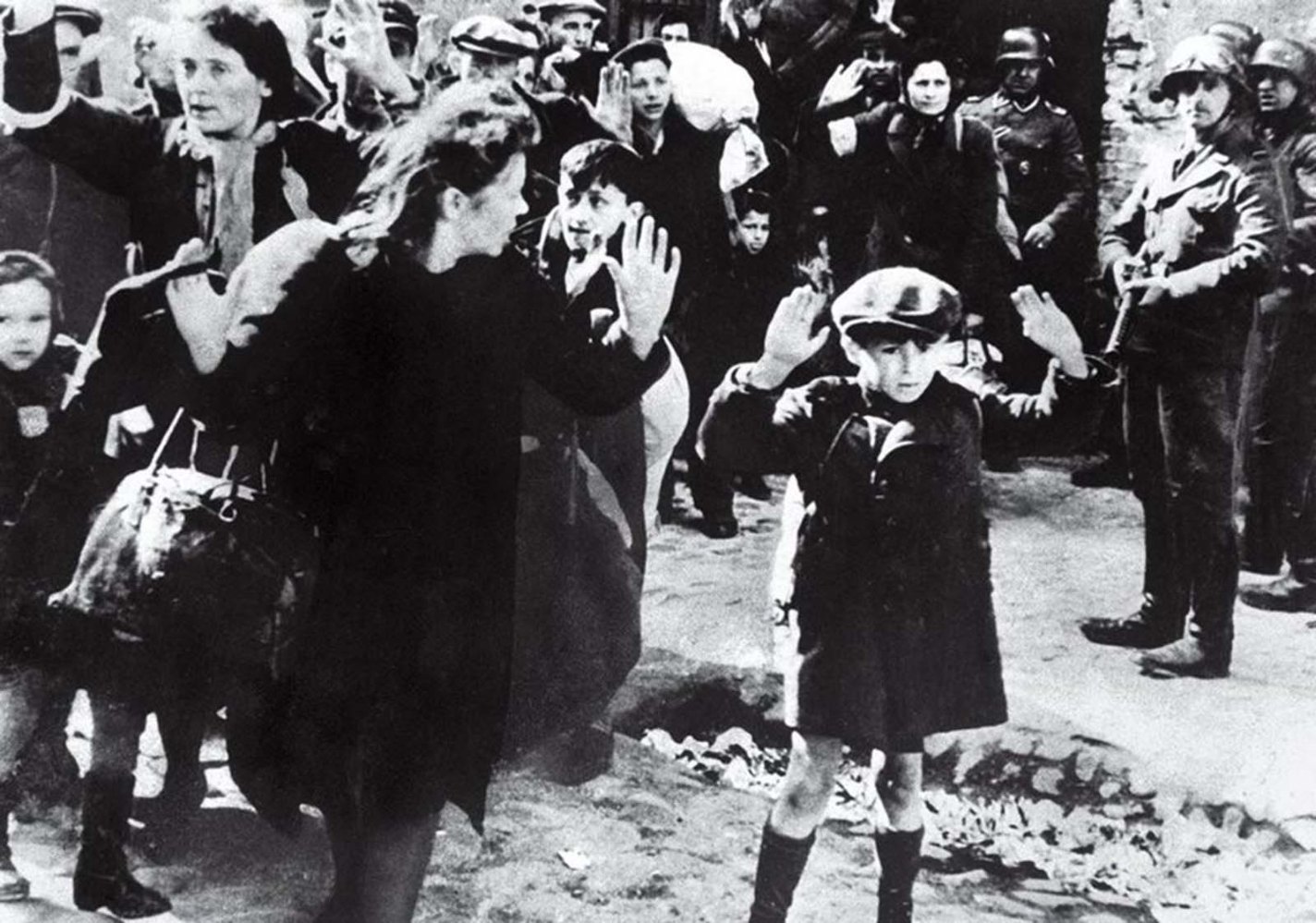
31. Jewish Boy Surrenders in Warsaw, Unknown, 1943.
This is one of the most famous Holocaust historical photos, where a little Jewish boy is waiting for arrest during the Warsaw Ghetto Uprising, became iconic. Nazis used such historical photos for reports and carefully collected them as evidence of the effectiveness of their soldiers. Mainly this one is from The Stroop Report: The Warsaw Ghetto Is No More. After the war, these collections were used as visual documentary against the Nazi regime and proof of Germans’ war crimes against the Jewish population. The photo had a significant impact on forming the opinion about Jews who humbly went to concentration camps, but some partisans tried to protect their people.
The boy’s name is unknown – investigations of his identity weren’t very successful – several persons claim themselves as the boy from the photo, but there is no evidence he survived.
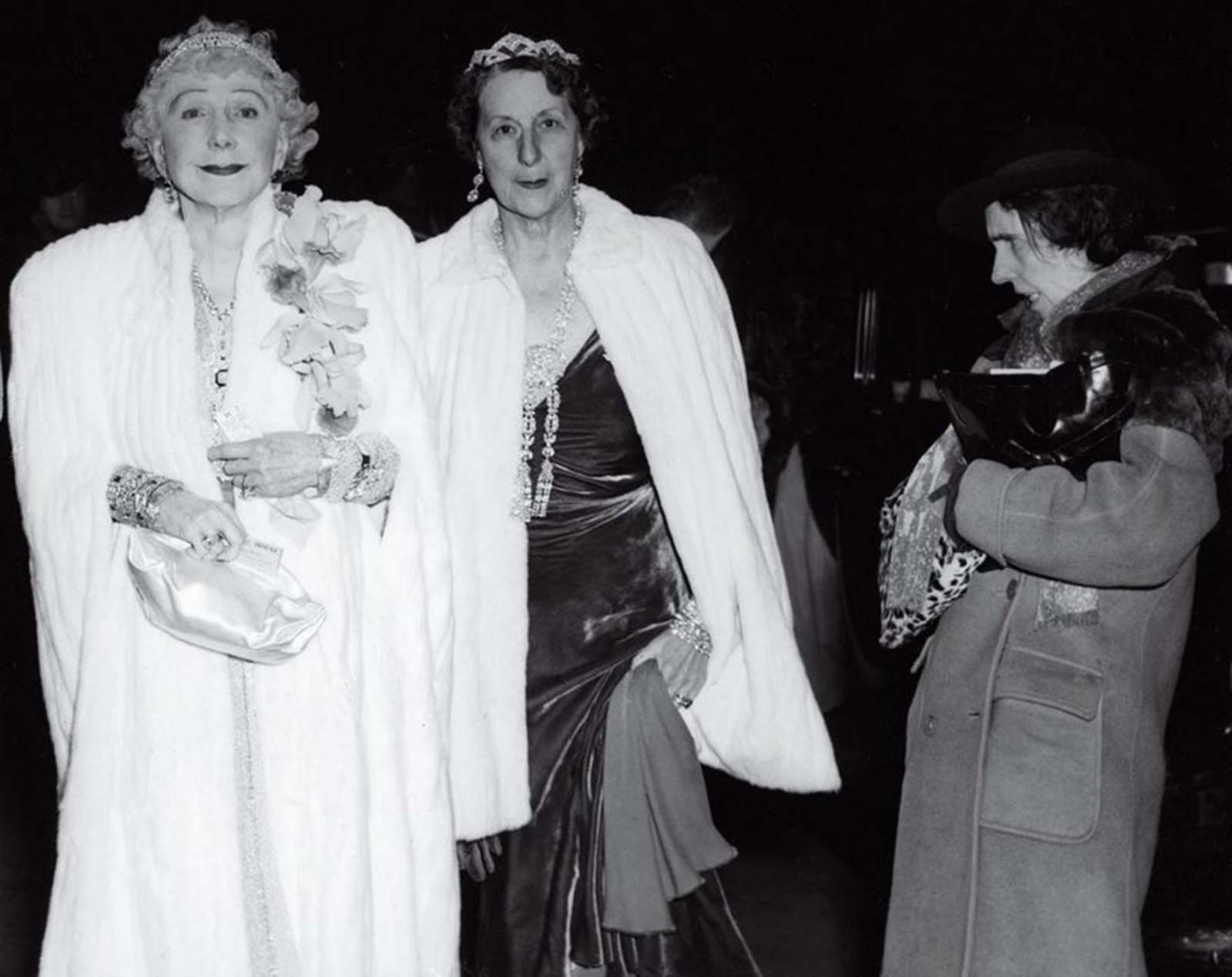
32. The Critic, Weegee, 1943.
Arthur Fellig was among photojournalists who liked to create a mystic aura around their persona. Thanks to permission to have police shortwave radio, he gained the fame of psychic kind of – his pseudonym Weegee refers to the Ouija board due to taking photos of crimes.
But one of his most famous historical photos was devoted to economic disruption after the Great Depression. Even known to be staged, The Critic had a massive impact by showing high and low society reality. His assistant, Louis Liotta, claimed that Weegee asked to find a drunk woman and take her up to the Metropolitan Opera House on Broadway. The shot was taken when two rich and wealthy ladies, Mrs. George Washington Kavanaugh and Lady Decie, came to the red carpet. This photo style became the forerunner of the tabloid and paparazzi era and an inspiration for the pop culture genre.
Interesting fact: Mrs. George Washington Kavanaugh was insulted by this staged photo, called a policeman and tried to take his camera. The policeman pretended to be arresting a photographer but let him go with his images. Weegee and NYPD had exceptional relationships.
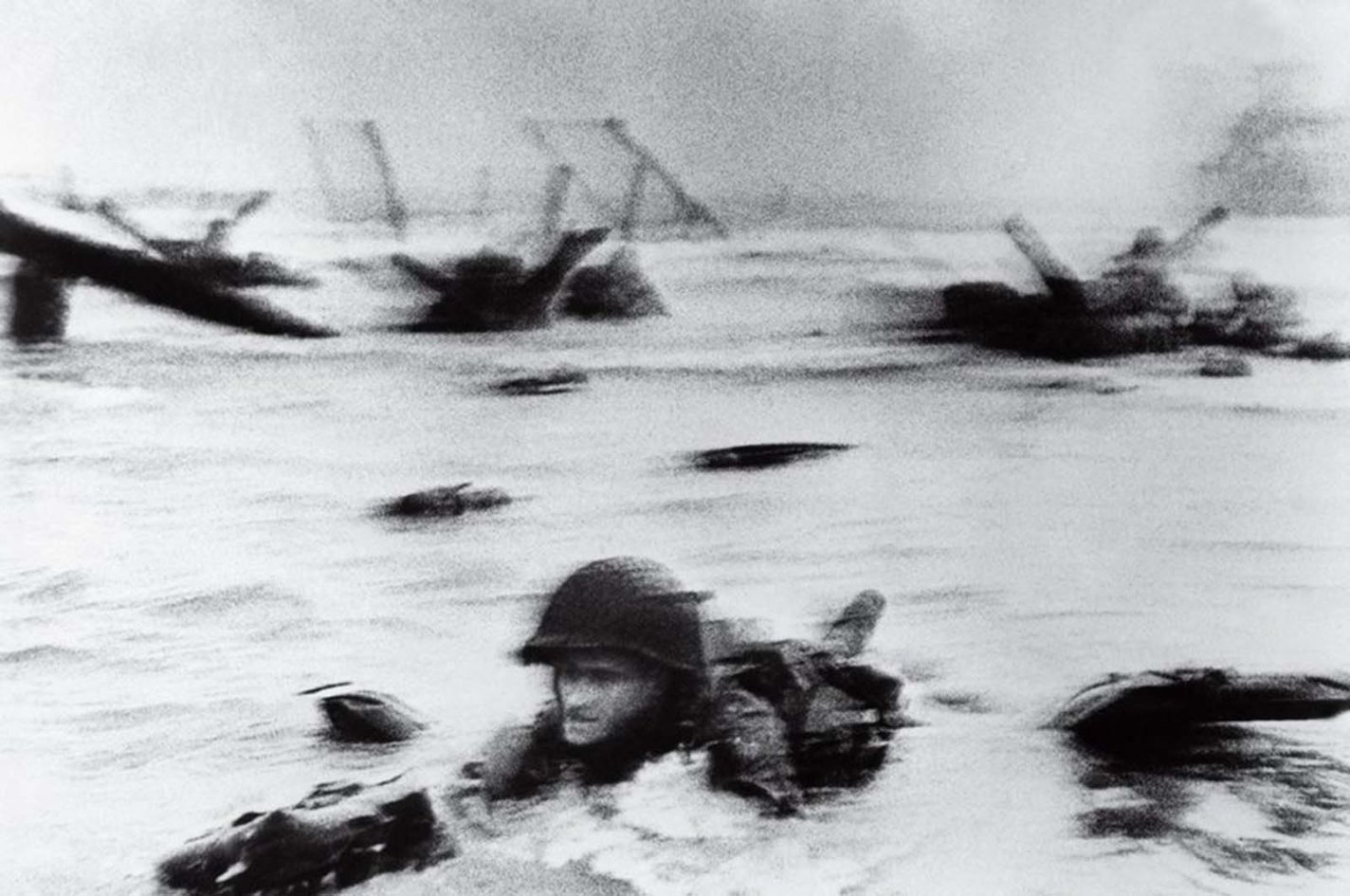
33. D-Day, Robert Capa, 1944.
D-Day is a collective term, but amphibious landing during the Allied invasion of Normandy codenamed Operation Neptune is the best-known. Robert Cappa was the only war photographer who documented this action. As he noted in his memoir, “It was still very early and very grey for good pictures, but the grey water and grey sky made the little men, dodging under the surrealistic designs of Hitler’s anti-invasion brain trust, very effective.”
Operation on Omaha Beach started at 6:30 a.m., troops landed under fire from the shore, and 22-years old Huston Riley was one of the survivors who reached the beach.
Only 11 historical photos of June 6, 1944, weren’t spoiled and were published as The Magnificent Eleven in the LIFE magazine. These pictures inspired Steven Spielberg to make the film Saving Private Ryan look like in Capa’s photographs: dark, hard, and desperate.
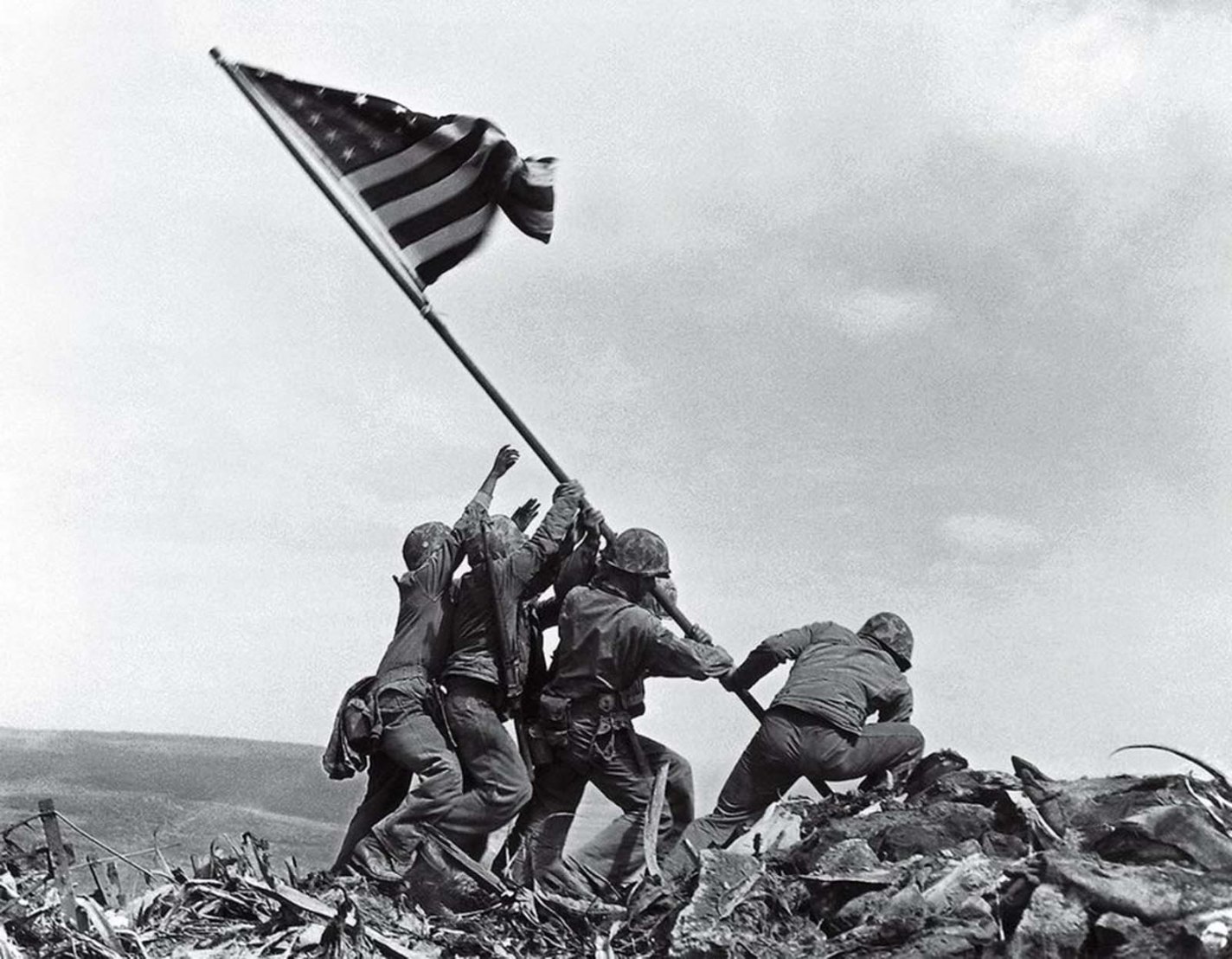
34. Flag Raising on Iwo Jima, Joe Rosenthal, 1945.
A full story of this historical photo.
Joe Rosenthal is the only reporter who was prized with the Pulitzer Prize for Photography two months after taking his shot. Raising the Flag on Iwo Jima was reprinted and reproduced many times in various formats due The Associated Press placed this image in the public domain. In 1951 it was used as a stamp for a memorial to the Marine Corps design.
In 1945, it was an important strategy to set a platform near Japanese shores, but it’s currently disputed nowadays. The small volcanic island of Iwo Jima was the only battlefield where American troops’ losses exceeded Japanese, and it’s utility remained controversial.
Nevertheless, The Flag Raising on Iwo Jima became one of the most recognizable historical photos of the Pacific War among WW2 iconic images.
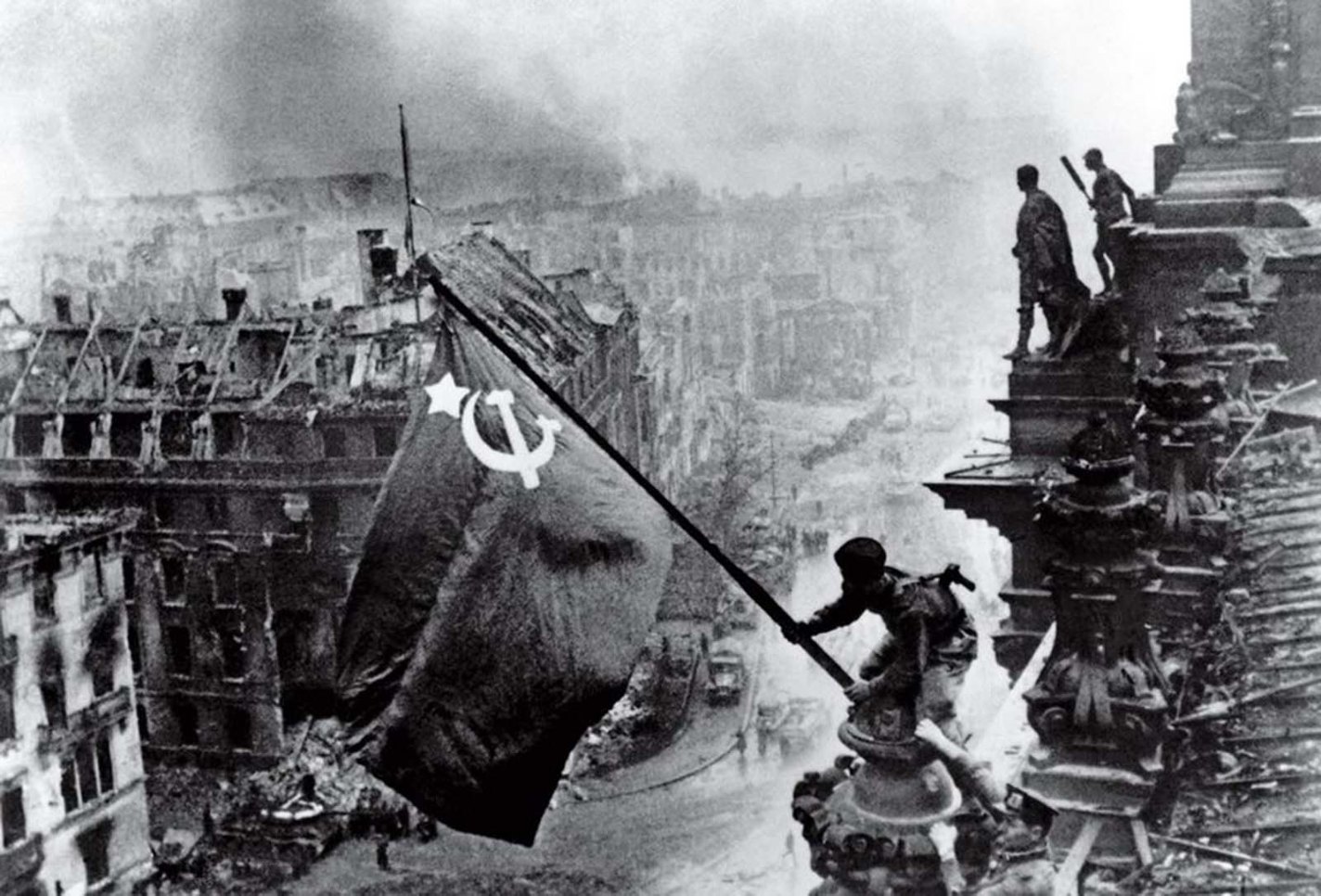
35. Raising a Flag over the Reichstag, Yevgeny Khaldei, 1945.
Read a full story behind this historical photo.
Victory over Hitler’s regime was a long-awaited event. After Soviet troops took Berlin in May 1954, photographer Yevgeny Khaldei took a series of photographs of raising the flag over the Reichstag. The flag itself was made of tablecloths, and the photos were planned as documentaries for the Soviet magazine “Pravda.” Staging the picture, the photographer correctly transferred the euphoria from victory and added more drama by retouching clouds over the ruined city. That period, many Soviet photographers took shots but worldwide became known this photo due to its usage in propaganda and the number of reprints on postcards, posters, post stamps, etc. The bloodiest decade was almost over, and this moment is frozen in these historical photos.
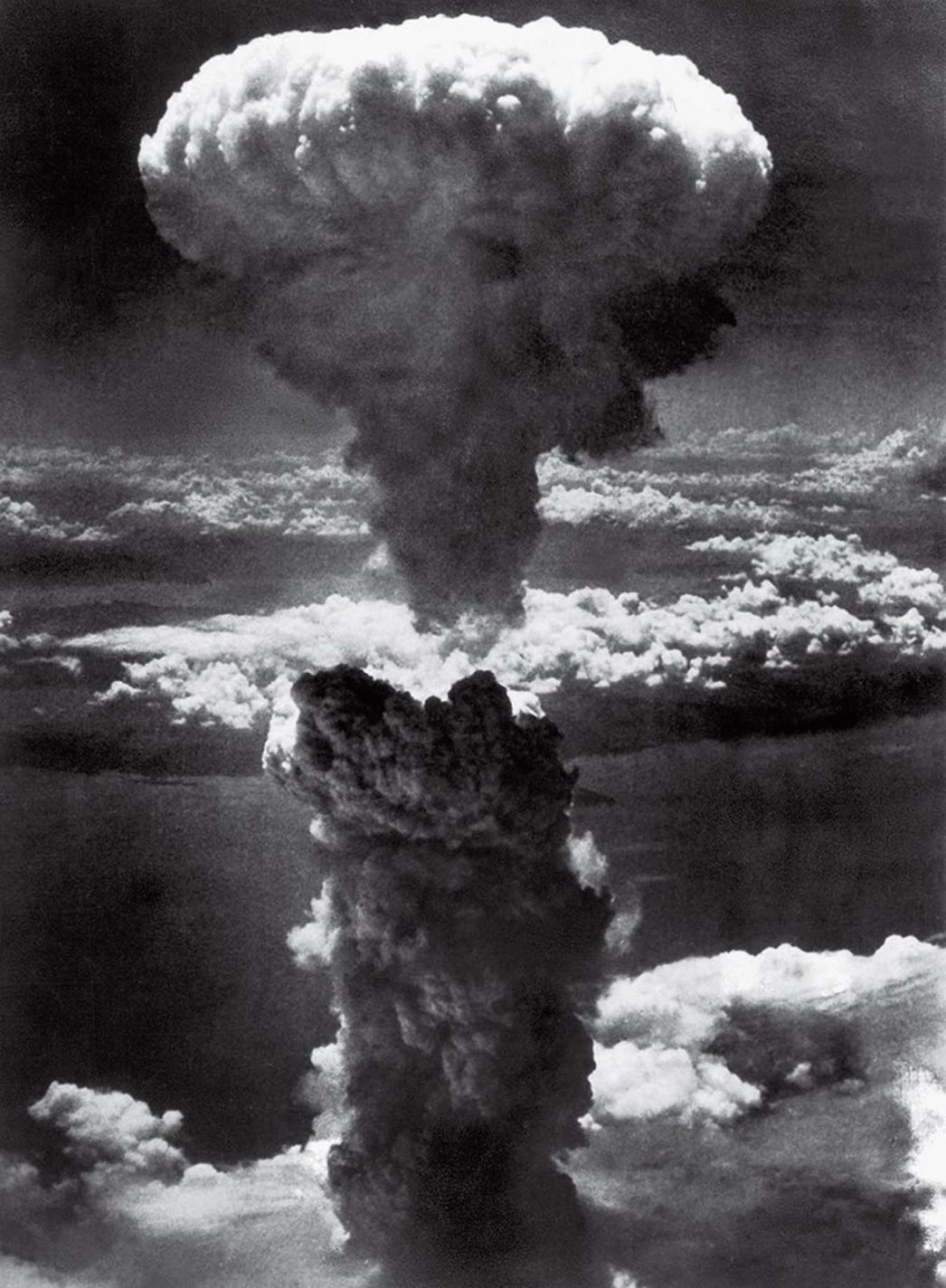
36. Mushroom Cloud Over Nagasaki, Lieutenant Charles Levy, 1945.
Japanese surrender in 1945 followed a demonstration of the power of the nuclear weapon. Lieutenant Charles Levy captured the nuclear mushroom from the second atomic bombing in history, which took the lives of more than 40 000 people. Live described the blow as “purple, red, white, all colors—something like boiling coffee. It looked alive.”
Threats from the USA to continue bombing and the Soviet Union’s entering into the Pacific conflict forced the end of the war. While Japan tried to hide the demolition caused by A-bombs, Levy’s photo spread very fast, marking the atomic era’s start. This photo showed the explosion yet unseen in human history. The necessity of nuclear weapons usage is still disputed, but its power turned the vector of history.
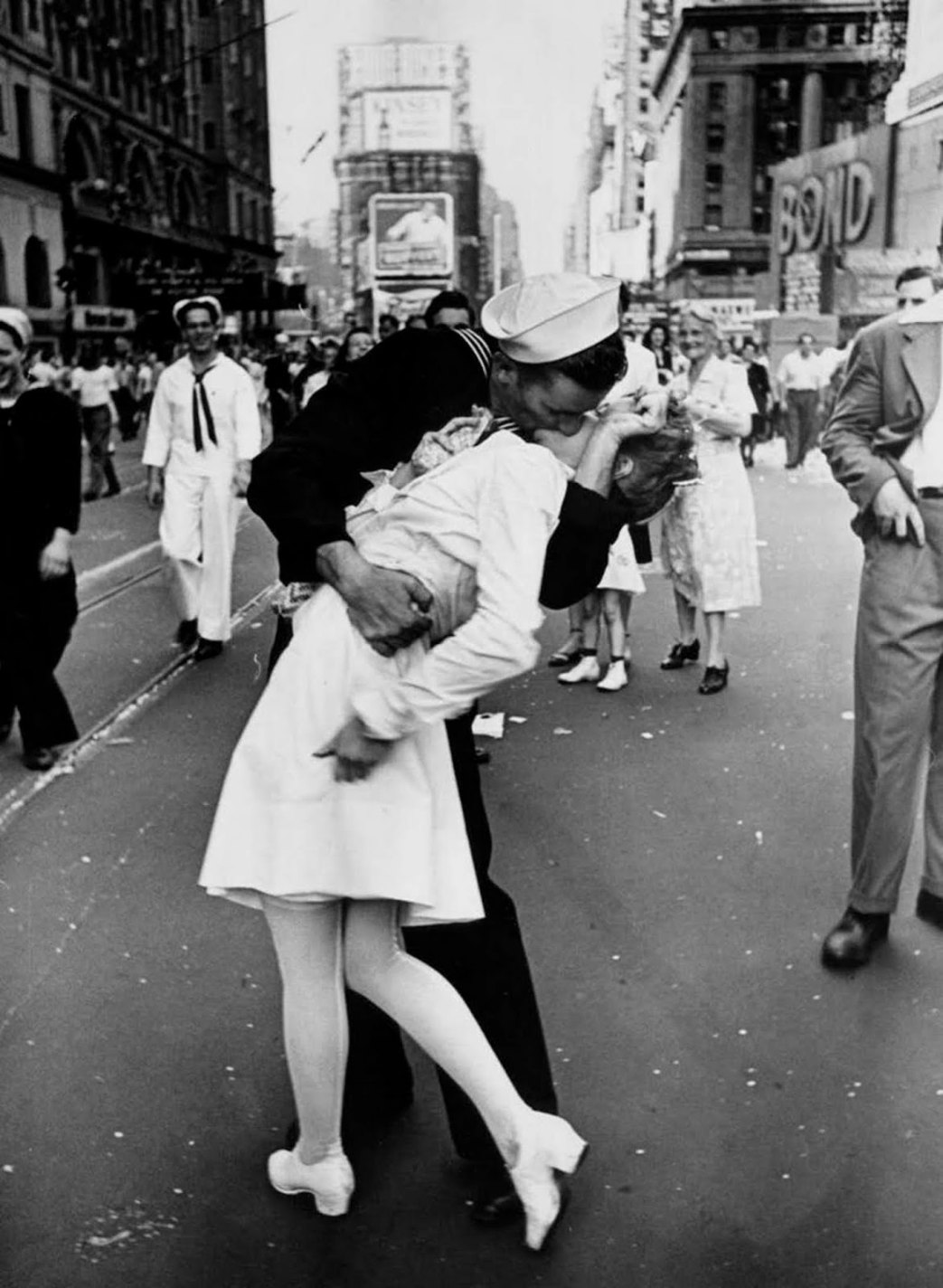
37. V-J Day in Times Square, Alfred Eisenstaedt, 1945.
A story about this photo in history
News of the end of WWII and Japan’s surrender prompted Americans to go out to the streets to celebrate the event. Photographer Alfred Eisenstaedt was lucky to capture the moment when a sailor kissed a nurse in Times Square, and this photo became a sensation. And although other photographers photographed the same couple, Eisenstaedt’s image became the most famous cultural icon of the occasion. According to Eisenstaedt, if the clothes of a sailor or nurse were another color, the photo wouldn’t be so prominent and memorable: “If she had been dressed in a dark dress, I would never have taken the picture. If the sailor had worn a white uniform, the same.” A single photo ended the saddest chapter in human history.
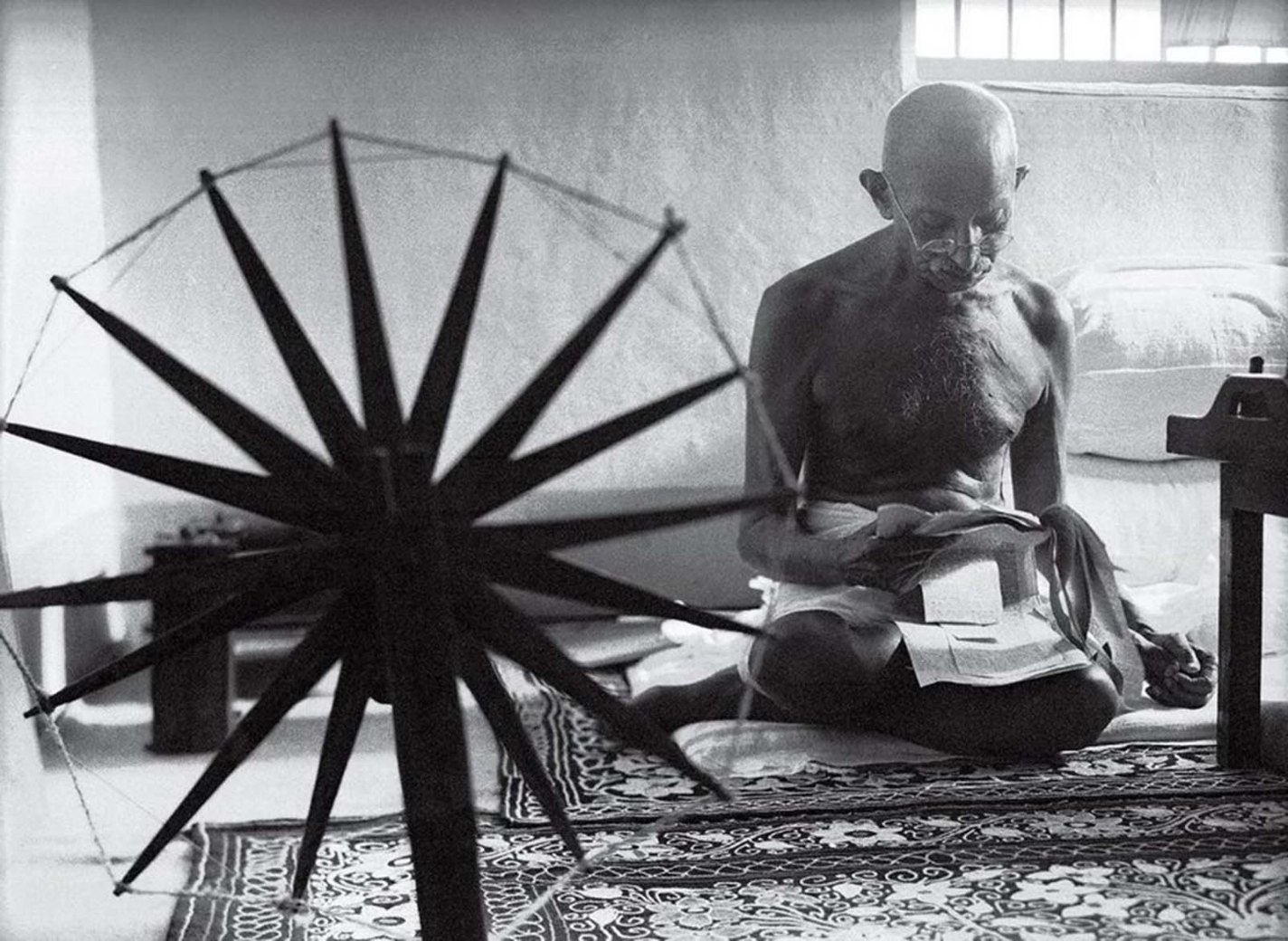
38. Gandhi and the Spinning Wheel, Margaret Bourke-White, 1946.
When developing his Swadeshi vision, Mahatma Gandhi stigmatized the meaning of the traditional Indian spinning wheel “charkha” and made it one of the Swaraj flag symbols. The sacral significance of charkha reflected India’s will for independence from the British Empire and the boycott of all British goods. The value of charkha was so prominent that when Margaret Bourke-White made a reportage about Indian leaders, she was asked to learn how to use it. Also, she had only three attempts to take a photo, two failed due to equipment fragility in the Indian climate, but the last one was successful. Two years later, the picture was published after Mahatma Gandhi’s death and became Gandhi’s most iconic representation.
Interesting fact: when Margaret Bourke-White asked Gandhi’s permission to ‘take some shots’ for the Life magazine, Indian politician just said: ‘Your shots are much better than others that will threaten me one day.’

39. Dalí Atomicus, Philippe Halsman, 1948.
Philippe Halsman’s approach to portrait photography was very different from his contemporary. Application of his philosophy of so-called “jumpology” when people take off masks while concentrating on jumping or talking allowed Halsman to take sporadic and exciting photos of many celebrities, including Albert Einstein, Marilyn Monroe, and Alfred Hitchcock.
The greatest success came after his first photoshoot with Salvador Dalí. Both the painter and photographer enjoyed working together, and later they often collaborated.
Dali’s creations inspired the iconic Dalí Atomicus. Halsman’s assistants threw a bucket of water and three cats to take the perfect photo while Dali jumped. This and many other images were published in LIFE magazine, and Philippe Halsman holds the record of creating 101 covers of this periodical. He knew how to create some excellent historical photos indeed.
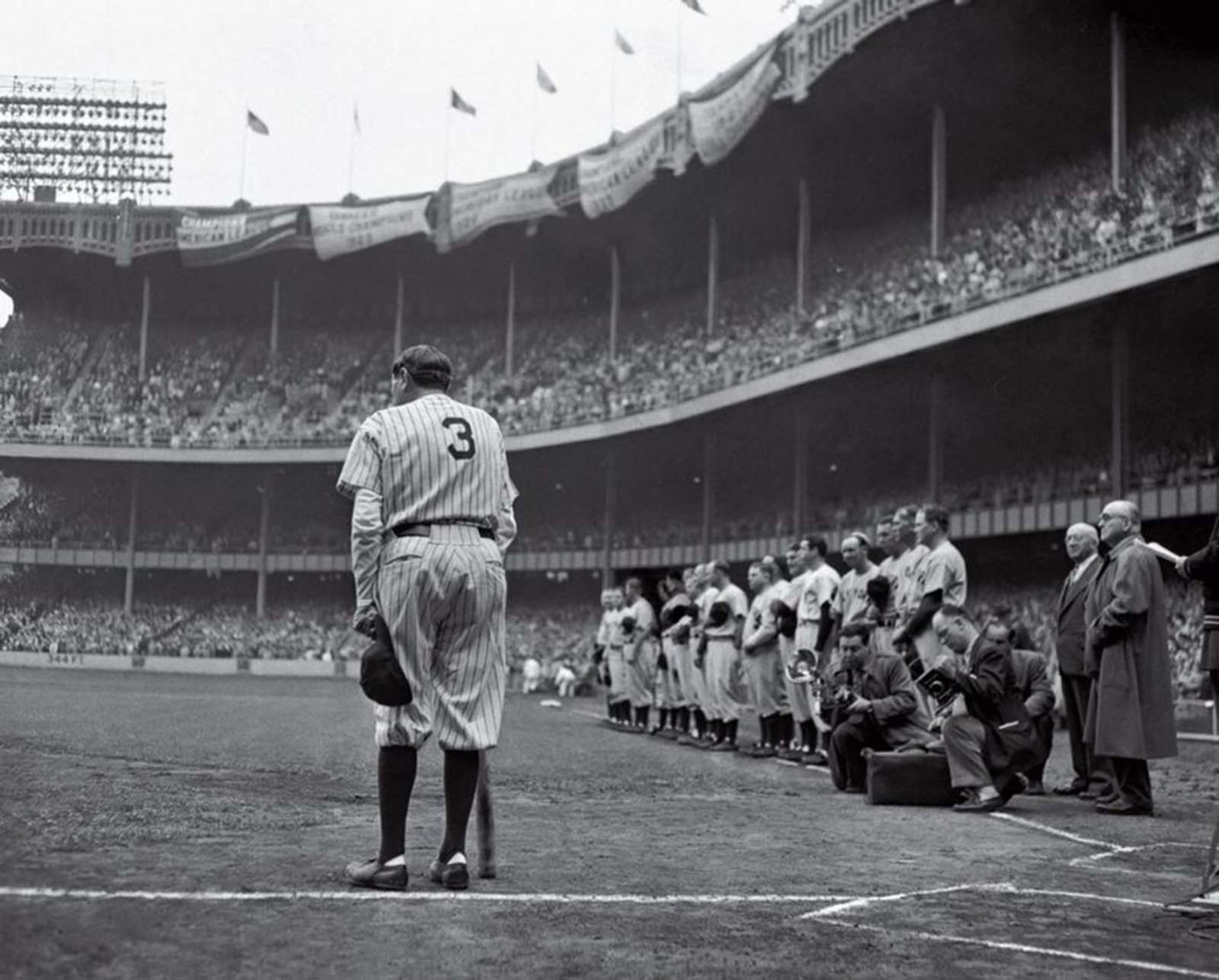
40. The Babe Bows Out, Nat Fein, 1948.
George Herman “Babe” Ruth Jr., known as “The Bambino” and “The Sultan of Swat” was an iconic figure of The Roaring Twenties. Thanks to his powerful hits and the record number of home runs, he attracted the public attention to baseball.
Thanks to advances in the baseball court and beyond, he has been the subject of media attention and fans throughout his career. His reckless lifestyle – a love of booze and women – combined with a desire to do good, and he often visited children in hospitals and orphanages as a member of the Knights of Columbus. At the end of his playing career, he could not find a job in baseball, mainly due to poor behavior during performances in Major League Baseball. In 1946, he was diagnosed with cancer. His last game, devoted to the silver anniversary of Yankee Stadium, where Babe Ruth started a career, was lucky for Nat Fein. He captured the weakened posture of Babe Ruth and became the first sports photographer who won a Pulitzer Prize.
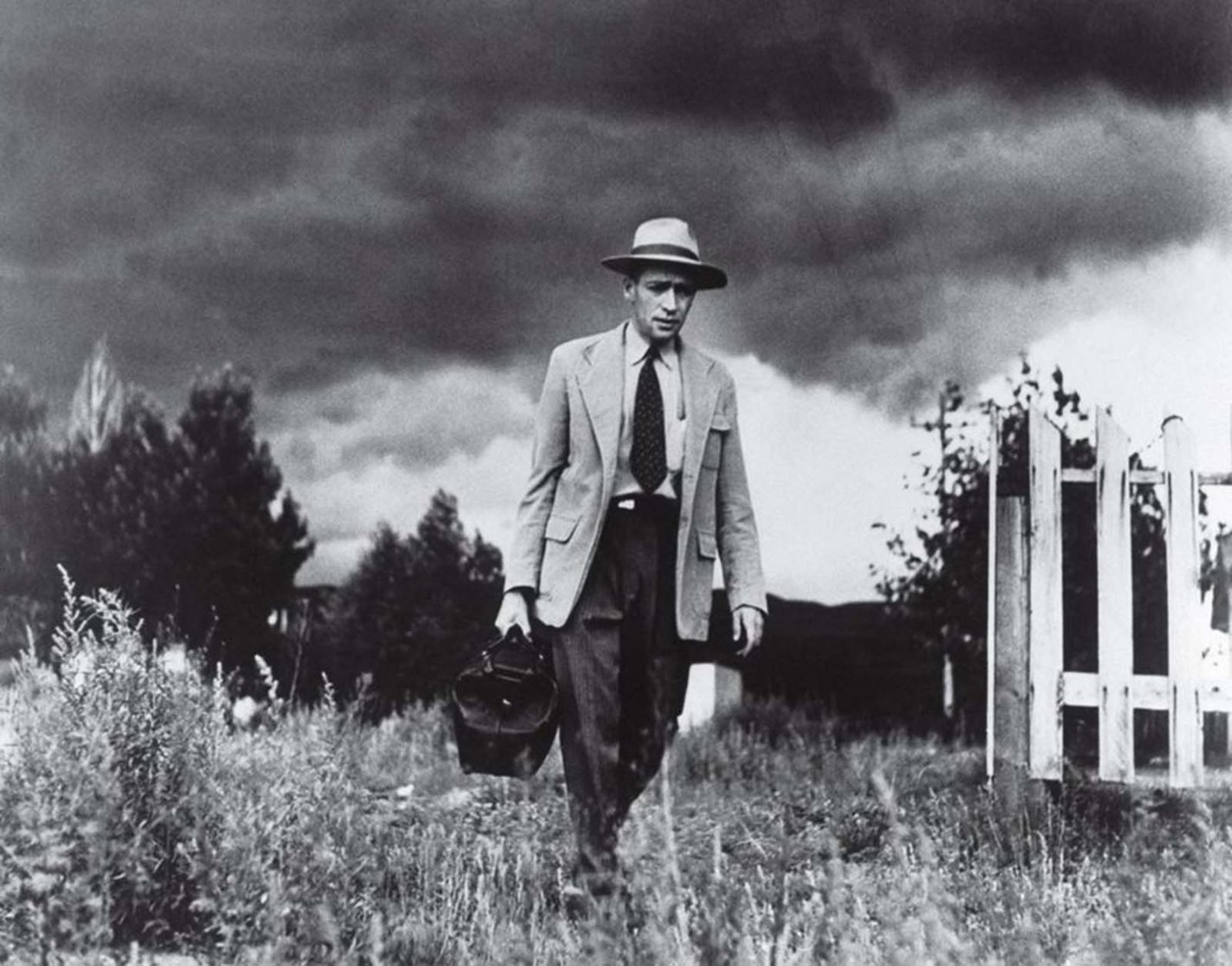
41. Country Doctor, W. Eugene Smith, 1948.
Rural regions of America always lack proper health care. An extended photo essay of the only doctor’s life in the village Kremmling, with a 2,000 population made by W. Eugene Smith, shed light on the routine life of Dr. Ernest Ceriani. The constant persistence and fight for human beings are reflected in physicians’ stoic posture and tired glance. The minimum equipment it’s hard accessibility resulted in numerous ways to adopt the surroundings: Dr. performed a Caesarean section in the kitchen, gave injection on the back of the car, etc.
The photos were published in LIFE magazine and claimed as “an instant classic,” This publication started a new form of photo report. Thanks to this and several other works, W. Eugene Smith became one of the most influential photojournalists of the century.
Interesting fact: Dr.Ceriani asked for the patient’s permission to agree to a W. Eugene Smith presence each time.
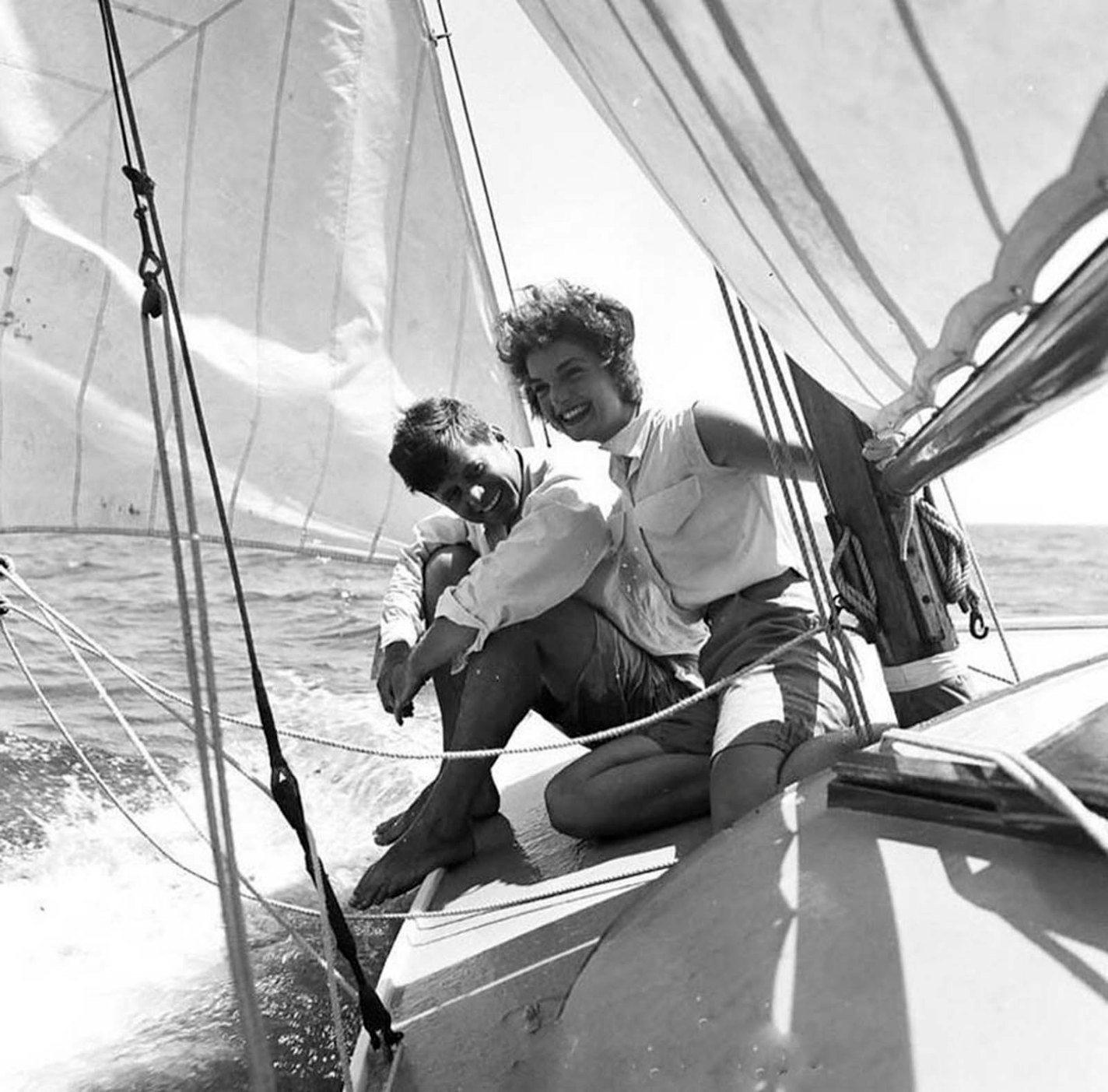
42. Camelot, Hy Peskin, 1953.
In the 1950s’ television still wasn’t common in the USA, so creating the political image of John Kennedy was formed by the photo session for LIFE magazine. The name Camelot for the picture was given due to positioning Kennedy’s administration as a real analog to the mythic kingdom and referred to Kennedy’s favorite Broadway show.
The portrayed couple looks so happy and radiant on the boat, “Victura.” But every photo was staged from location to postures, under the control of Joseph and Rose Kennedy. They invited famous sports photographer Hy Peskin for the shooting.
The strategy to show the future President InsideOut’s life was beneficial and had a significant influence on public opinion – the couple gained worldwide recognition. And this image became one of the best-known historical photos too.
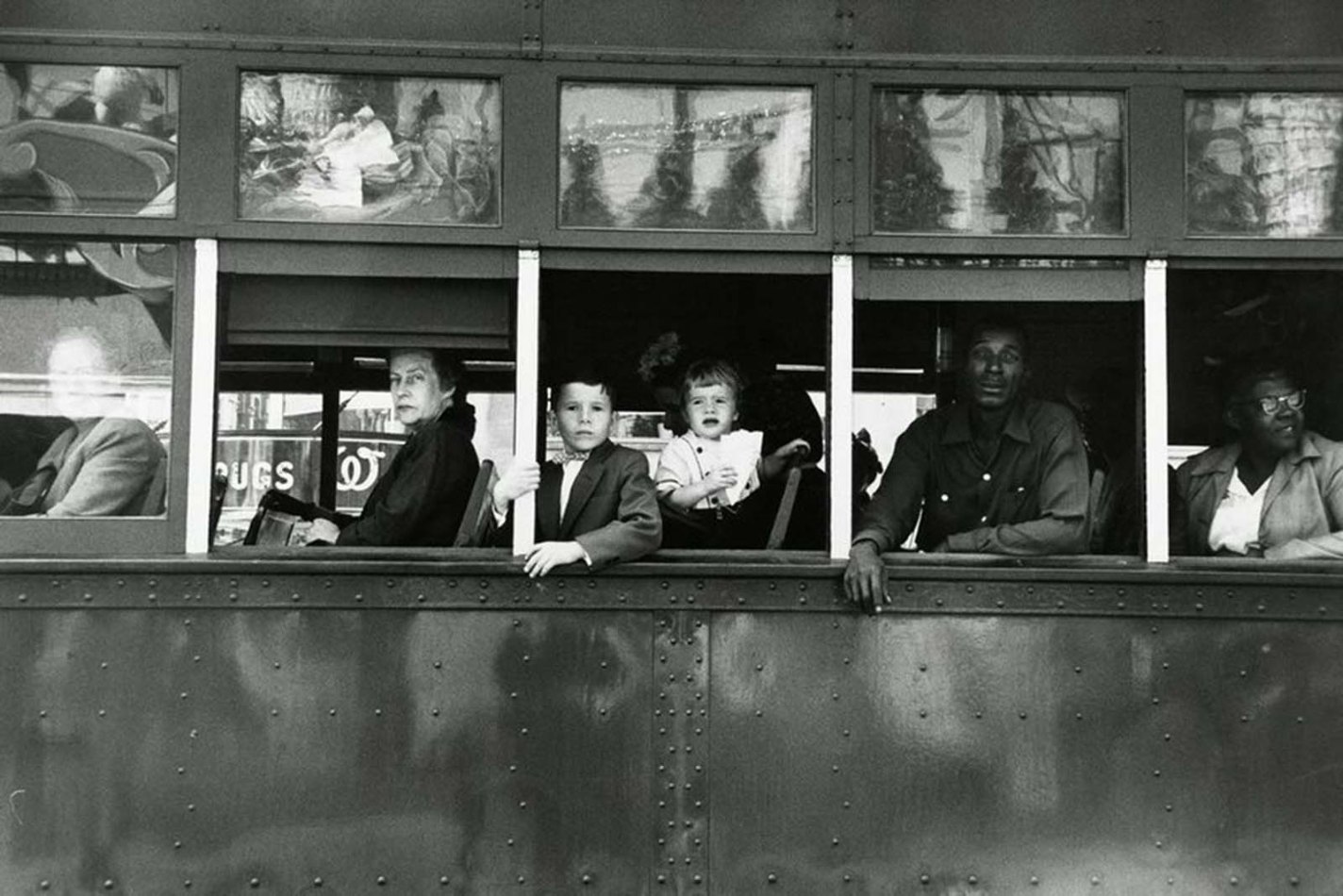
43. Trolley—New Orleans, Robert Frank, 1955.
Post-war America was full of controversy. For example, on the one hand, the segregation of people of color was blamed. On the other, it was shared. And in his book The Americans, Robert Frank captured this controversy from a new point of view. Using funds from the Solomon Guggenheim Foundation, he traveled across the USA and took more than 28,000 photos, from which 83 were chosen for the book. Like many of them, Trolley—New Orleans was brought accidentally: Frank photographed the parade and snapped passing trolley. And here it goes: your picture becomes one of the best historical photos.
“The Americans” was criticized by many contemporaries for poor image quality. Later it was considered one of the most influential and authoritative photographic canons, which became the basement for the whole new Beat Generation art movement.
Interesting fact: Swiss-born Robert Frank used to sayU.S.hat the US is a land of real freedom compared to old European democracies. Who knew that ‘Trolley—New Orleans’ will help the country to protect civil rights even better.
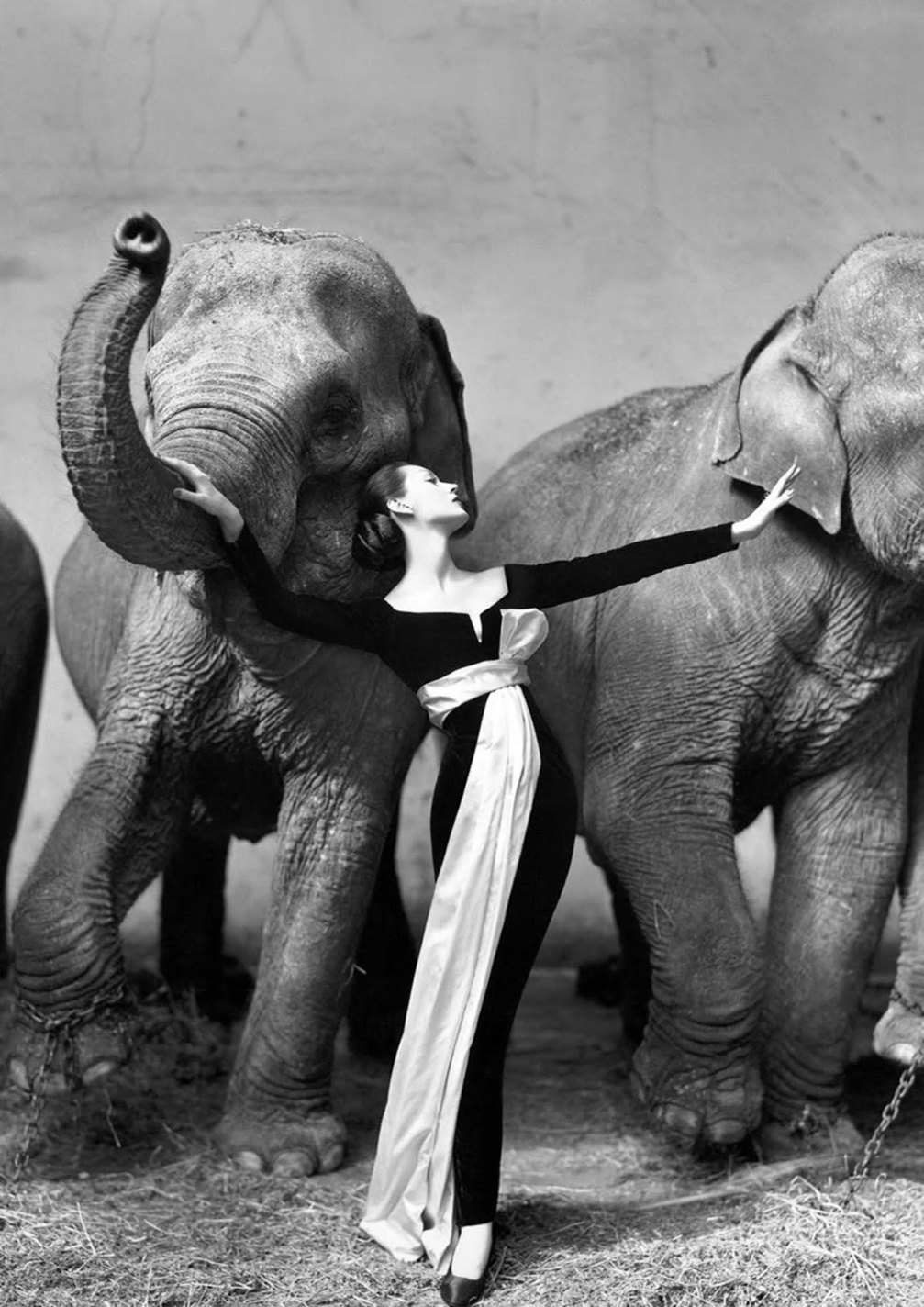
44. Dovima with elephants, Richard Avedon, 1955.
Richard Avedon called Dovima “the last of the great elegant, aristocratic beauties” and the “Dovima With Elephants” set, made at a Paris circus, became iconic in the fashion world at that time. Yves Saint Lauren made the dress for Dior’s house. By putting fashion clothes in an unusual background, Avedon started a new milestone in fashion photography, erasing borders between commerce and art.
Dovima commemorated the fade of mannequin-like, artistic, and noble-looking models – she was the first to use a single name, an anagram of Dorothy Virginia Margaret Juba, next years the focus of fashion tilted to girl-next-door model type.
Interesting fact: Dior sponsored this photoshoot. The fashion brand representative was a bit confused when he saw elephants in the pictures. Harper’s Bazaar editor guaranteed publication to avoid a scandal.
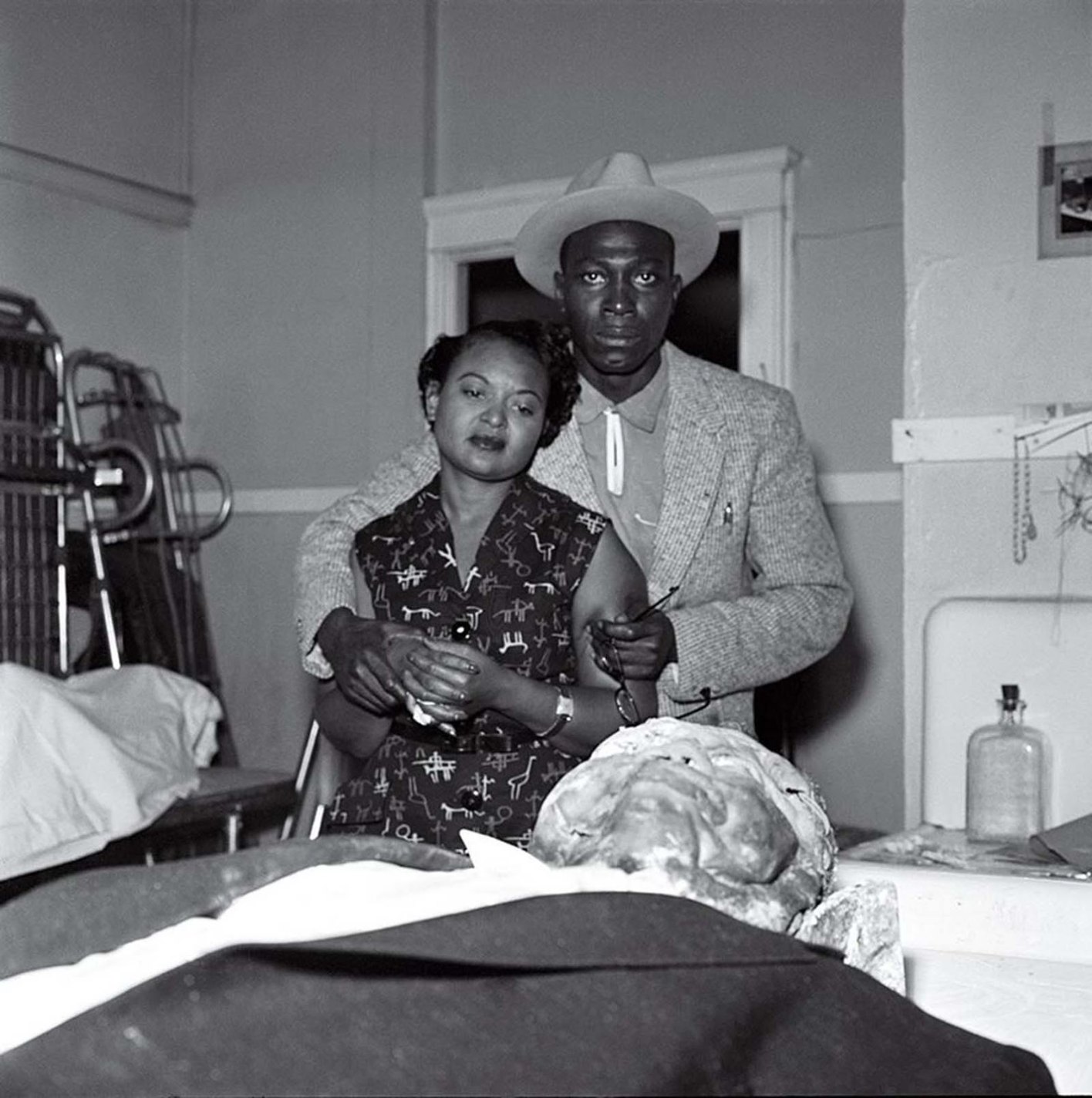
45. Emmett Till, David Jackson, 1955.
Photos of murdered black teenager Emmett Till in an open coffin raised the question about black people’s civil rights in the USA. The blind savagism of lynching had universal resonance.
The accusation caused the incident from white woman Carolyn Bryant that Emmett offended her. Was it real or not, but a few days later, Roy Bryant and his half-brother, John William “J. W.” Milam took the boy from his relatives’ house, tortured, and shot him. Then they threw the body in the Tallahatchie River. When being found, the organization was unrecognizable, but the ring identified the Emmett person. The court justified Bryant and Milam, but the trial was on the top of newspapers. The funeral also attracted a lot of attention. The photo of Mamie Till with her son’s remains symbolizes the new chapter in the history of the American Civil rights movement, triggered by this story.
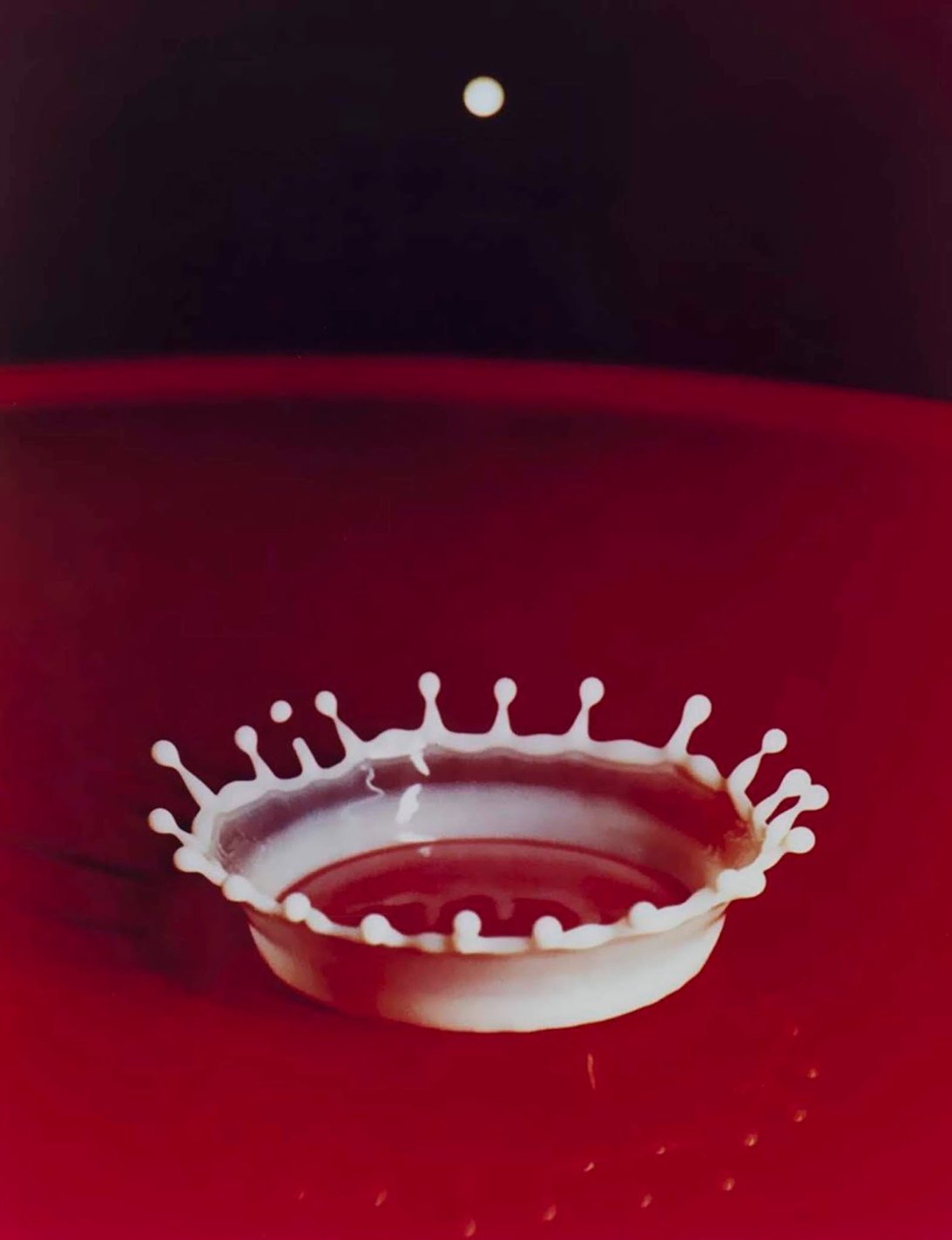
46. Milk Drop Coronet, Harold Edgerton, 1957.
Genius constructor Harold Edgerton developed a high-speed camera to catch the changing matter in nuclear explosions. He called his device a rapatronic camera, and it changed the whole thing. Being able to capture a millisecond moment, Edgerton created a complete set of shots, earlier impossible to see: bullet hitting the apple or card, milk droplet falling on the table, catching the whole motion of the tennis player, etc. For his hobby, he got the nickname “Papa Flash,” “Doc”: Edgerton used the stroboscope prototype connected to a camera shutter which allowed him to obtain magnificent historical photos. Milk Drop Coronet is one of the very first stop-motion photographs, on which he perfected the method.
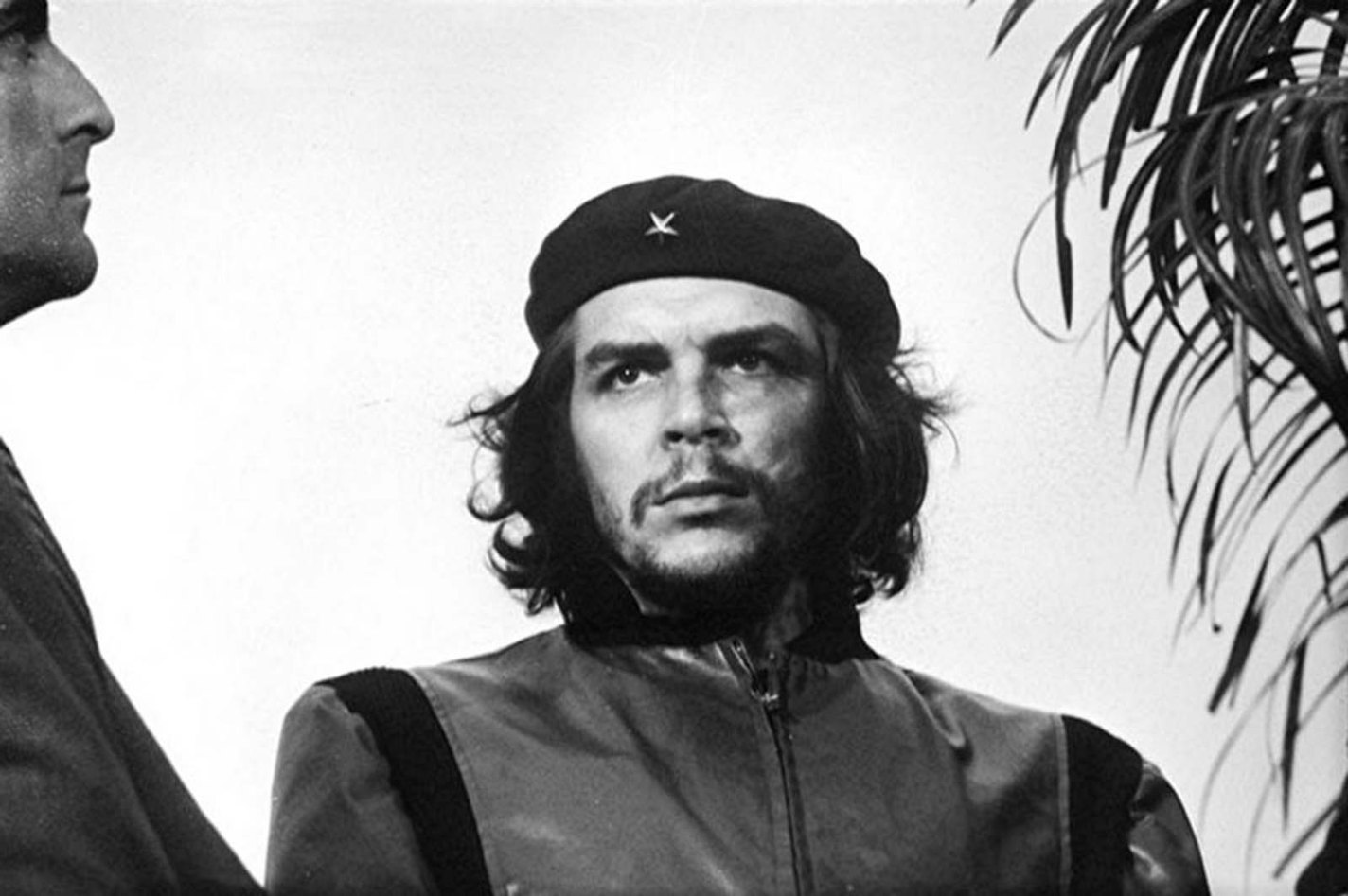
47. Guerillero heroico, Alberto Korda, 1960.
Historical photo of Che Guevara’s Nursing License
The image of young Che Guevara captured by personal Castro’s photographer Alberto Korda became a revolution symbol. At the moment of shooting Che Guevara, Korda was making the newspaper Revolución about the La Coubre explosion, and these photos weren’t unusual for the publisher. When Che was murdered in Bolivia, seven years later, it was used as an image of a heroic partisan. The cult of Che as a riot hero spread worldwide, and this photo, alongside poster stylization made by Jim Fitzpatrick’s, became a cultural symbol, one of the best-spread historical photos and heavily commercialized icon.
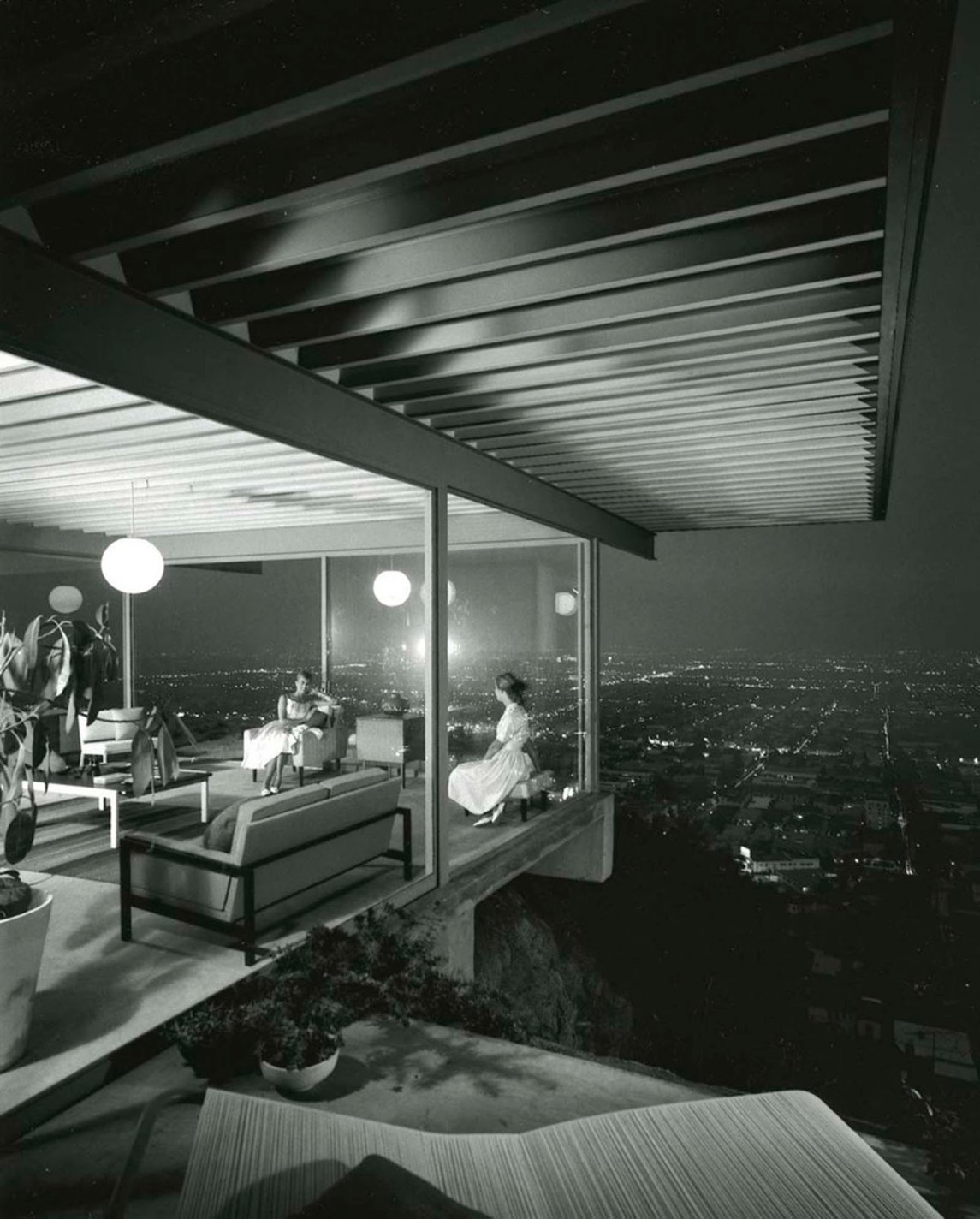
48. Case Study House no. 22, Los Angeles, Julius Shulman, 1960.
Majestic photo of the Stahl House, taken by Julius Shulman, made it the part of the National Register of Historic Places due to high popularity. It became the playground of many TV films, TV shows, and fashion events.
Photographer accomplished an excellent example of modern architecture with a fancy and calm atmosphere. The image of two young women chilling in the building with glass walls on top of the night city represented idealized bohemian life in Hollywood. Case study 22 was a part of a big architecture project of 36 different model houses made by famous architects. They were supposed to be active and cheap enough to soldiers who returned from WW2 with their European wives. Thanks to Shulman, such types of the dwelling were highly popularized.
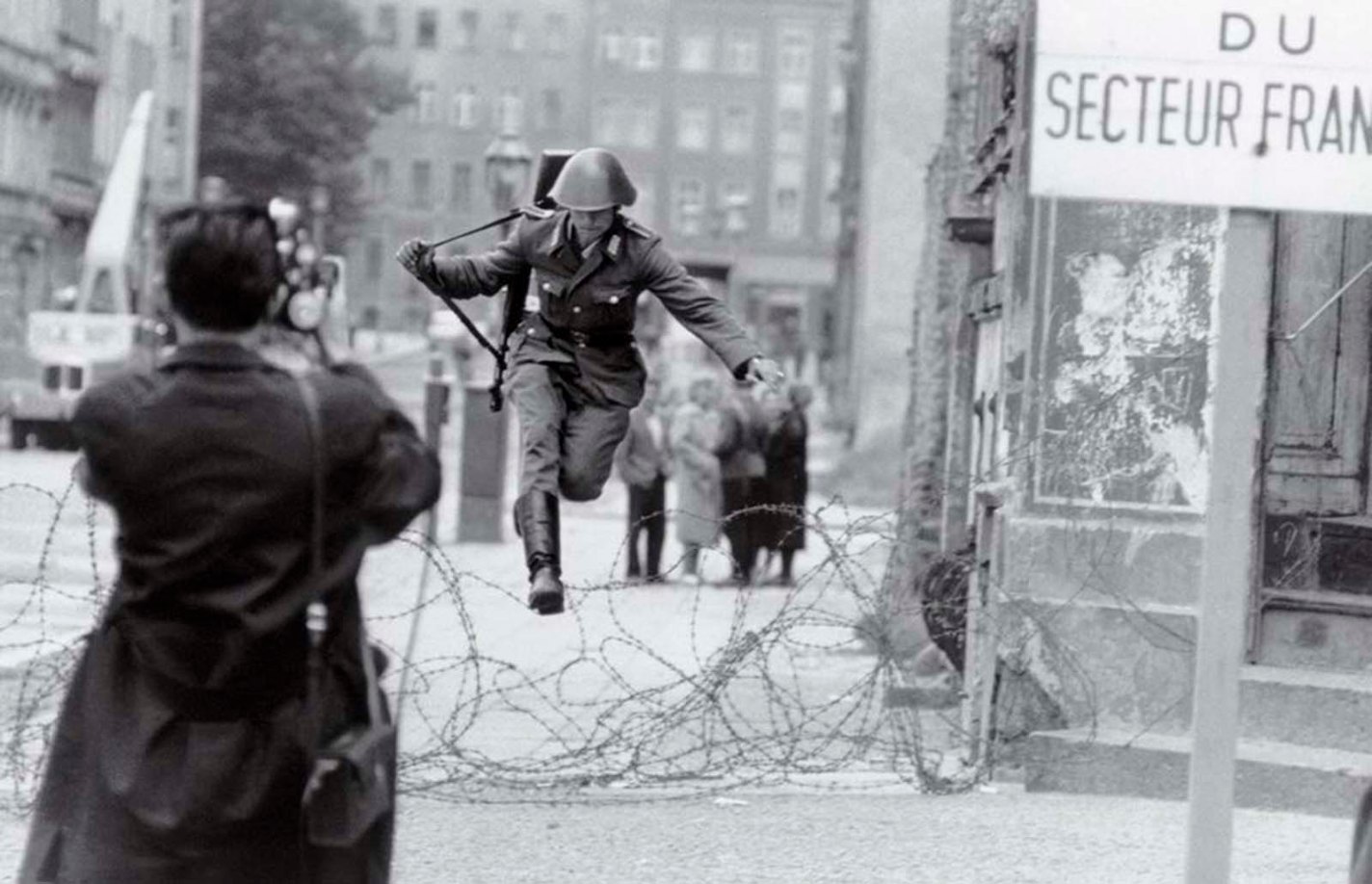
49. Leap into Freedom, Peter Leibing, 1961.
After being defeated in WWII, Germany was divided into Soviet and American sides of impact. People from East Germany escaped to the West even though barb wires. The great leap of freedom. The episode when young soldier Conrad Schumann deserted became the boiling point for constructing the Berlin Wall.
The photographer Peter Leibing was informed that something like this might happen, so he had his camera on. People from west Berlin yelled, “Komm rüber!” and 19-year old Schumann couldn’t resist – he jumped over the barrier and was taken by police. The burden of this incident pushed Schumann into depression and suicide at the age of 56.
Photographer’ next years were more successful; the photo spread worldwide, was used for posters, postcards, and as design for monuments as a symbol of Cold War confrontation.

50. Nuit de Noël (Happy Club), Malick Sidibè, 1963.
Malick Sidibé’s active years overlapped with the turning point of a critical period in Malian history.
Mali Federation got Independence from France in 1960, and the awakening of national consciousness marked the next period. People suffered from segregation and apartheid realized their freedom. It was widely demonstrated, like a young couple at a club dancing: “We were entering a new era, and people wanted to dance. Music freed us. Suddenly, young men could get close to young women, hold them in their hands. Before, it was not allowed. And everyone wanted to be photographed dancing up close.”
Sidibé did a fantastic job by documenting African culture in the late 20th century and became the first photographer to be awarded the Golden Lion Award for Lifetime Achievement at the Venice Biennale in 2007.
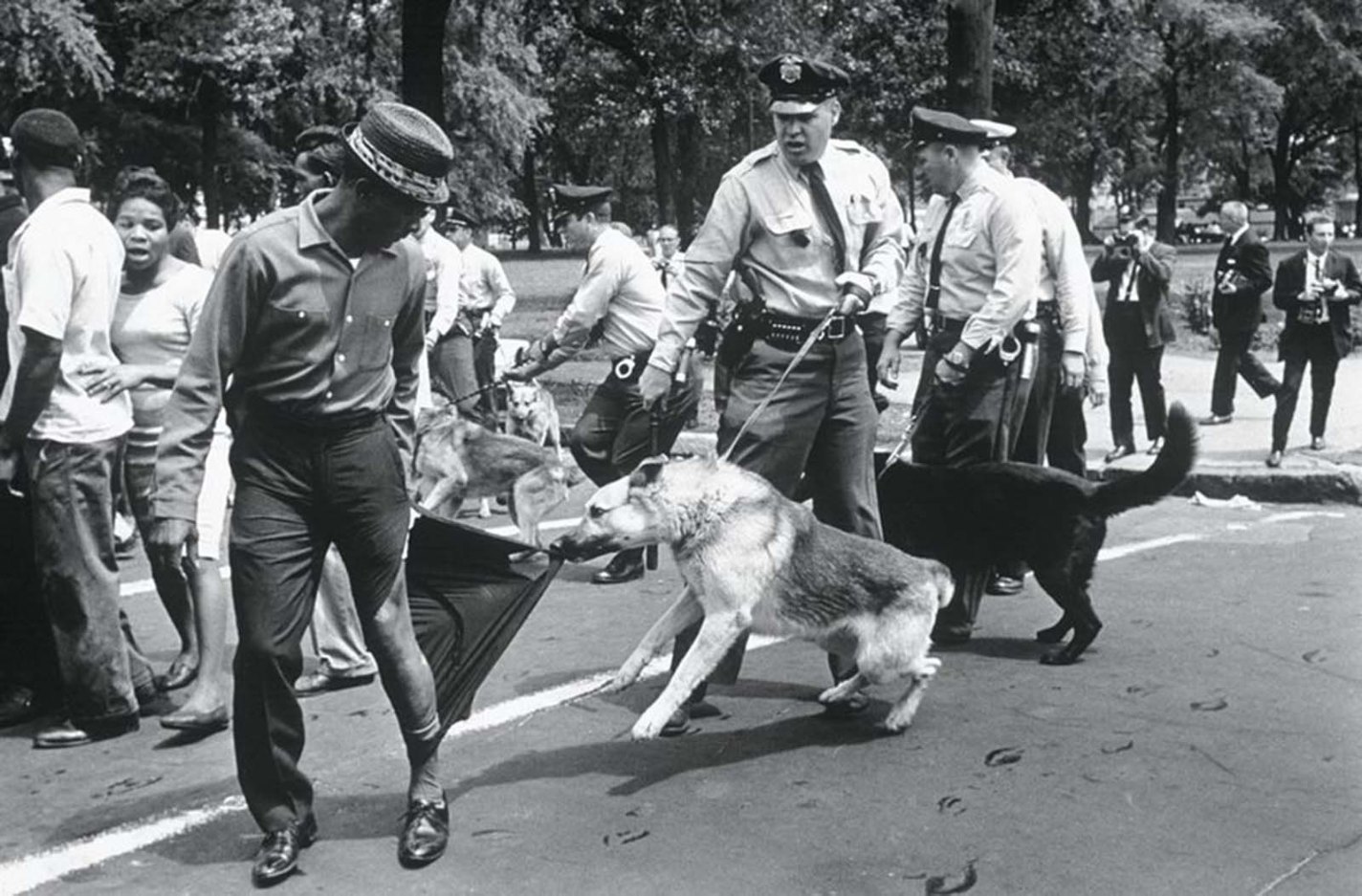
51. Birmingham, Alabama, Charles Moore, 1963.
Photos of the events in Birmingham, Alabama, attracted a lot of attention and were on top of the pages for two weeks. Charles Moore devoted his career to documenting the Civil Rights movement. A few years earlier, he made the photo of Martin King being handcuffed, captured the riot in the University of Mississippi, and in 1963 he was in Birmingham. His photos where police officers launched dogs on the demonstrators, firefighters attacked people with water from pressure-hoses were published in LIFE. Social reaction and President Kennedy’s attention to these events forced the cultural changes in mid 20th century America and made a significant contribution to the Civil Rights Act to be pass
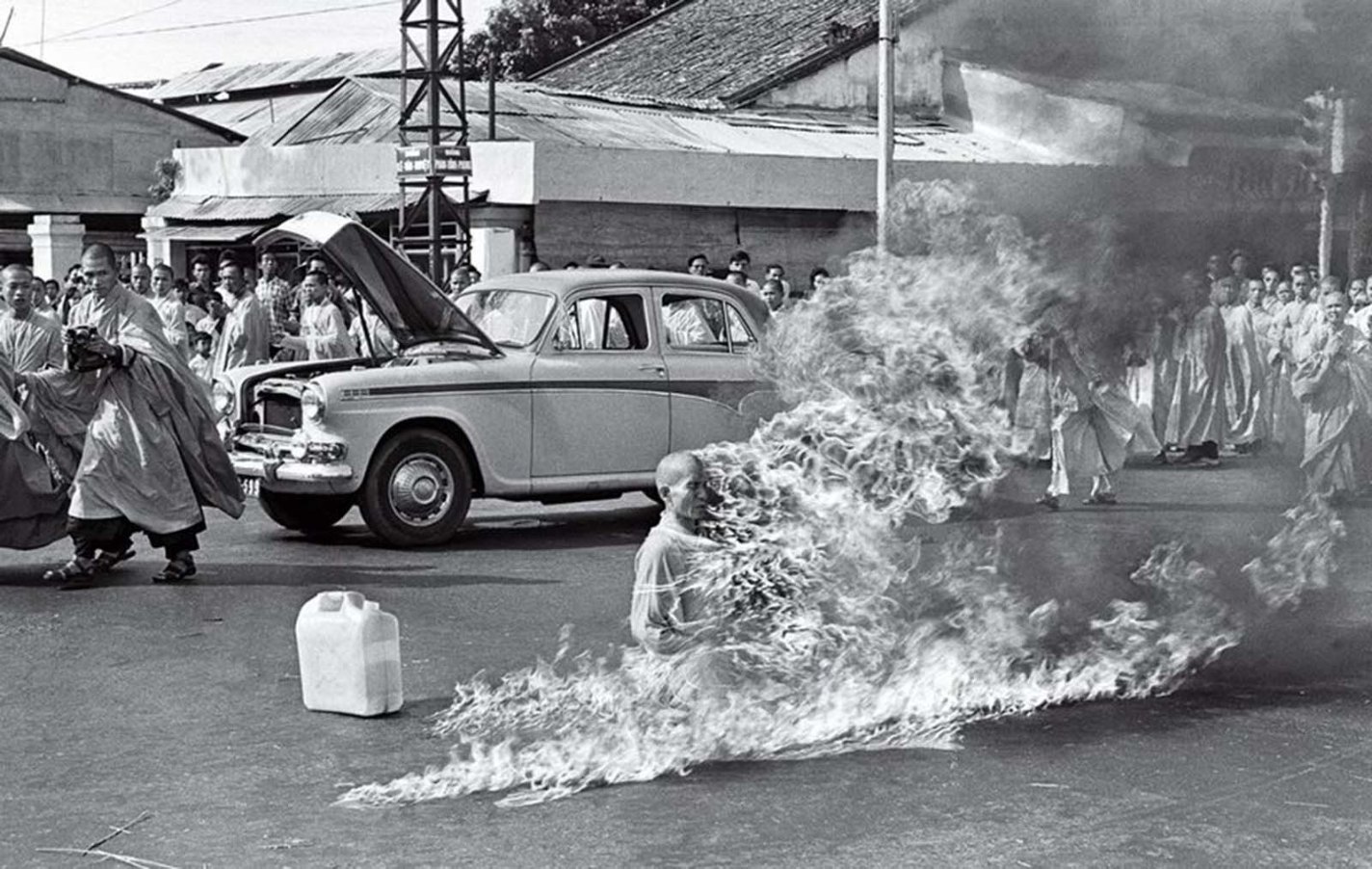
52. The Burning Monk, Malcolm Browne, 1963.
Selfsacrifiction by burning exists for thousands of years in Buddhism. In modern history, it is not common practice and quite a rare event. The day when monk Thich Quang Duc burned himself as a protest against Ngo Dinh Diem’s politics toward Buddhism in the period of the Buddhist Crisis in Vietnam. The photo was replicated worldwide. In Europe, it was used for postcards, and China used it for anti-American propaganda. The single photo turned the whole political situation and affected the ruling regime’s reputation and the end of USA donation into Diem’s government.
The morning newspaper image was so affectional that even President John F. Kennedy was shocked and compared this sacrifice with Christian martyrs during the Roman period.
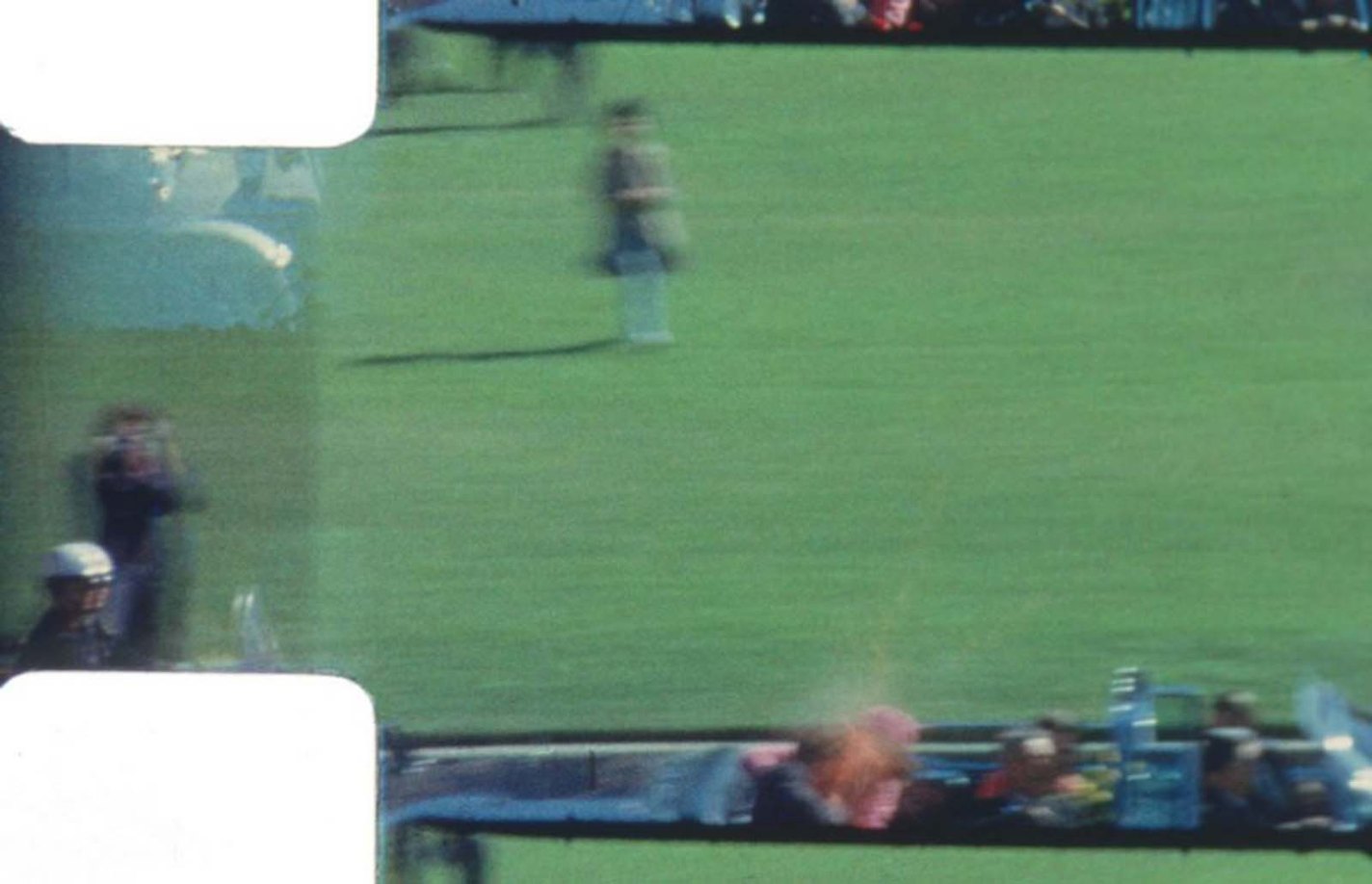
53. JFK Assassination, Frame 313, Abraham Zapruder, 1963.
Abraham Zapruder was not the only one who captured the assassination of John F. Kennedy, but his little tape is the most accurate and informative. It became crucial evidence in the Warren Commission hearings. The black-white film was purchased by LIFE magazine for $150,000 and published as a series of photos, some of them were colored for special “John F. Kennedy Memorial Edition.”
The public interest in Kennedy’s death details induced the spreading of the photo and film, and it became a part of history. Its quality has been improved, and the length varied from copy to copy, the gruesome frames became iconic. The 313 probably is one of the most influential – smashed President’s head with blood splash as a horrible sign of life’s finiteness.
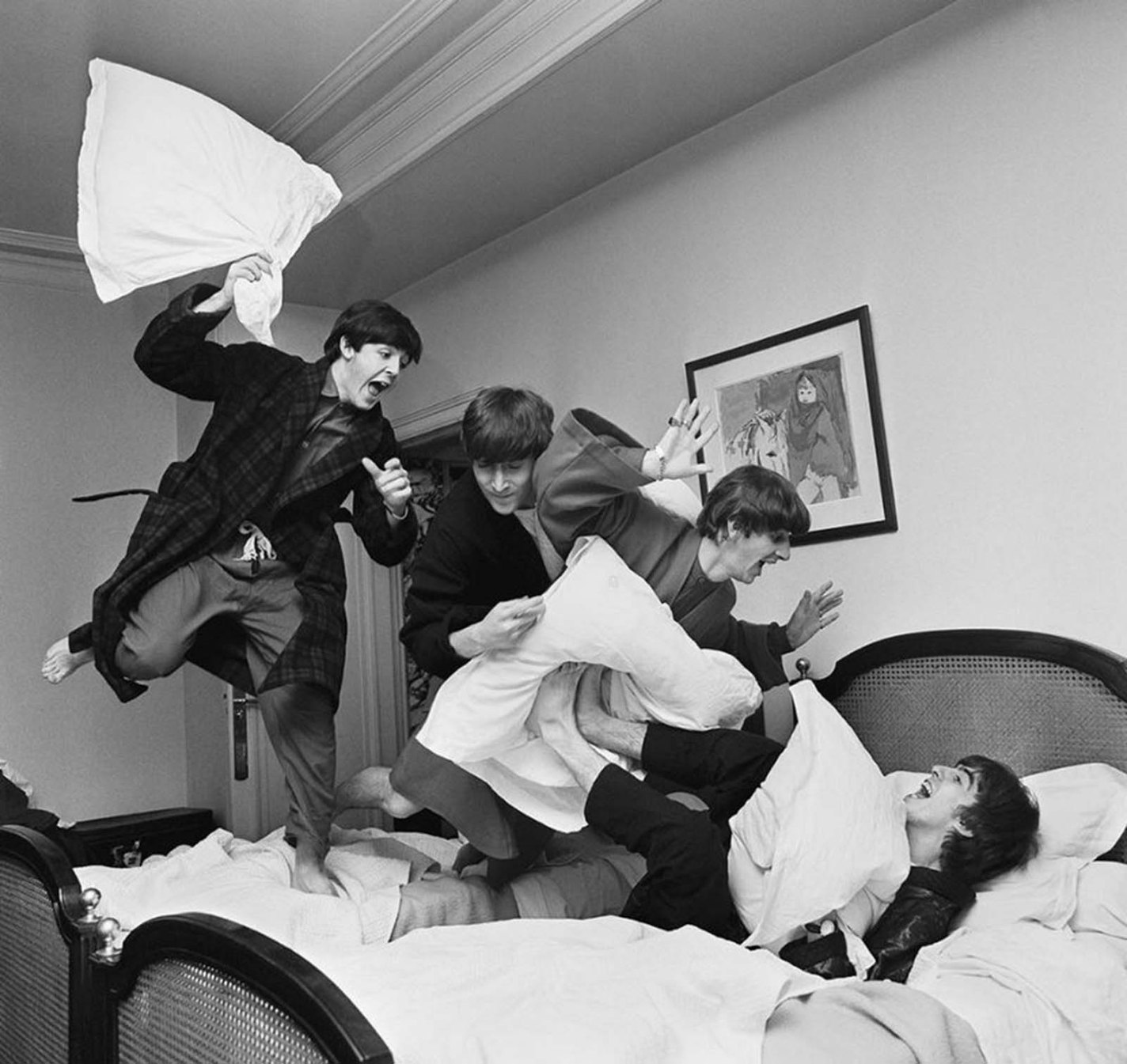
54. The Pillow Fight, Harry Benson, 1964.
Harry James Benson dreamed of being a serious photographer and wasn’t very excited when his publisher gave him the task to accompany The Beatles on their trip to Paris. After acquaintance, Benson was charmed by the music and personalities of the Fab Four. Once before the show, he heard about pillow fights between boys and thought about taking photos. The famous image was taken in the evening when the Beatles celebrated the first place of the song “I Want to Hold Your Hand” in the USA charts. Despite trying not to be “silly and childish,” the Fab Four started a new pillow fight. Later Benson compared this photo with Raising the Flag on Iwo Jima due to its dynamics. The next morning the picture was published in the UK. A rock music history started a new chapter with this photo.
This collaboration with the band helped Benson to become one of the most celebrity photographers.
Rock music photo history of the 60s in 33 pictures
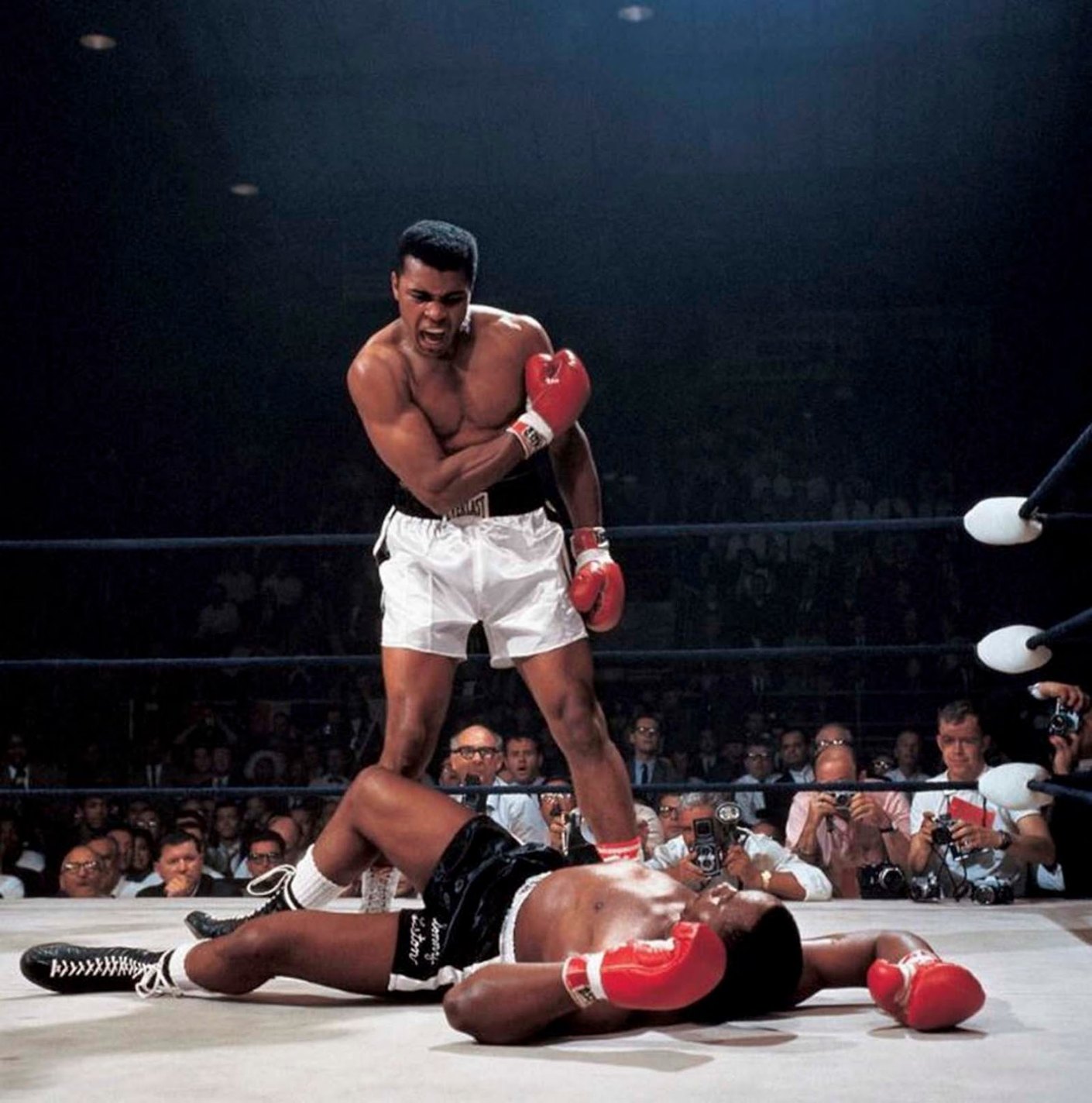
55. Muhammad Ali vs. Sonny Liston, Neil Leifer, 1965.
A full story behind this photo
The iconic photo of Muhammad Ali yelling, “Get up and fight, sucker” over his opponent Sonny Liston after the first hit, considered the most excellent sports photography. Neil Leifer was lucky to be on the right seat that day to take the moment that demonstrated the boxers’ fight rush and adrenaline when punching the other’s face.
The atmosphere and light in the ring sides were perfect for capturing several great pictures, but the one full of expression and fury nailed the world. Another great photo in boxing history!
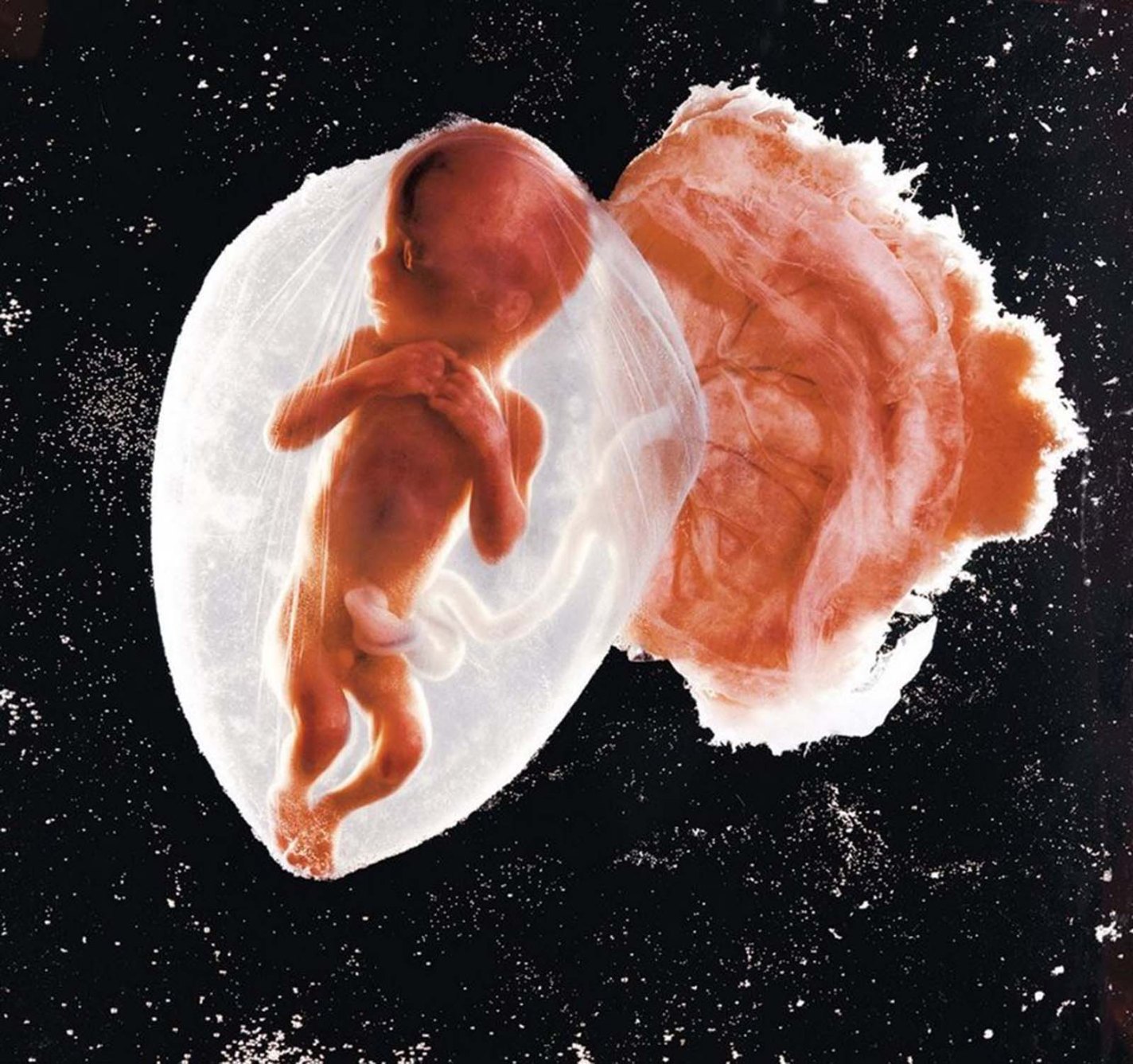
56. Fetus, 18 weeks, Lennart Nilsson, 1965.
Lennart Nilsson’s interests in science and photography resulted in the unveiling to the broad public how a developing fetus looks like. Swedish photographer used various tricks to take a photo of human embryos inside and out of the womb. Except for fetuses, Nilsson took photos of vessels and body cavities in the living human body. Some of these and other Nilsson’s photos were used for the Voyager program and were sent in space.
LIFE issue with prenatal color historical photos is one of the most popular until now – the ultrasound equipment was already used in medicine. Still, obtained images even now are of low quality. Later Nilsson published an illustrated book for mothers, which also is very popular.
The images are so captivating, and they are widely used, often breaking copyright (for example, in anti-abortion campaigns).
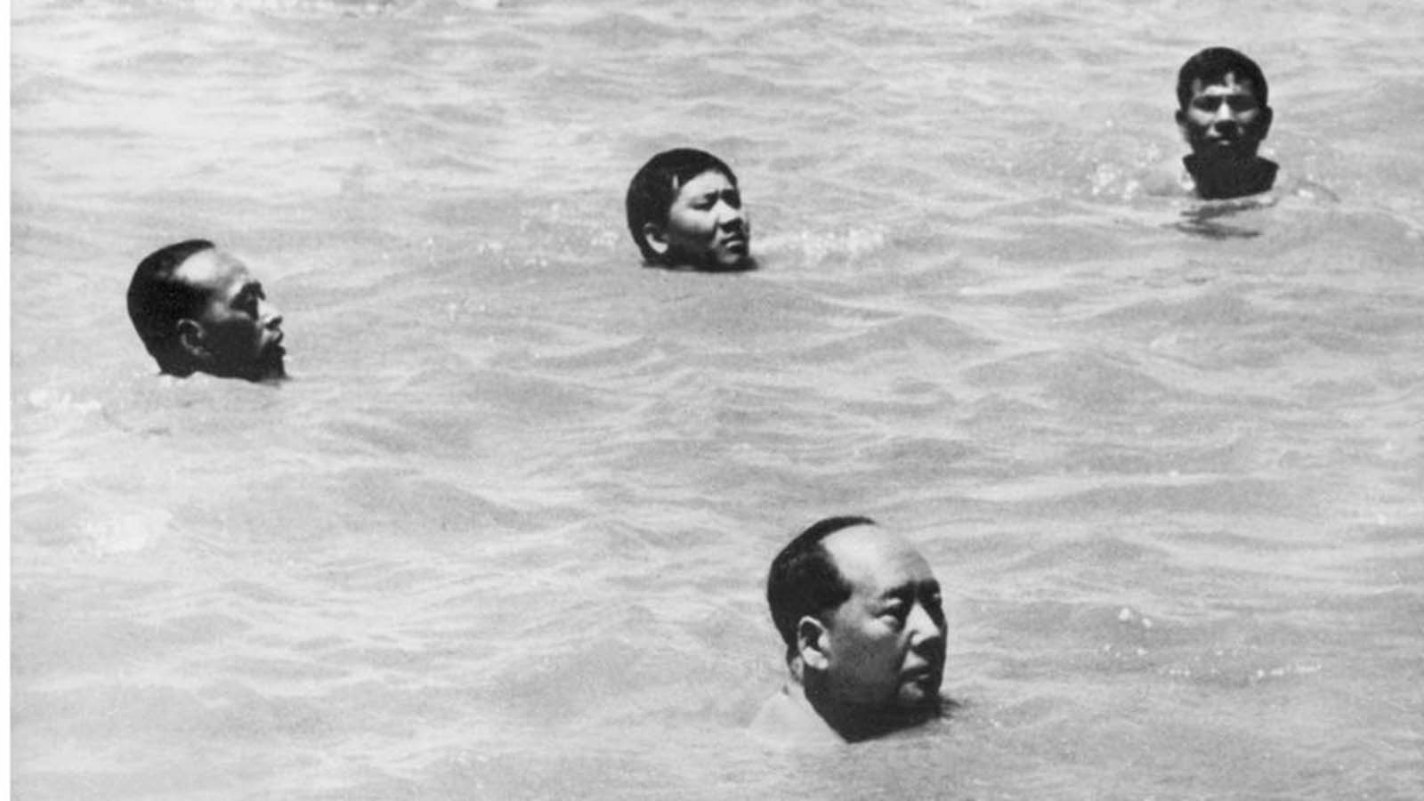
57. Chairman Mao Swims in the Yangtze, Lv Houmin, 1966.
A full story of this historical photo
In 1966, to run the wheels of propaganda 72-year-old, Mao Zedong decided to show his physical strength. He joined Wuhan’s 11th annual Cross-Yangtze Competition and swam for 65 minutes, surrounded by bodyguards. The event was pompous – together with Chairman Mao, his big portrait with the wish for health and long life was put on the water. Since that, July 16 has become a national swimming day, and it is celebrated every year.
It was a show before the Great Proletarian Cultural Revolution. After demonstrating his wellness, Chairman Mao criticized party leaders. He claimed a new order, “Sixteen Points,” which inspired youth to stand against corrupted teachers and resulted in the Red Guards movement. Here’s how one photo can start a new round in the history of the whole country.
The photographer who captured these historical photos passed away in 2007.
Interesting fact: Mao was about to lose his power before this famous swim. Comrades attacked him for his ‘Great leap’ reforms, which led to crisis and famine.
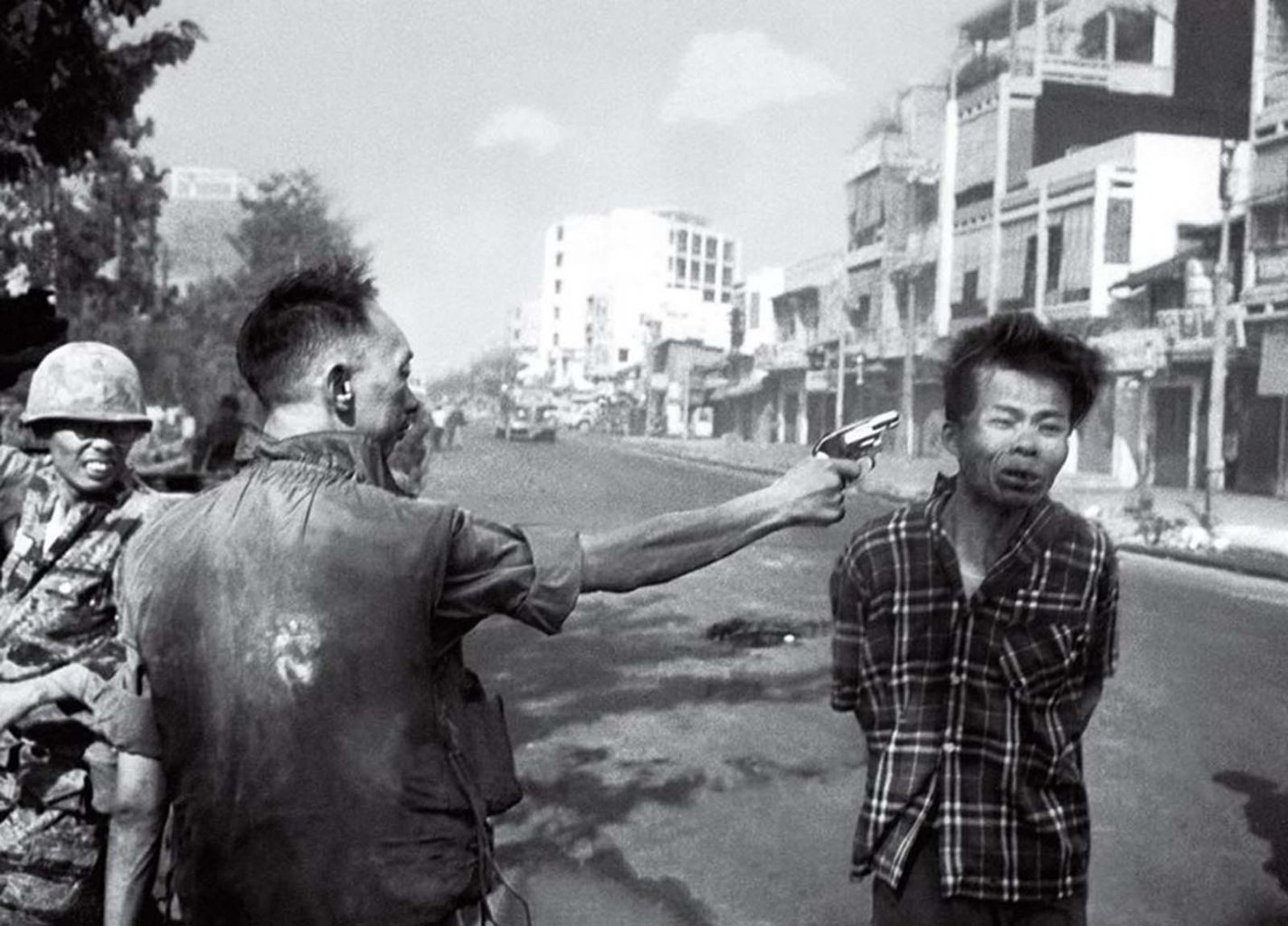
58. Saigon Execution, Eddie Adams, 1968.
A full story of this historical photo
Atrocities are common during the war. The waiting death affects even the most resistant, and the vengeance pushes deeds to the limits. When Brigadier General Nguyen Ngoc Loan was killing a Viet Cong activist who murdered a policeman and his whole family, he couldn’t imagine how the photo of this moment affects his future and Vietnam situation. The picture became one of the most known images of the Vietnam war. Photographer Eddie Adams was awarded for this image with a Pulitzer Prize but refused the prize. As he said later, “Two people died in that photograph: the recipient of the bullet and General Nguyen Ngoc Loan. The general killed the Viet Cong; I killed the general with my camera.” In fact, this photo didn’t kill the general but became a part of the Vietnam War history instead.
Interesting fact: Nguyen Ngoc Loan emigratU.S. to the US and even opened his pizzeria, but the nightmares of this image haunted him till the end of his days.
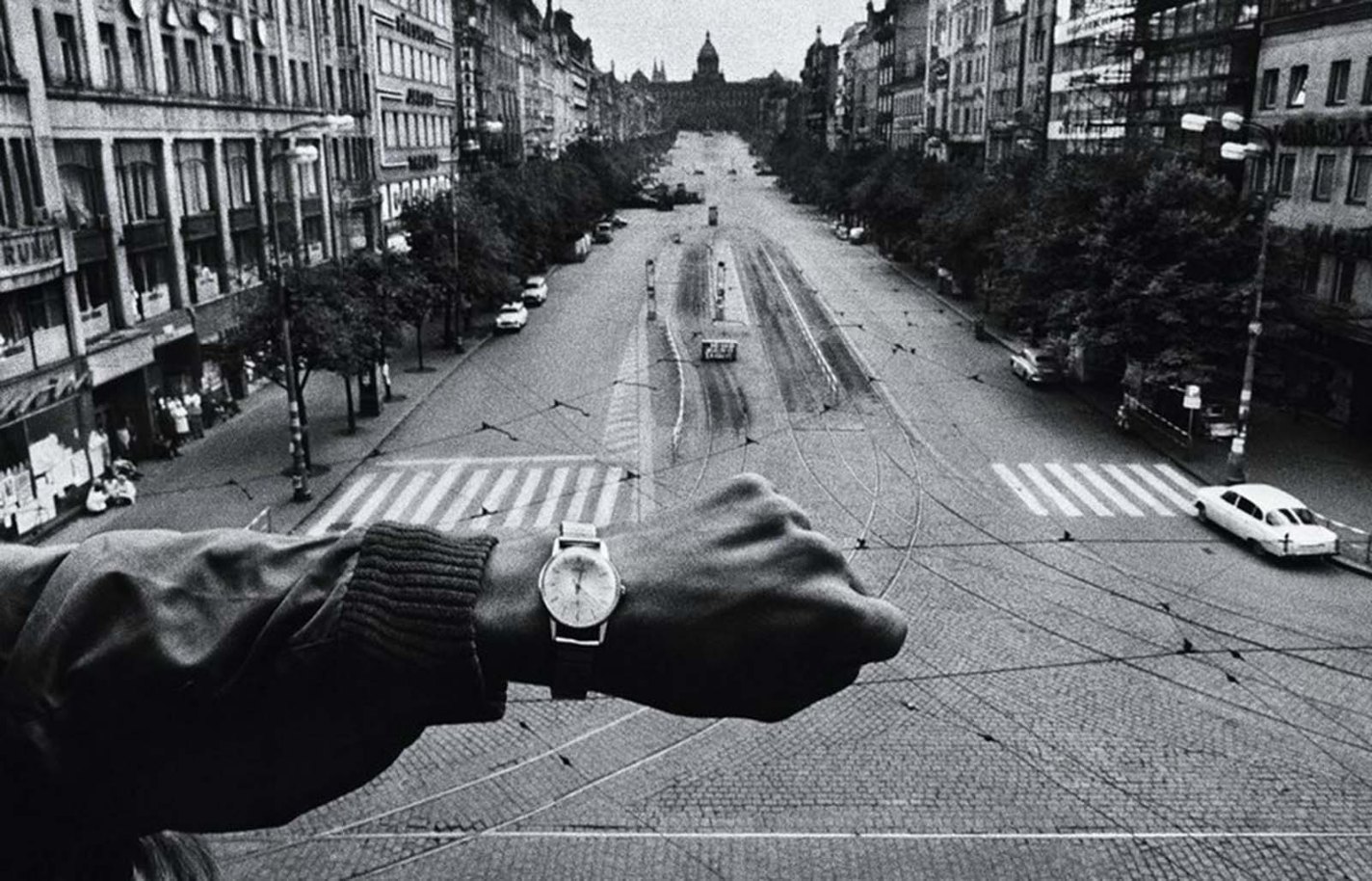
59. Invasion of Prague, Josef Koudelka, 1968.
Democratic reforms of Alexander Dubcek in Czechoslovakia frightened the Soviet top due to the possibility of losing a stable region. The Eastern Bloc’s power was under question, so to prevent it’s splitting, troops of Warsaw Pact countries (mostly the USSR) invaded Czechoslovakia.
Josef Koudelka, a theatre photographer, captured the end of the Prague Spring. On the background of an empty street, he took a photo of his hand with the watch. He sent this and many more photos in The Sunday Times as Prague Photographer, where the images were published. His courage brought him an award – Overseas Press Club’s Robert Capa Gold Medal.
This photo captured the moment of history, which put the country on pause for the long decades until the USSR collapsed.
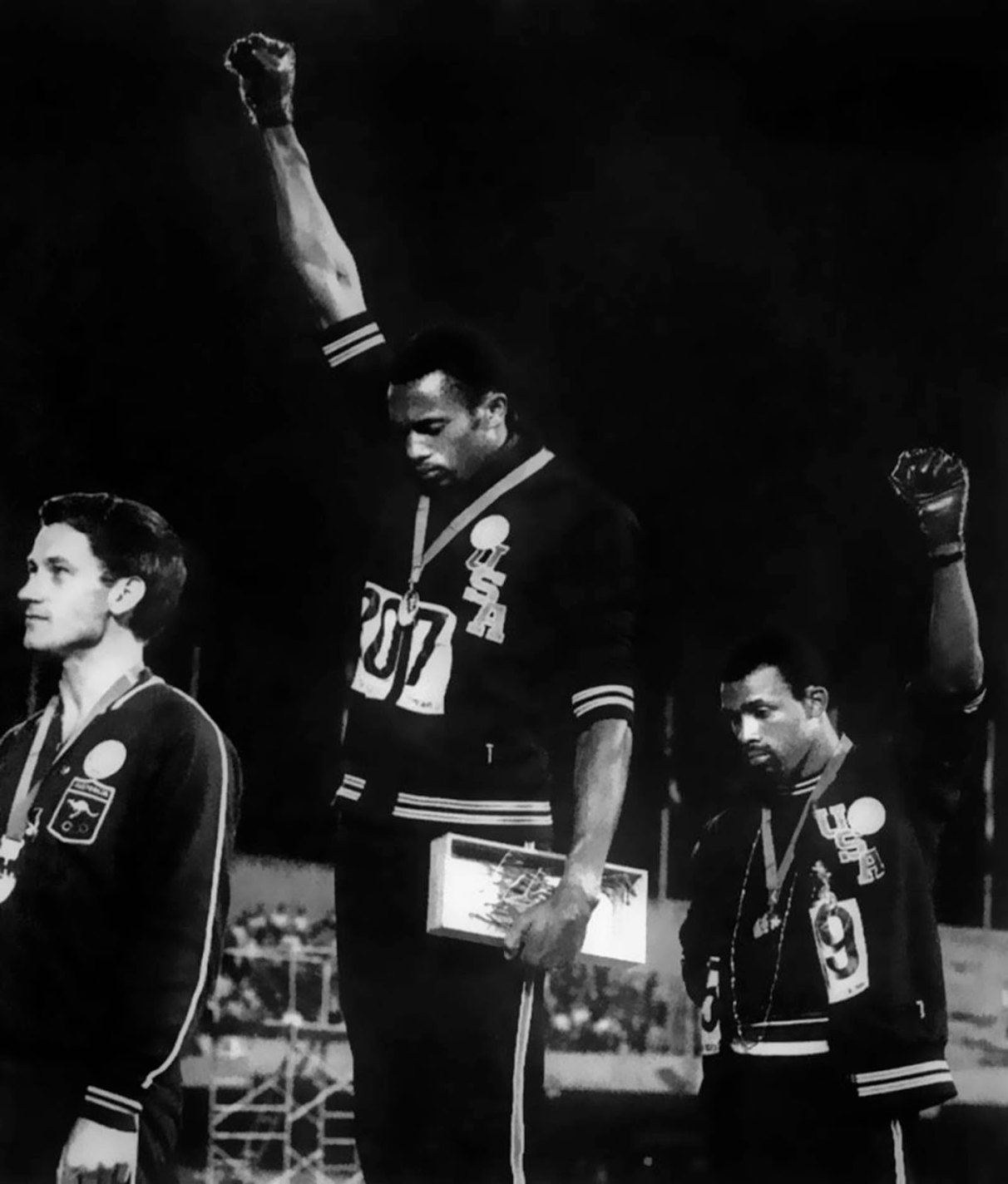
60. Black Power Salute, John Dominis, 1968.
Black Power Salute, captured by John Dominis, had a vast public resonance. The Olympics supposed to be apolitical, but the deed of African-American medal winners, instead of being considered a “human rights” salute, was claimed to be the most political statement during the games ever. The shaming and criticism of the Black Power Salute by the International Olympic Committee was very subjective: years before the Nazi salute was acceptable. All three sportsmen careers were affected: Tommie Smith and John Carlos were excluded from the Olympic village and, after returning home, faced ostracism. Australian athlete Peter Norman was criticized for joining the protest, wearing the same badge. This photo is a tipping point in the civil rights movement history.
Only decades after, the Black Power Salute was accepted as a heroic protest against racial inequality.
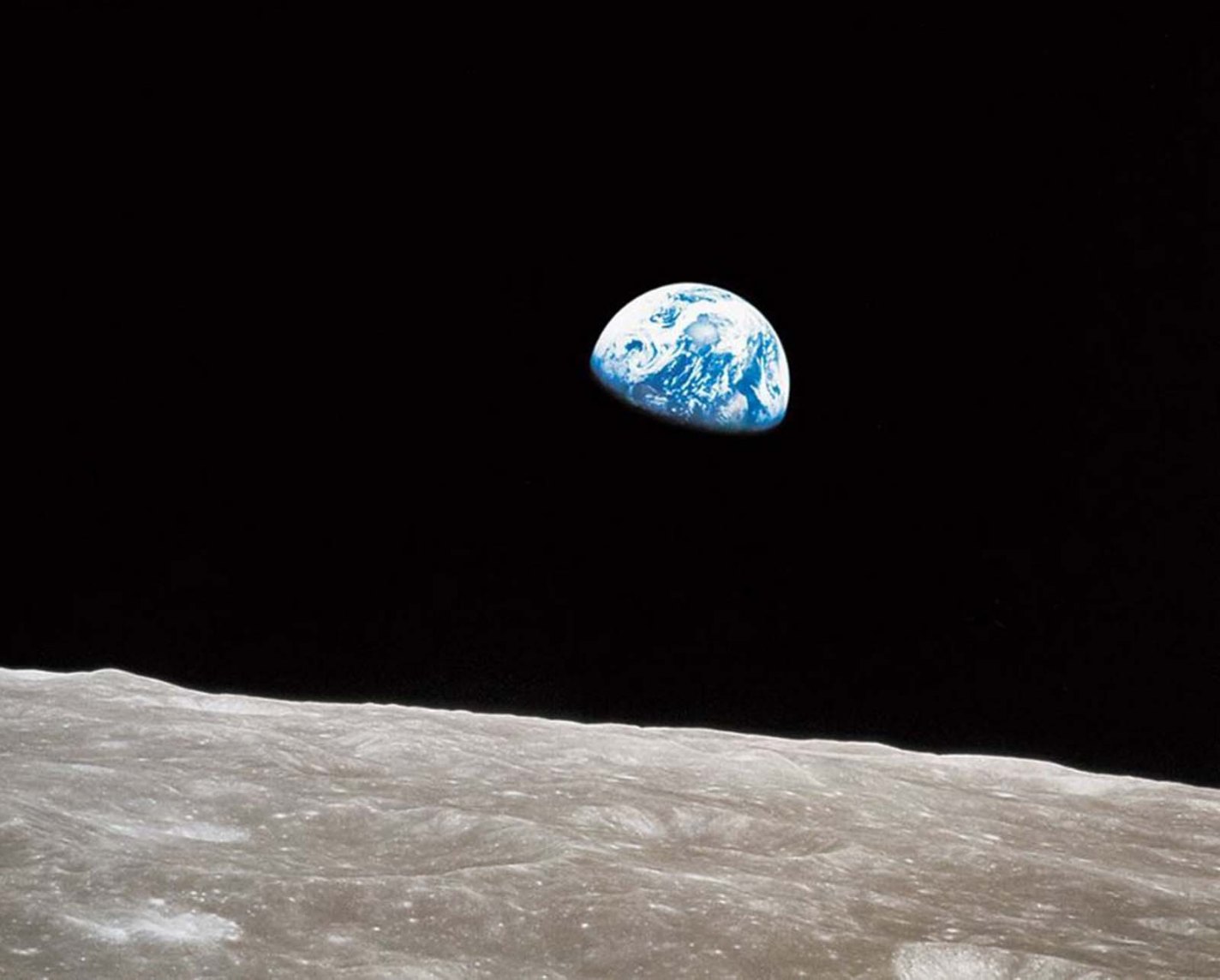
61. Earthrise, William Anders, NASA, 1968.
The first color photograph of the blue planet was made amid the Cold War: the American lunar program was very importanU.S.for the US image in the political arena. Successful orbiting the Moon, ten spins around our satellite and returning home took six days. It was a huge achievement for the space exploration, and it was one of the most excellent historical photos.
During this mission, space-craft crew Frank Borman, James Lovell, and William Anders take a series of close photos of the Moon surface for the next task of Lunar landing and the most famous earth space photo: Earthrise. This Christmas present for all humanity. The fragility and uniqueness of our planet can be seen only from a distance: as William Anders once said, “We set out to explore the moon and instead discovered the Earth.”
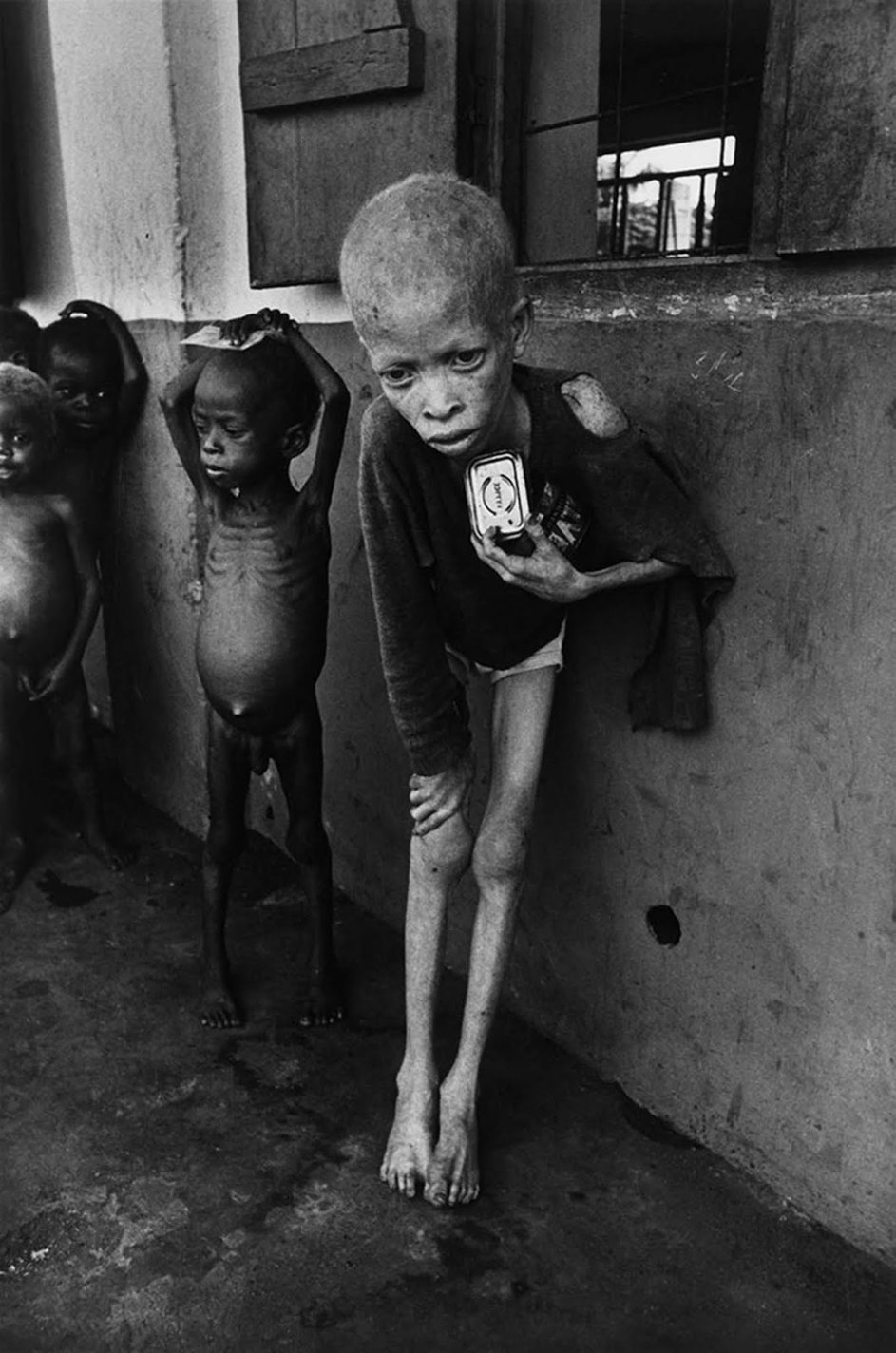
62. Albino Boy, Biafra, Don McCullin, 1969.
In many African religions, albino people are stigmatized as cursed, or their body parts are used in rituals. The separation of Biafra from Nigeria and it’s military reattachment resulted in an economic crash, hunger, and hard times for all the Biafrans. But even in this situation, albinos were on the bottom. Don McCullin captured total despair in the eyes of a 9-year-old albino child. As he wrote, “To be a starving Biafran orphan was to be in a most pitiable situation, but to be a starving albino Biafran was to be in a position beyond description. Dying of starvation, he was still among his peers an object of ostracism, ridicule, and insult.” The image was so powerful that many countries sent humanitarian aid and inspired the Doctors Without Borders movement’s launch. Some of the historical photos scenes are too hard to carry.

63. A Man on the Moon, Neil Armstrong, NASA, 1969.
Neil Armstrong and Buzz Aldrin were the first people on the Moon. The first step was made by Armstrong, who carried a photo camera and made the photo of Aldrin on the space and lunar soil background. His historical photos series symbolize one of the most amazing achievements in human history.
The line “That’s one small step for [a] man, one giant leap for mankind” perfectly suits the photo where Aldrin is walking toward Armstrong in a complicated spacesuit. The reflection of the photographer and lunar module in the helmet’s visor and the lights from lightens proves how tiny humans are compared to the universe.
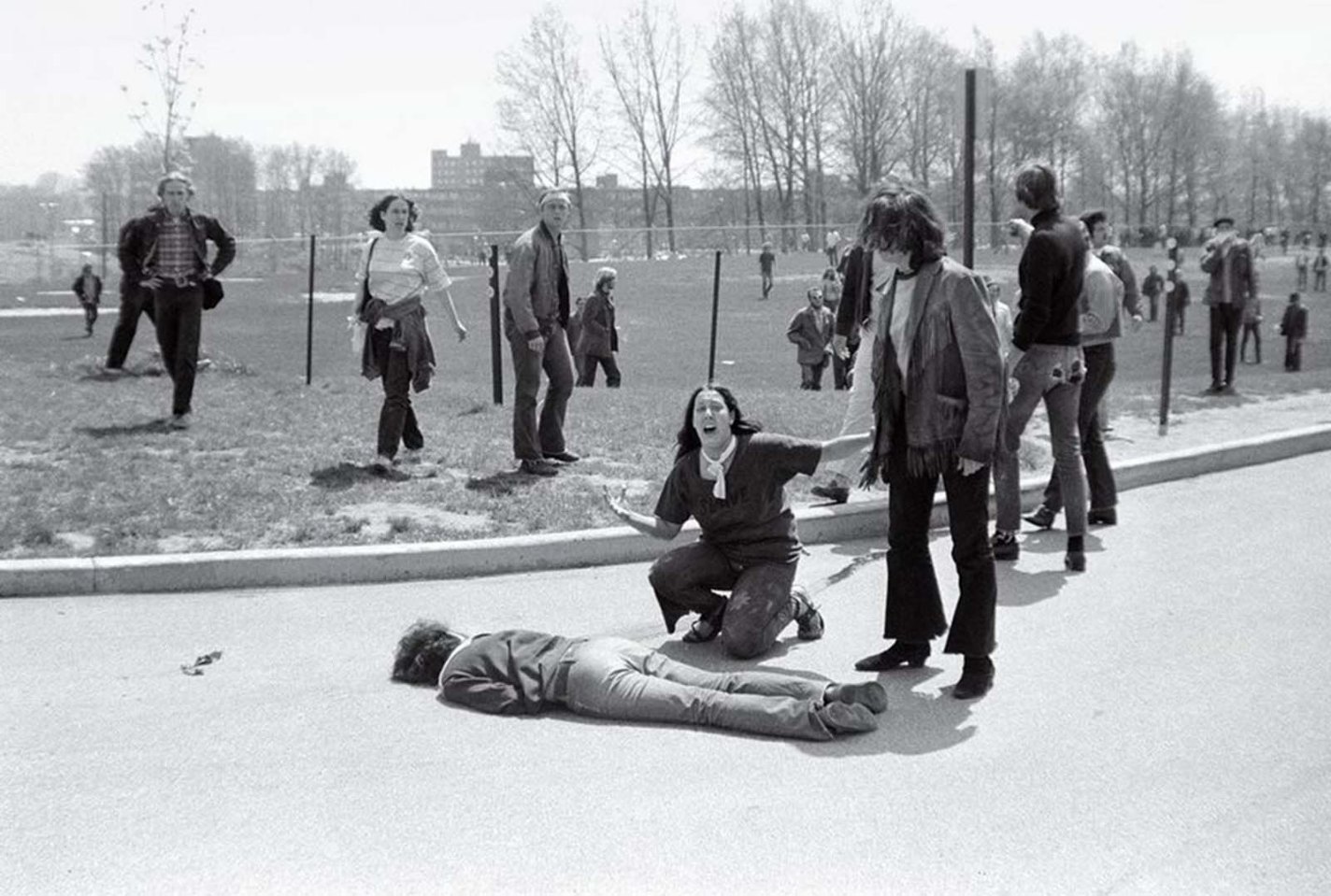
64. Kent State Shootings, John Paul Filo, 1970.
Student demonstration against the war in Southeast Asia was shooted with real fire. Why the National Guard soldiers used weapons against peaceful demonstrators and other people on the campus remains unknown. Four students were killed, and nine were injured. John Filo could be among the dead if the soldier didn’t miss. Instead of running away, a young photographer started to take photos.
The one where Mary Ann Vecchio cries over the body of Jeffrey Miller brought him the Pulitzer Prize. The incident resulted in mass student protests and mass movements against the Vietnam War.
That day became remarkable in pop culture and inspired many songs and movies.
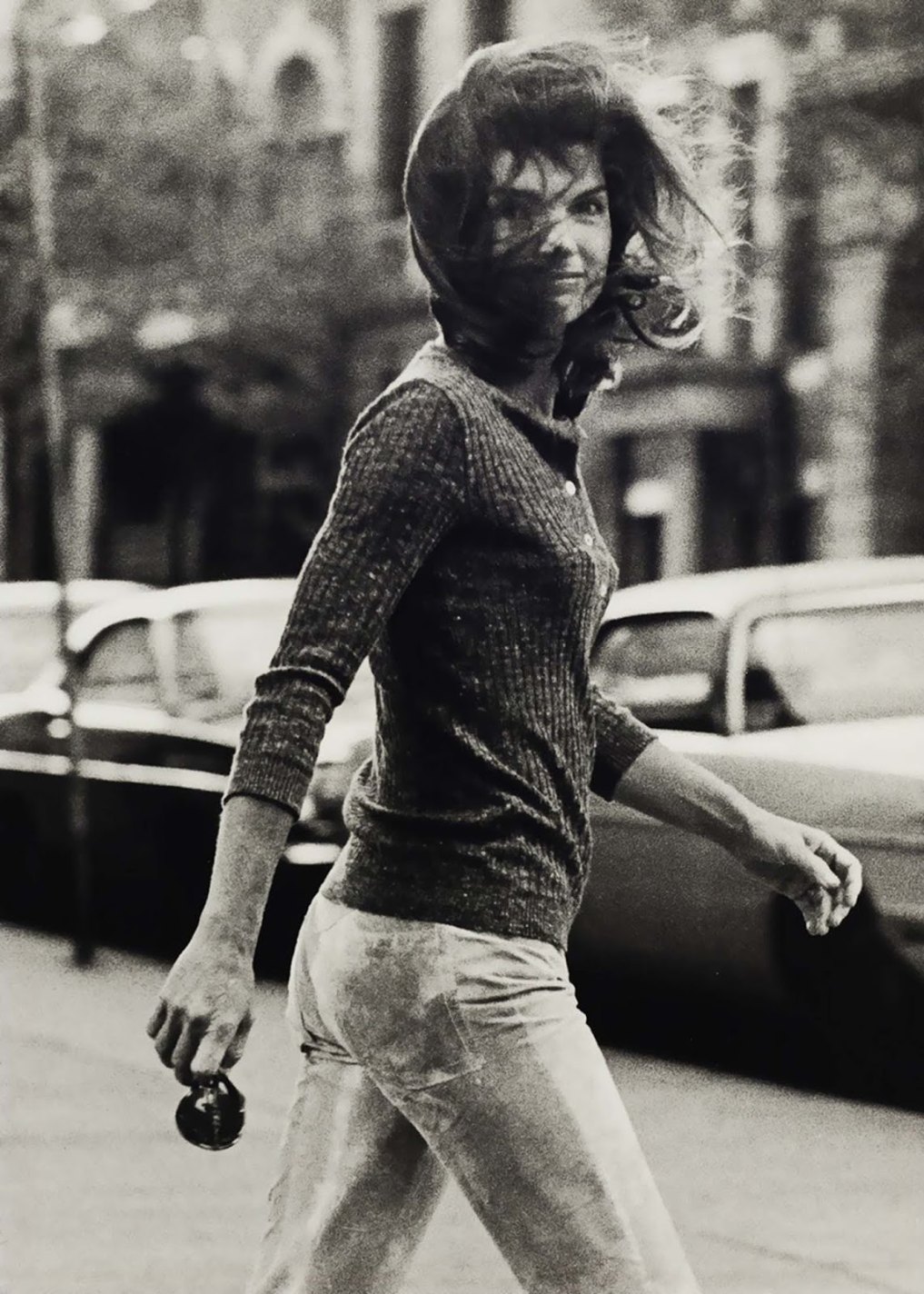
65. Windblown Jackie, Ron Galella, 1971.
Ron Galella set all annoying paparazzi approaches to get pictures of celebrities. Jacqueline Kennedy Onassis was his real obsession – he followed her almost everywhere. He was suited several times for crossing the restraining order of 50 yards to keep away from the ex-First Lady.
Mrs. Onassis was not the only one who suffered from being interrupted by Galella. Like Marlon Brando, some of them were so irritated by the photographer that the physically assaulted him. He was beaten by Richard Burton’s, Elvis Presley’s, and Brigitte Bardot’s security guards.
But your picture will never hit the list of historical photos if you obey all rules!
Often Galella tried to go for the court to claim the compensation for traumas.
Anyway, this photo was mainly made accidentally, probably Jacqueline even didn’t notice who held the camera – she was almost smiling. Janella called this picture “my Mona Lisa.”
Despite his inappropriate methods, he did a great job. For example, Elizabeth Taylor, even being mad, used his photos in her autobiography.
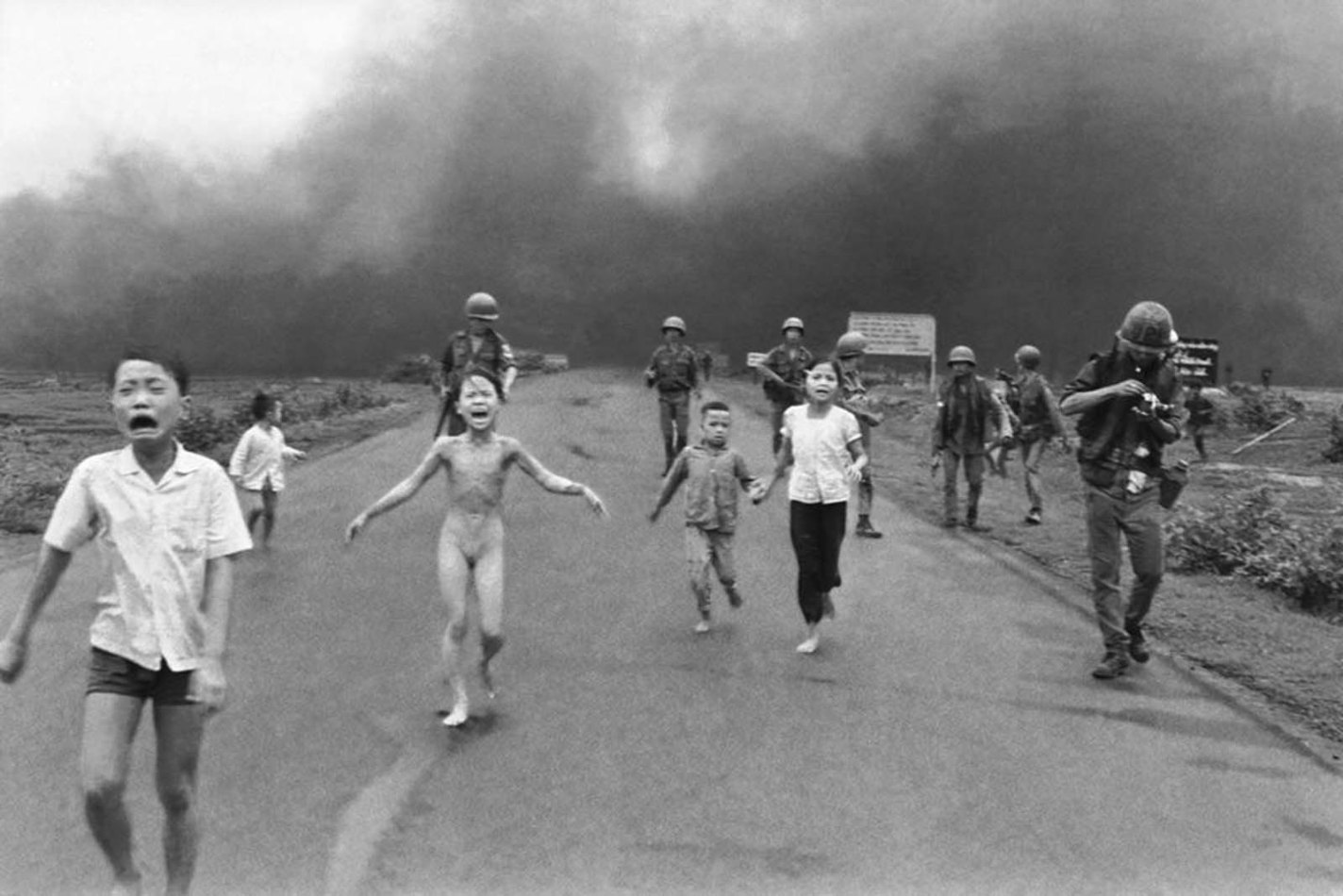
66. The Terror of War, Nick Ut, 1972.
A full story behind and more historical photos
On June 8, 1972, battles were fought between the Viet Cong and the troops of the pro-American South Vietnamese government in the village of Changbang (Tainin Province). Civilians left the town. The pilot of the South Vietnamese Air Force mistook them for Viet Cong soldiers and began dropping napalm bombs. The photograph shows nine-year-old Kim Phuk running in tears from her older brother, twelve-year-old Phan Thanh Tam, her younger brother, five-year-old Phan Thanh Phuok, cousins of Ho Wang Bo and Ho Thi Ting.
Kim Phuk had 30% of skin burned from the explosive, and Nick Ut took her to the hospital.
There was a fierce debate over the publication of the photograph: the girl was naked, and the editor rejected a photo, but its value was more than nudity prohibition.
The photo became a painful demonstration of war realities, where life doesn’t matter. Its’ impact was so pU.S.minent, US President Richard Nixon, in a conversation with the HeU.S. of the US Presidential Administration, G. R. Haldeman doubted its authenticity and suggested that it could be falsified.
In 1973 Nick Ut won the Pulitzer Prize for his Vietnam historical photos.
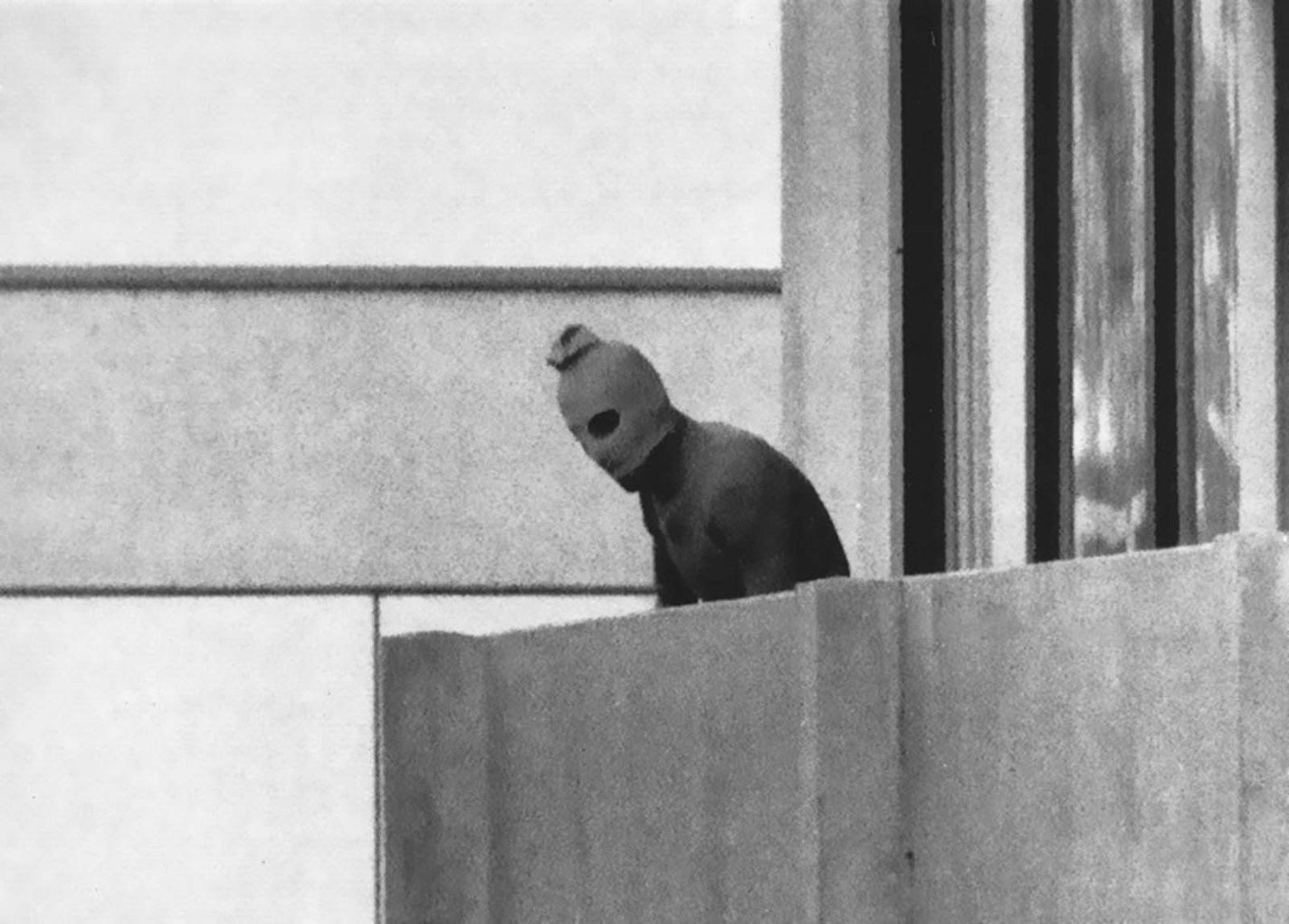
67. Munich Massacre, Kurt Strumpf, 1972.
More pictures and facts about these historical photos
The attack on the Munich Olympics – a terrorist attack committed during the Olympic Games in Munich in 1972, by members of the Palestinian organization Black September, which killed 17 people – 11 members of the Israeli Olympic team (4 coaches, 5 participants competitions and two judges) and one West German police officer. Some of them were roughly tortured.
By the time of the hostage-taking was the second week of the Olympics. The Olympic Committee of West Germany maintained an open and friendly atmosphere in the Olympic village to erase memories of the wartime German. The Olympic village’s security regime was intentionally weakened, and that athletes often entered the town without showing passes.
During a failed attempt to free the hostages, 5 of 8 terrorists were killed by special forces. Three surviving terrorists were captured but later released by West Germany after the Lufthansa airliner’s capture by Black September.
The Olympics’ tragedy has prompted many European governments to create permanent professional counter-terrorism units of constant readiness or to reorganize existing units for this purpose. Influential weapon designers and manufacturers have launched new types of weapons that are more suited to counter-terrorism.
Kurt Strumpf took the historical photos of one of the terrorists on the balcony, and it became the symbol of a new era of terror history, where nobody is safe.
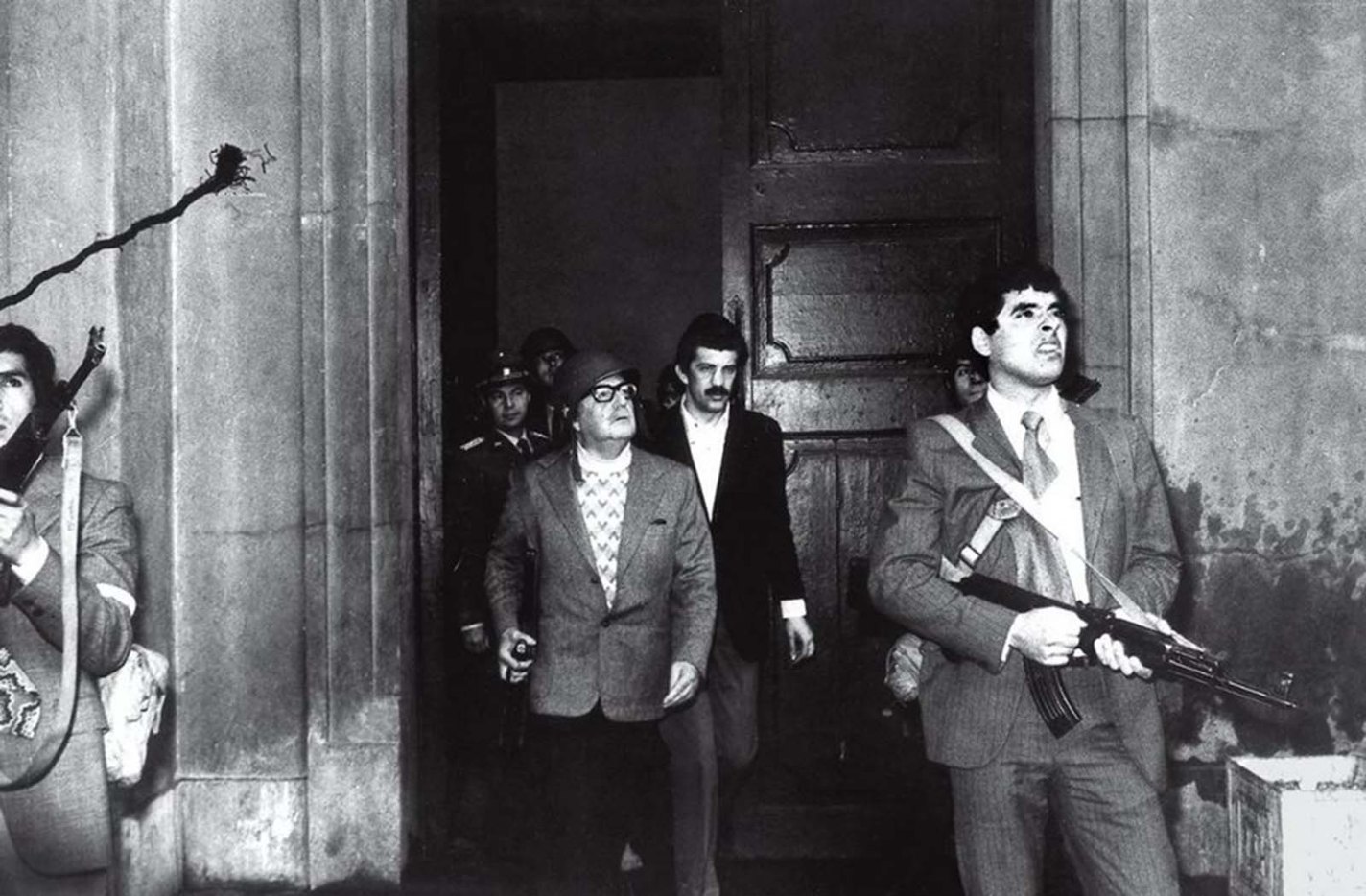
68. Allende’s Last Stand, Luis Orlando Lagos, 1973.
A full story about these historical photos series
Salvador Allende, who won first place in the 1970 presidential election, did not support the vast majority of voters. USSR sponsored his election campaign to get a socialistic leader near the USA.
Having come to power, the socialists, as promised, began to engage in mass expropriations of land and enterprises. Immediately all the largest private companies and banks were nationalized.
During nationalization, tensions with the United States arose when North American firms that invested heavily in Chile’s smelter industry refused to accept “compensation” for the enterprises they took. However, after Allende came to power in the country, economic growth was observed. At the same U.S.me, the US Central Intelligence Agency expressly admits that President R. Nixon ordered that steps be taken to ensure that the Chilean economy “screams.”
Despite economic growth, inflation was 22.1% in 1971 due to administrative price controls; in the first half of 1972, it rose to 28%, in the second half of 1972, it was 100%, and in the first half of 1973, it was 353%.
This was the background for the 1973 Chilean coup d ‘état. The last stand of Allende was captured by Orlando Lagos, who published it incognito. Lagos was afraid of Pinochet’s regime and hid his authorship his whole life, but this photo became a part of Chilean history. Only after his death, his name was opened for a broad public.
Interesting fact: Luis Orlando Lagos, the photographer, stayed in Chile incognito after the general Pinochet grabbed the power. He stood on the communistic platform until the end of his days.
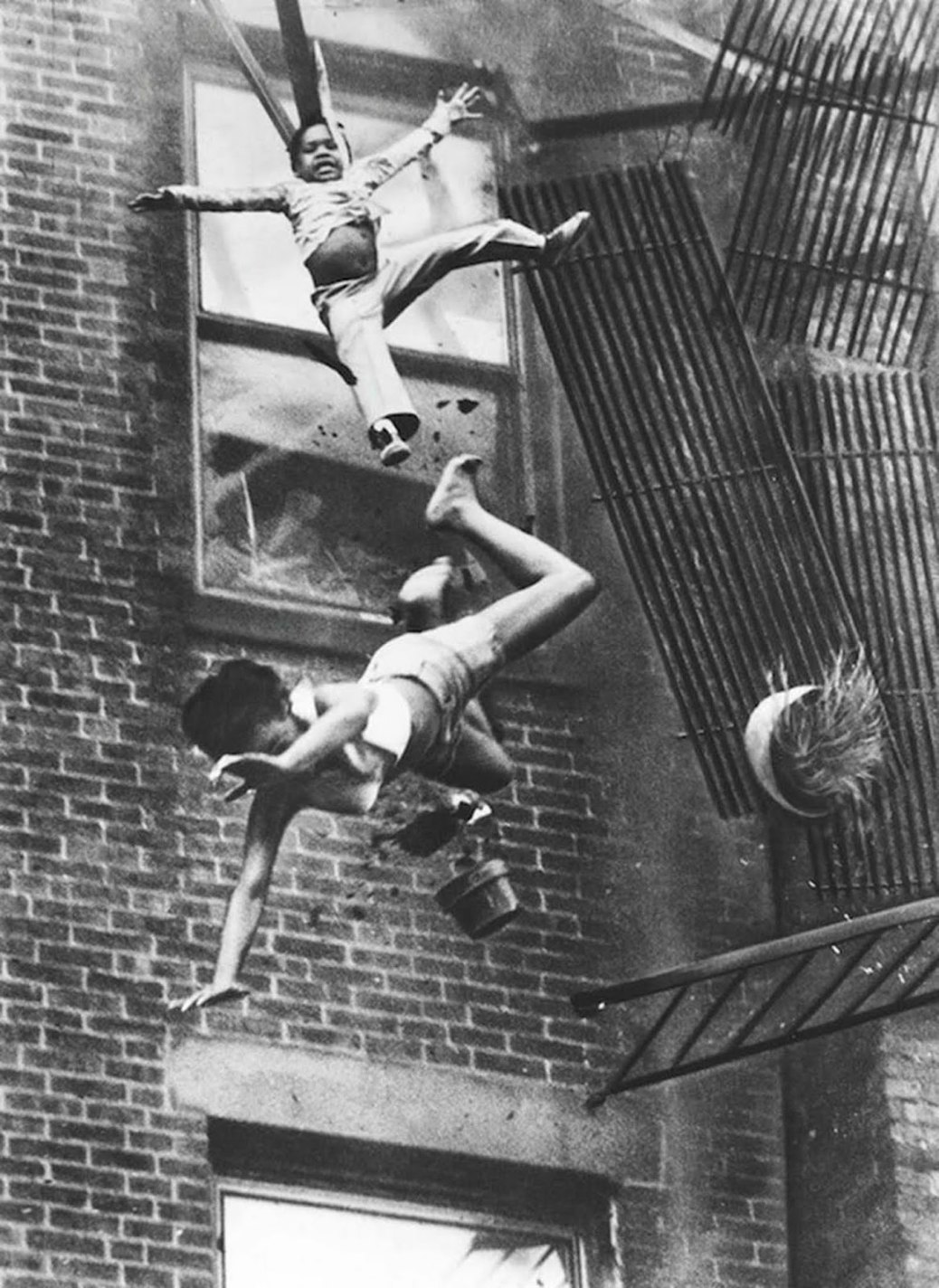
69. Fire Escape Collapse, Stanley Forman, 1975.
19-year-old Diana Bryant was running from the fire with her two-year-old goddaughter Tiare Jones and the fire escape collapsed. Stanley Forman captured the moment when both girls were falling from the fifth floor. Diana didn’t survive, but she saved little Tiare.
Stanley Forman thought he would capture the rescue when firefighters extinguished the flame, but the trigger camera caught the flying victims.
“I was shooting pictures as they were falling—then I turned away. It dawned on me what was happening, and I didn’t want to see them hit the ground. I can still remember turning around and shaking.”
The photo circulated in over a hundred newspapers and was used to force the safety of fire escapes all over the USA. Forman won the Pulitzer Prize, but the photo’s influence was far more than tragedy demonstration – it forced the changes in the fire-escape-safety codes.
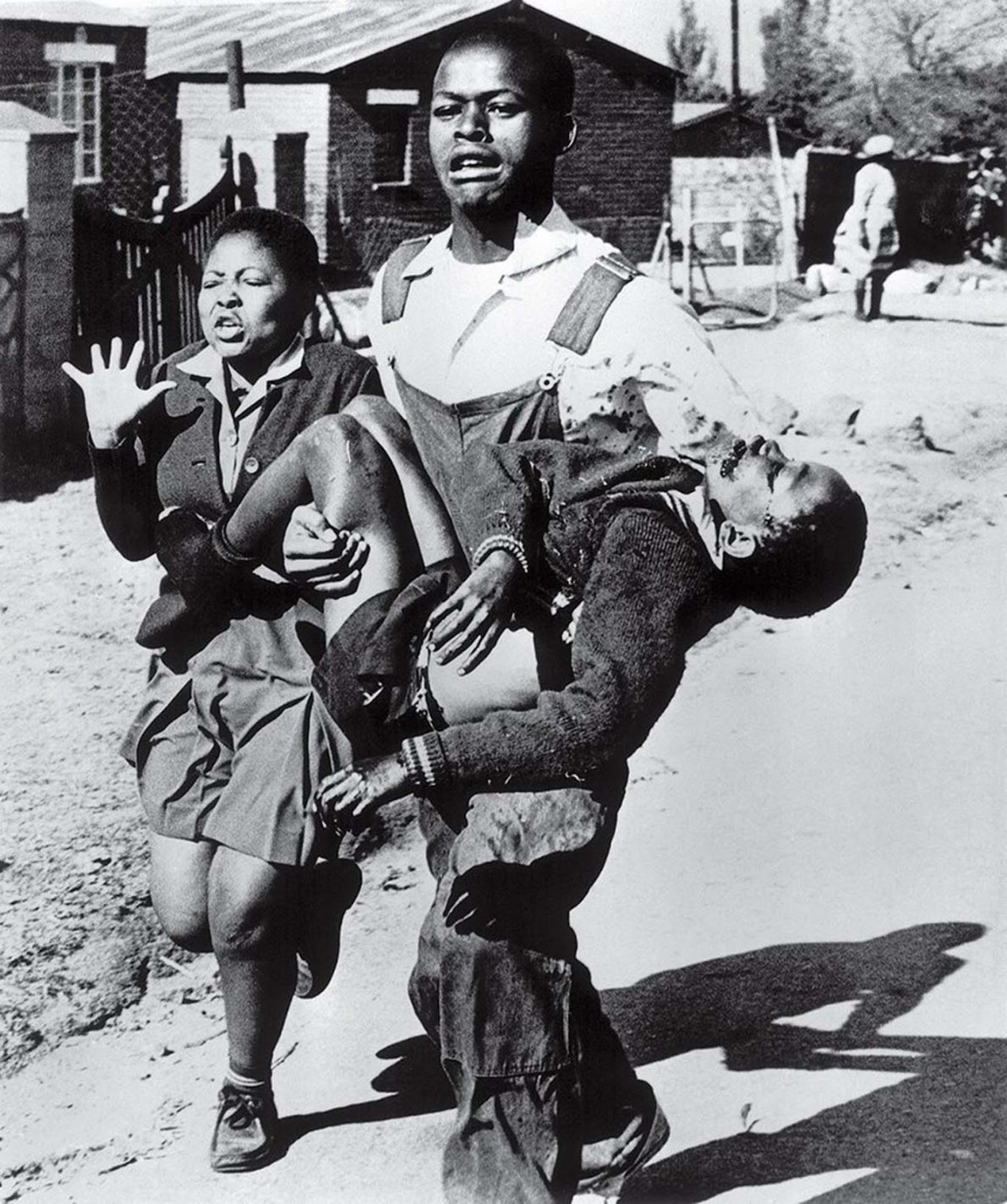
70. Soweto Uprising, Sam Nzima, 1976.
Till 1970th, the politics of apartheid was out of the focus of world governments. Photos taken by Sam Nzima were the turning point when segregation couldn’t be ignored: RSA faced economic and political sanctions from other countries, which forced the fade of the apartheid era.
In 1976 thousands of colored schoolchildren and students protested against mandatory Afrikaans-language studying in schools. The massive protests started with Soweto students who did not go to school and gathered at a local stadium. Police began shooting children and killed 13-year-old Hector Pieterson.
The RSA government didn’t want to show the world situation where power kills its county’s population, so the publication of the photograph cost Nzima years of hiding from the police.
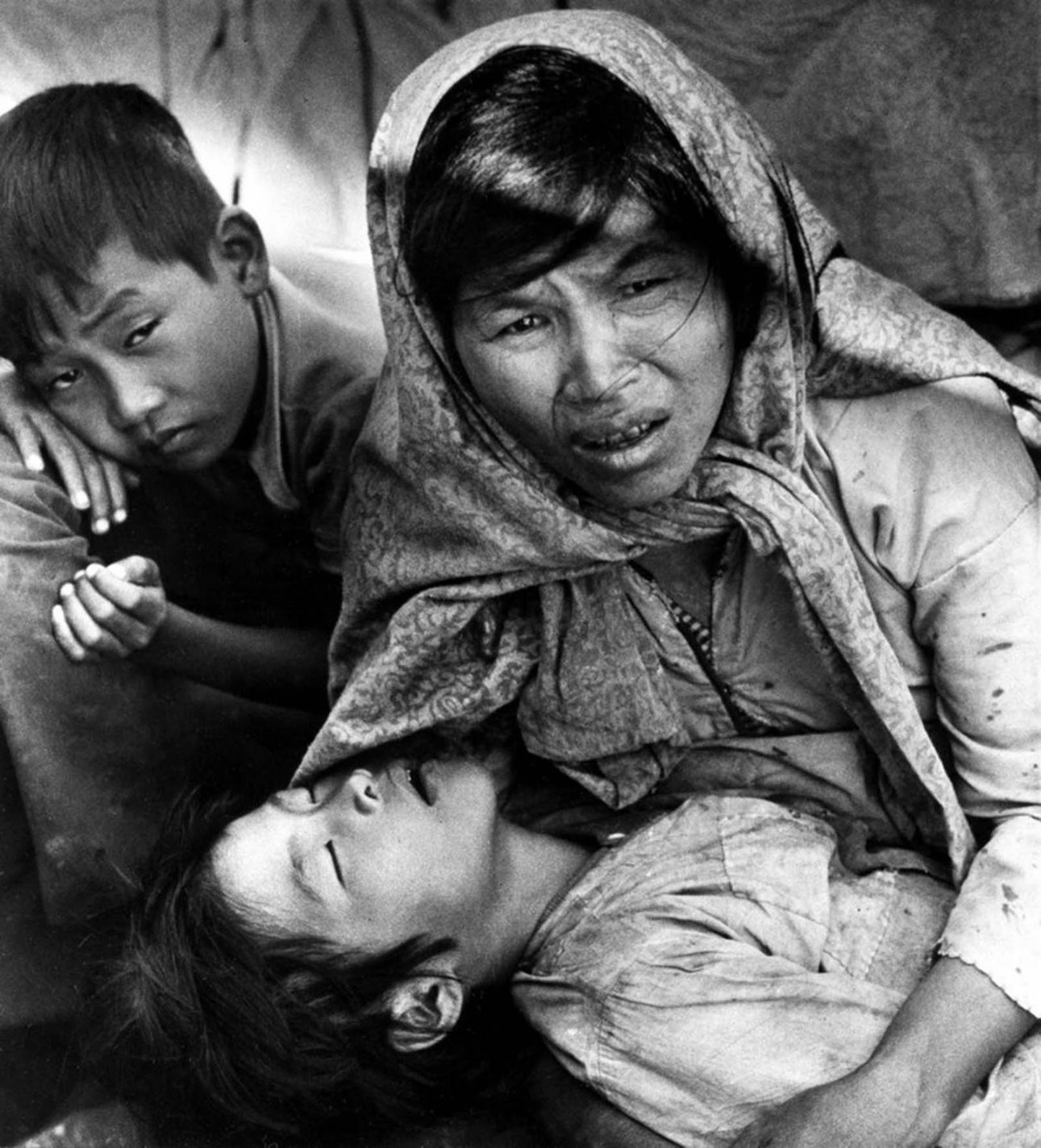
71. Boat of No Smiles, Eddie Adams, 1977.
War generates many social problems not only for participating countries but for other ones. One such issue is the numerous refugees. They require humanitarian help and are a burden for states where they migrate.
The Third Indochina War resulted in thousands of people who tried to escape from occupied territories of Vietnam by boats and tried to reach the neighboring countries of Southeast Asia or hoped that they would be picked up by foreign ships on international sea routes.
The mass exodus of “people in boats” in the 1970-1980s from Vietnam became an international humanitarian problem. According to the United Nations High Commissioner for Refugees, its scale is evidenced by 1986, 929,600 “people in boats” had completed their journey, and about 250,000 died at sea. This photo showed that the bloody history of the Vietnam war wasn’t over.
In 1977 Eddie Adams took the photos of one such boat – a small craft packed with 50 people near Thailand. His report was widely spread and helped refugees to get help.
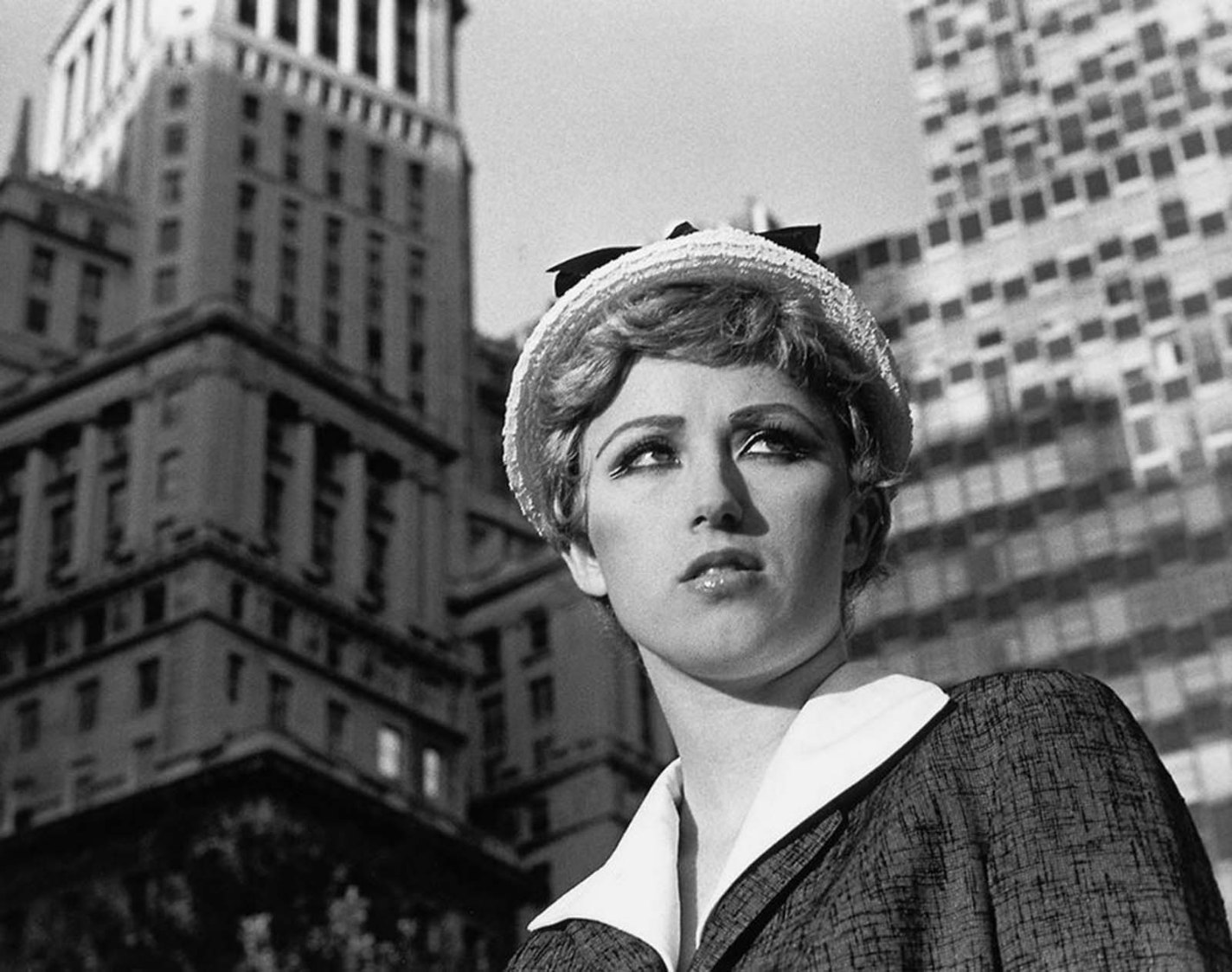
72. Untitled Film Still #21, Cindy Sherman, 1978.
A full story about this photo series
Cindy Sherman is one of the most influential figures in establishing photography as an art form. Her series of staged photos, Untitled Film Stills, was made inspired by movies. Photos looked like frames from films, Cindy Sherman was shooting herself, transforming into different images, and every picture made the viewers feel that they had seen these shots somewhere. Although all the characters were fictional, this effect arose because Sherman used stereotypes of mass culture. Other artists before Sherman also used popular culture, but her strategy was new.
The thought out set, background, image (makeup and costume) – all together referred to something very familiar. For example, #21 (“City Girl”) looks like a forgotten Golden Hollywood movie star, but it is still Cindy Sherman in the picture.
Interesting fact: Cindy Sherman never used any assistance while creating her images.
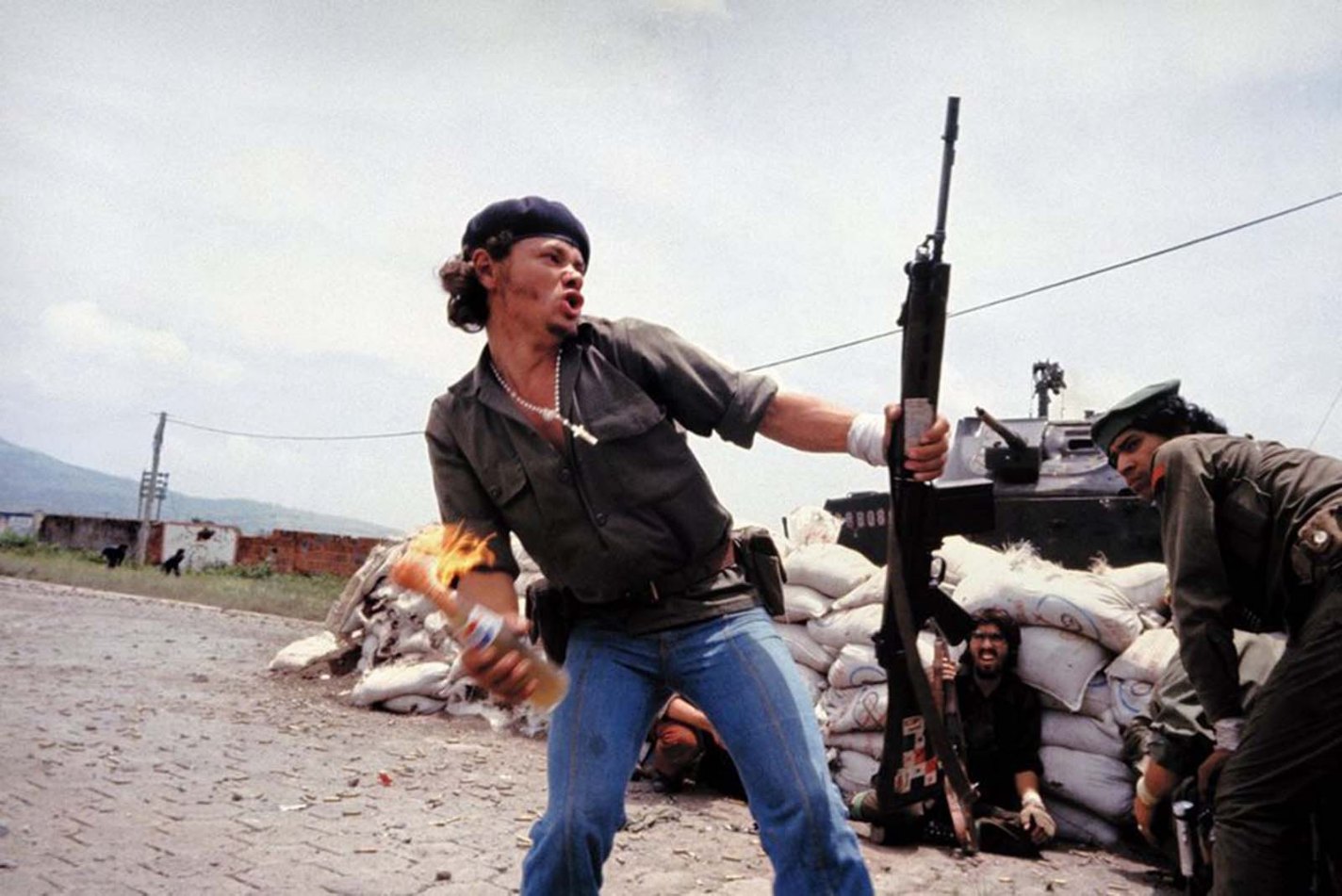
73. Molotov Man, Susan Meiselas, 1979.
A full story about this history photo
The photo, taken by American documentary photographer Susan Meiselas, became a symbol of victory of the Nicaraguan Revolution over the Somoza regime.
The popularity of the Molotov man can be compared with the iconic photo of Che – in Nicaragua, it is printed everywhere, from T-shirts to matchbooks.
The image of a man with a handmade armory of Pepsi bottle and a rifle, in dirty jeans, was widespread during the Sandinista revolution there were thousands of such men, and Pablo de Jesus “Bareta” Araúz throwing Molotov Cocktail was a prefab image of revolutionary.
Later, Joy Garnett drew her version of the picture, and Meiselas claimed that she doesn’t want “Pablo Arauz’s context being stripped away.”
Interesting fact: Susan Meiselas came back to Nicaragua in 10 years after the revolution kicked Somoza out. She didn’t like the results of the war.
74. Firing Squad in Iran, Jahangir Razmi, 1979.
A full story of this historic photo
The Pulitzer Prize-winning photography was anonymous till 2006 because of fear of retribution. Its author, Jahangir Razmi was present on the execution of Kurdish militants, who rebelled against the regime of Iranian ruler Ayatollah Ruhollah Khomeini. He made a shot at the moment when executors started the fire. The photo was published in Iranian daily Ettela’at and thus became a part of history. And reprinted by The New York Times and The Daily Telegraph, showing the bloody world rage of the Islamic Revolution.
The Islamic Revolutionary Council demanded the name of the photographer, but the publisher didn’t uncover it. Only in 2006, Razmi revealed his authorship.
Interesting fact: Jahangir Razmi followed the shooting squat to the next public execution on that bloody day. Fundamentalist continued to shoot Kurds for three more days.
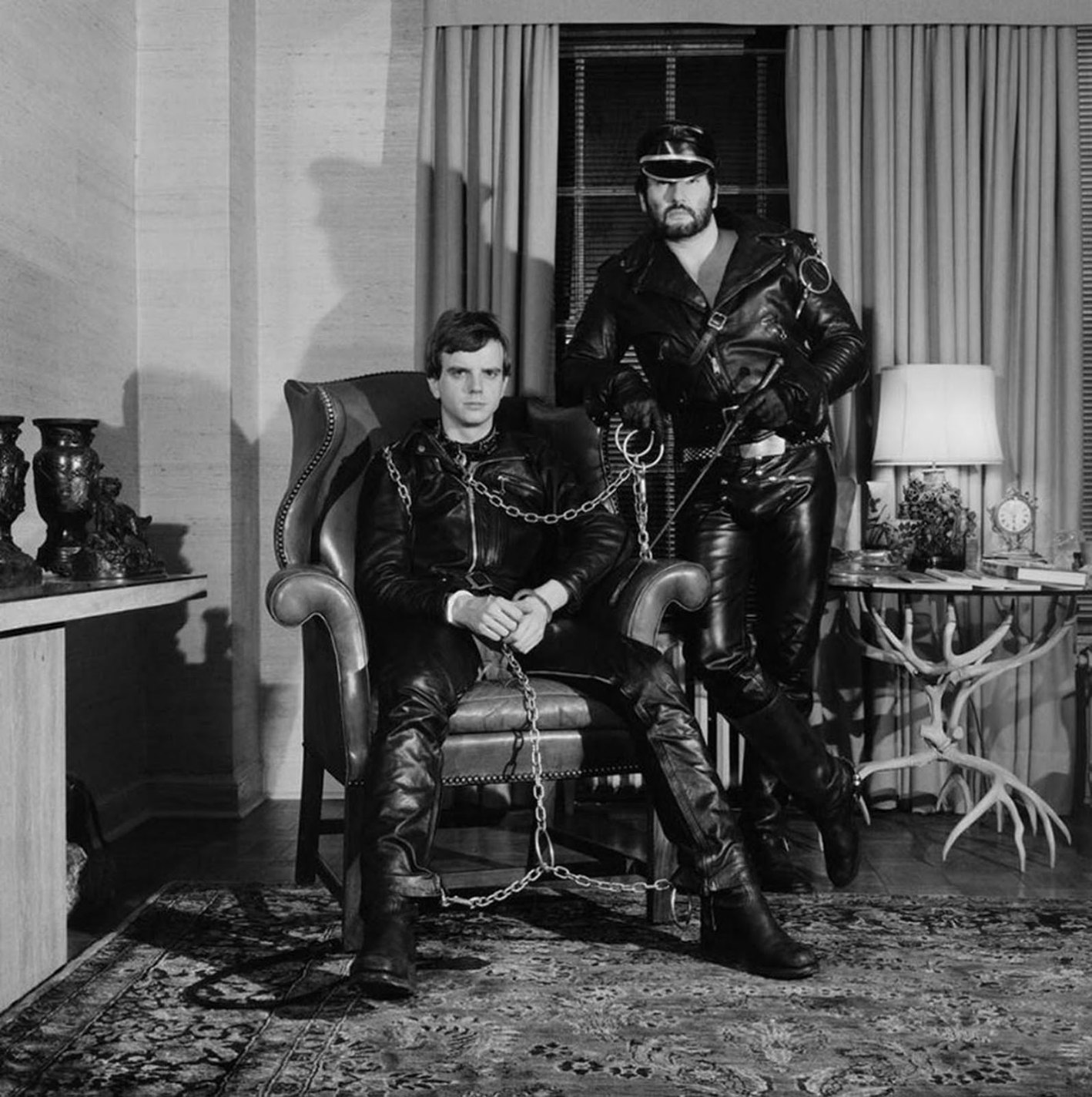
75. Brian Ridley and Lyle Heeter, Robert Mapplethorpe, 1979.
A full story of this historic photo
Robert Mapplethorpe is known for his provocative and controversial images. He depicted the hidden side of American society – homosexual minorities’ existence with its mood, trends, and lifestyle.
Even now, the S&M practice is considered as perverted taboo, and homosexuality is highly unaccepted. Then, in 1970-1980 it was exotic and brand new to an unprepared person. Portrait of Brian Ridley and Lyle Heeter in their leather outfits for roleplay in dominance was one of most iconic – their appearance was often copied in movies.
Erotic, as Mapplethorpe saw it, is still one of the most appreciated by collectors. His stylized staged photos are in the list of most expensive, and the price started rising after the news about his HIV/AIDS infection.
Interesting fact: Brian Ridley and Lyle Heeter asked Robert Mapplethorpe to wear a different, more mild outfit, saying that their ‘full-leather’ set is a bit’ too much for the public.’
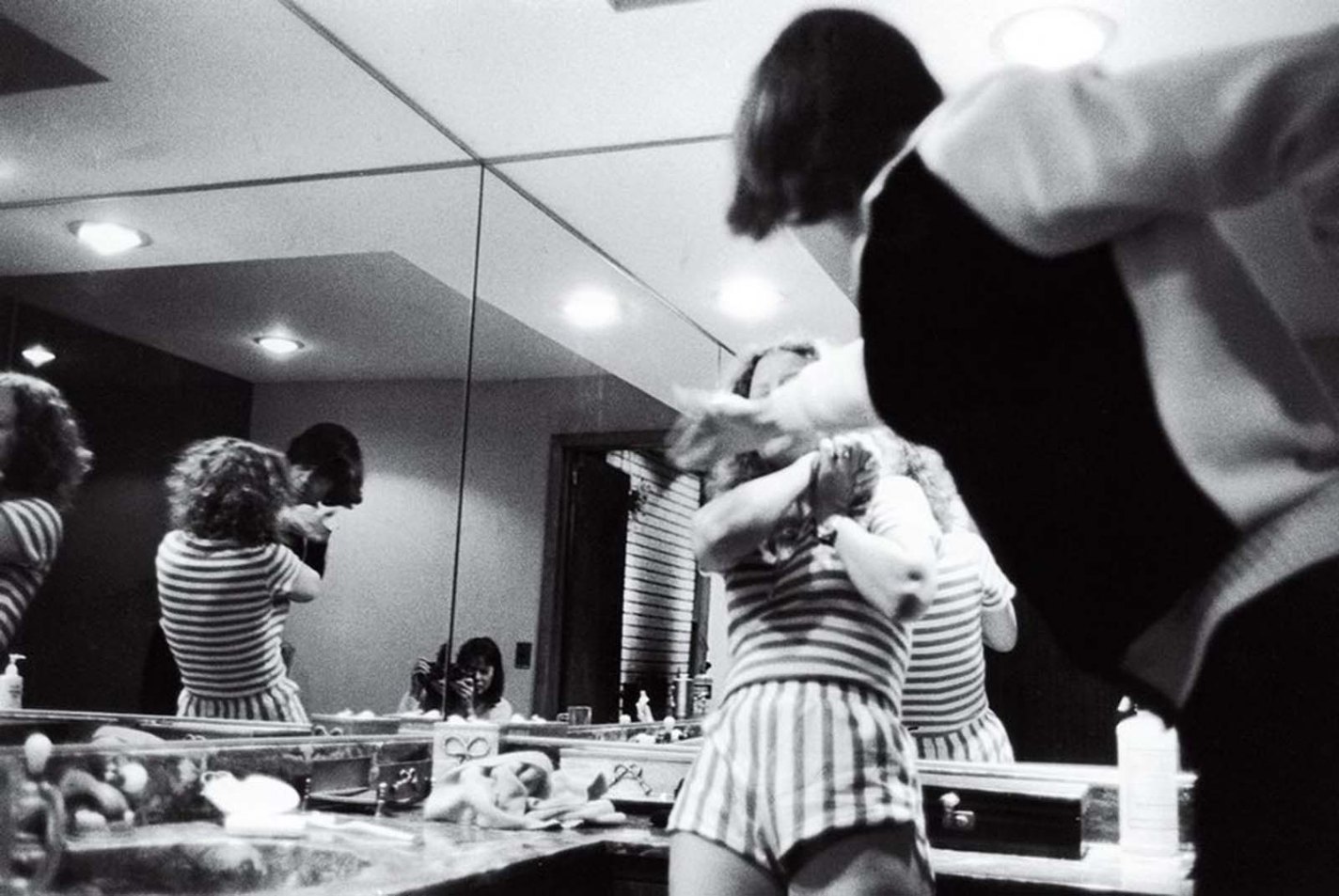
76. Behind Closed Doors, Donna Ferrato, 1982.
Domestic violence is collective, even in wealthy families. Donna Ferrato witnessed how it happened between Garth and Lisa (real names were uncovered later).
She visited swingers club and held a nighttime lifestyle to take photos for Japanese Playboy, instead, as she said later, “… one night, I witnessed a horrific scene: Garth attacked Lisa and beat her mercilessly as she cowered in the master bathroom. That night changed me forever and also altered the direction of my work for the next ten years…I was now driven to reveal the unspeakable things that were happening behind closed doors. I took the picture because, without it, I knew no one would ever believe it happened.”
Nobody wanted to publish such photos, so Ferrato started her project: for almost a decade, she documented domestic violence cases all over the country. As a result, she published Living With the Enemy (Aperture Foundation, 1991). This issue raised a worldwide discussion on sexual violence and women’s rights.
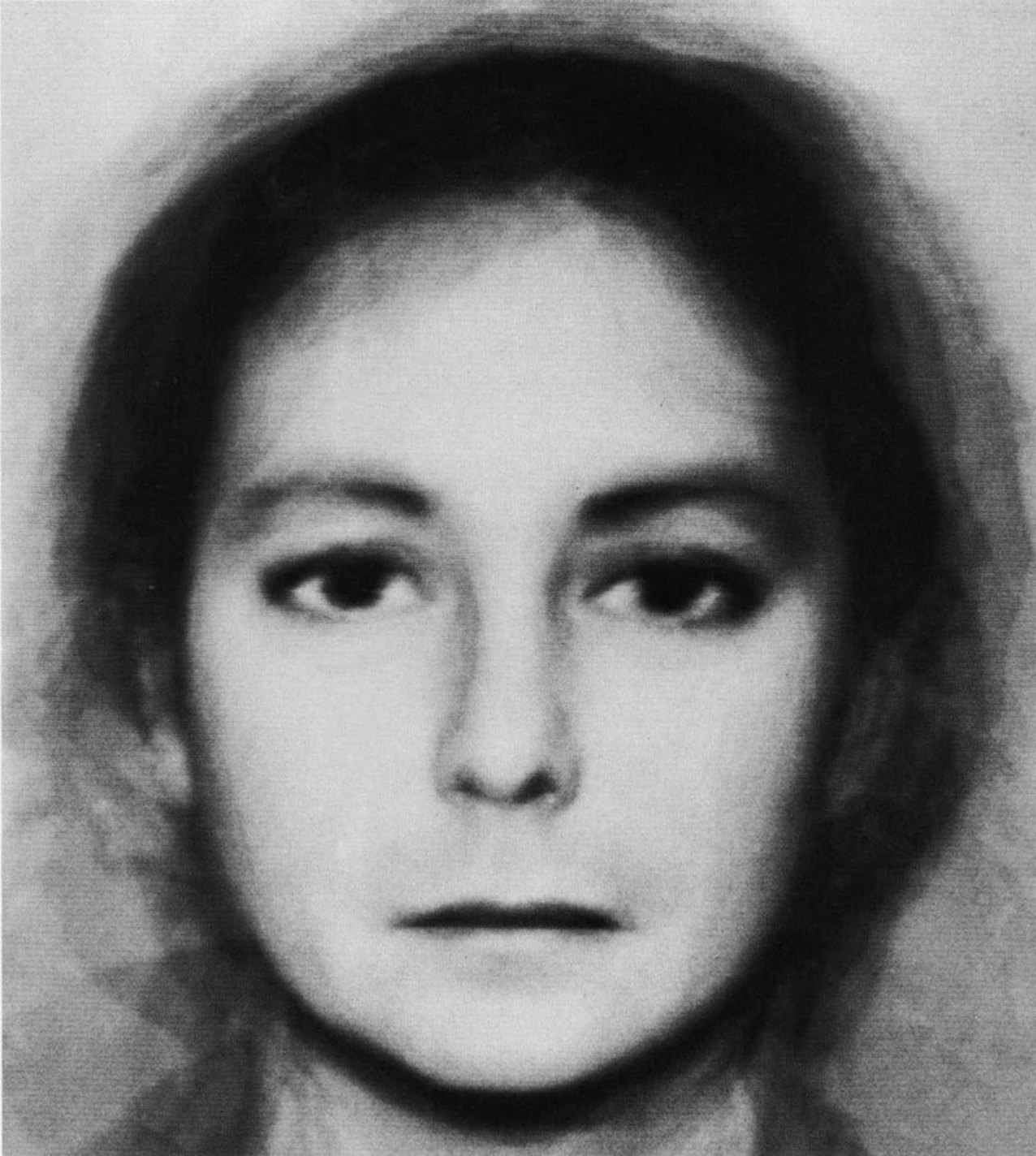
77. Androgyny (6 Men + 6 Women), Nancy Burson, 1983.
Nancy Burson created a unique project: in tandem with MIT scientists, she created unique interactive tools – Human Race Machine and Age Machine using morphing technology. Except for shifting the racial and aging characteristics, the algorithm used for these machines allowed to obtain an image of one face from morphing 6 Men + 6 Women features.
Her invention was so precise that it predicted almost entirely the future facial features after growing up or aging. It was purchased by the FBI and is still used for seeking people who lost years ago.
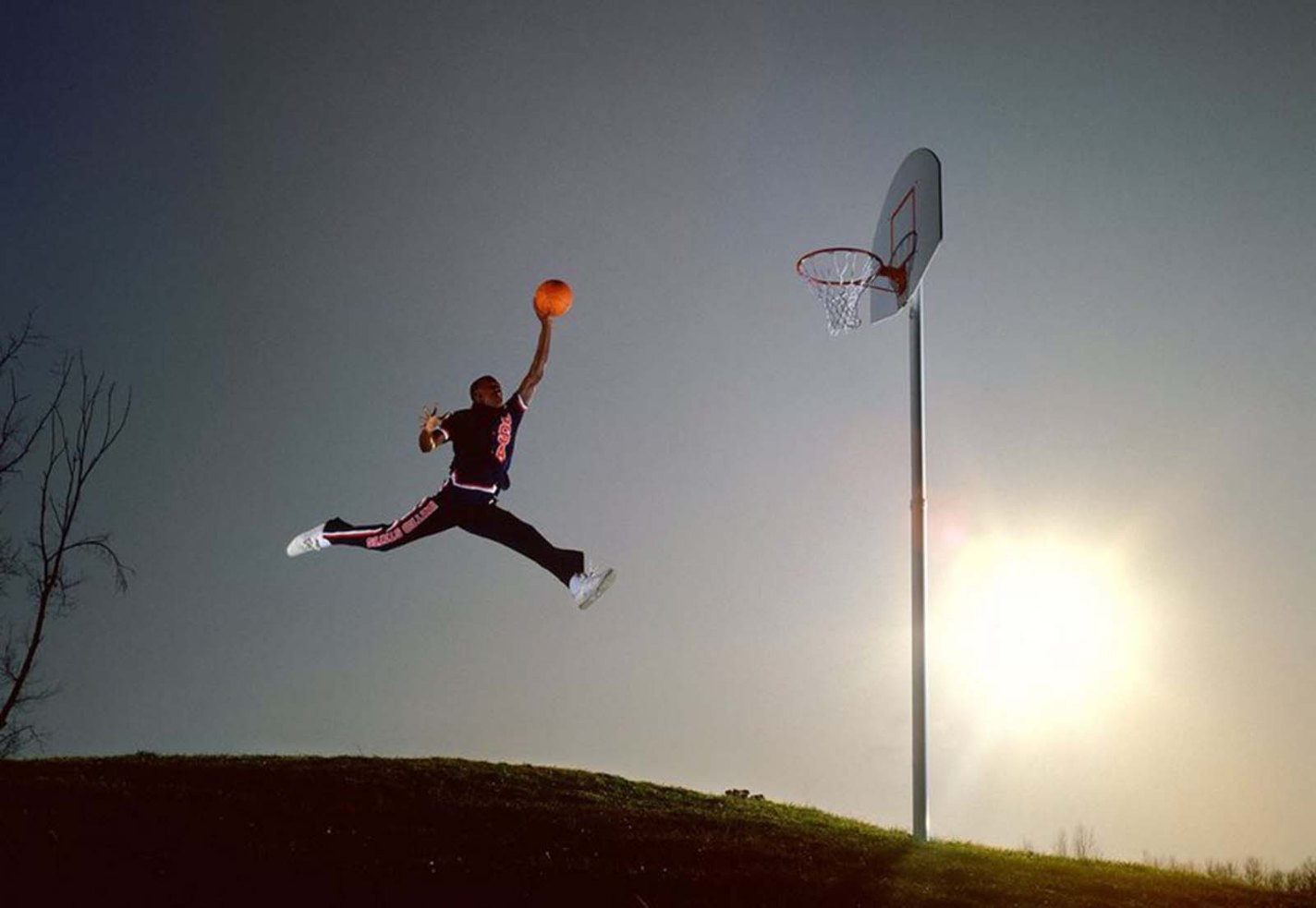
78. Michael Jordan, Co Rentmeester, 1984.
LIFE magazine’s special issue was devoted to the 1984 Summer Olympics, and Rentmeester took photoshoot with young sports stars, among which was Michael Jordan. The idea of image was how human strength could overcome gravity and fly up in the air to the goal.
The pose of a basketball player in the leap was staged by the photographer and became iconic. Ballet “grand jetés” in Jordan’s interpretation looks dynamic and easy to do, but the sport’s history cannot be imagined without this photo.
Later, Nike used this picture for another photoshoot to create one of the most recognizable logos. Rentmeester was very upset by the commercialization of his work and sued Nike for copyright infringement.
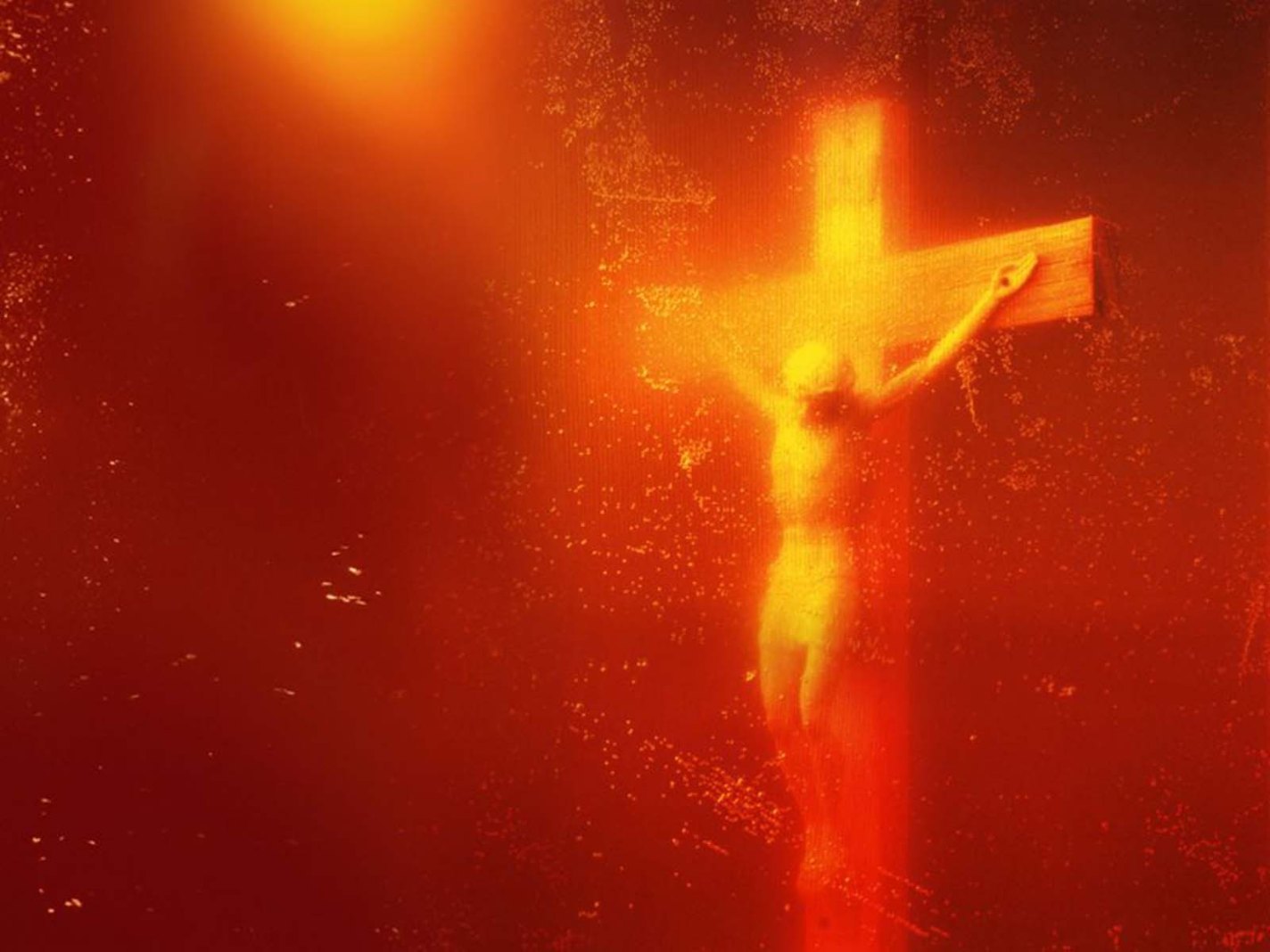
79. Immersions (Piss Christ), Andres Serrano, 1987.
Andres Serrano loves everything that the layman considers ugly: feces, urine, wrinkled skin, cadaveric spots. The taboo inspires him. And Serrano loves God very much and publicly admits his attraction to Jesus Christ. It was Jesus who brought Andres world fame, money, and respect in the art world.
When he created his Piss Christ, he thought about how disrespect is manufacturers of billions of cheap plastic crucifixes. By lowering the crucifix in urine with blood, the artist seems to return the image to sacredness, creating an icon.
The photo was exhibited several times, and only one pastor criticized the author for usage of the National Endowment for the Arts funds for heresy. This case resulted in several courts and inspired many other artists to cross the boundaries of public acceptance of art.
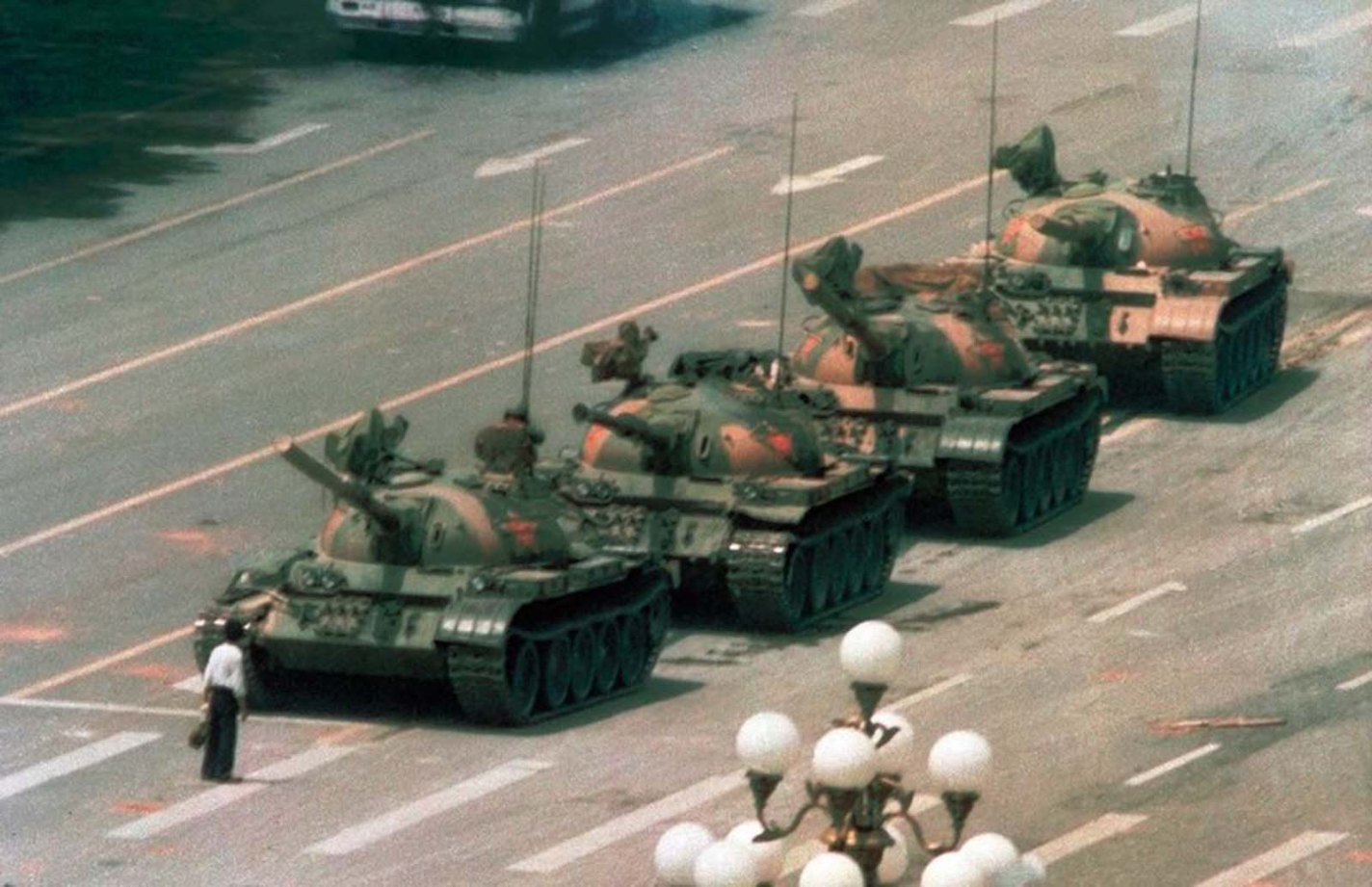
80. Tank Man, Jeff Widener, 1989.
A full story about this historical photo
The photograph depicting a simple Chinese man with a string bag, opposing tanks, flew around the world, becoming a symbol of what was called “a protest against the tyranny of a totalitarian state.” The photo was printed by hundreds of newspapers and magazines worldwide and was featured on television news. In April 1998, the American Time magazine included The Tank Man on the list of the 100 most influential people of the 20th century.
Jeff Widener took the photo from his hotel balcony a day after the Tiananmen Square massacre: he noticed the rebel came out in front of the column’s lead tank and for several minutes did not allow them to drive on. This photo didn’t change the course of history. The name of the brave man is unknown, and this incognito makes it even more thrilling.
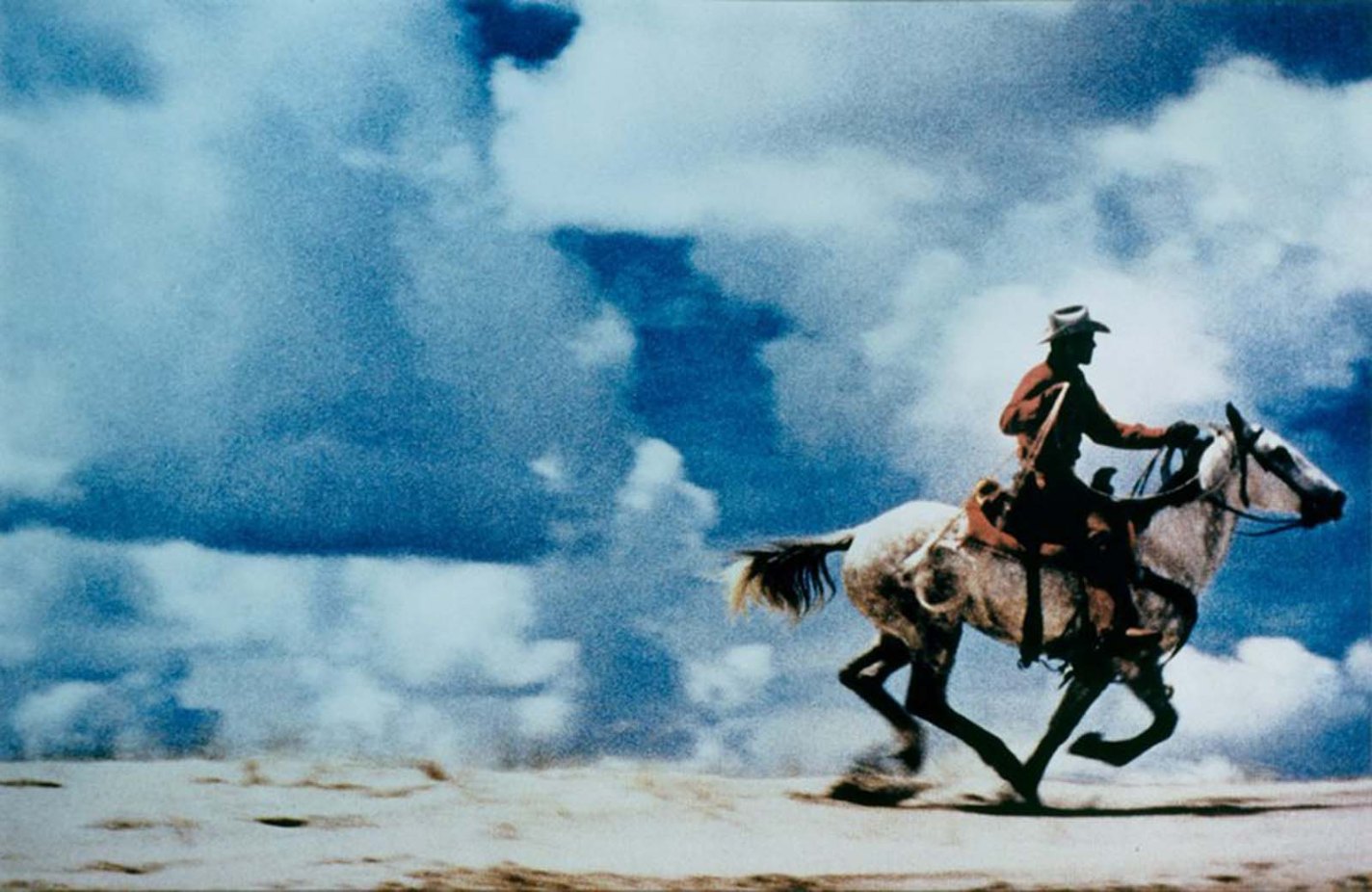
81. Untitled (Cowboy), Richard Prince, 1989.
Richard Prince is known for his rephotography technique: since the 1970s, he began to take pictures of print ads and present the result as his work – the gesture of appropriation, which was a breakthrough in his career. He freed from the accompanying text, leaving the advertising images unchanged, but this simple trick transformed the whole context.
The images that Prince represented were themselves idealized simulations of reality – the universe of consumer aspirations. He began to build pictures of the fashion world, famous brands, luxury goods in a series revealing highly codified visual cliches. Assigned images undermined the manipulative strategies of the advertising industry and, at the same time, were hypnotically attractive.
This picture also is in the list of the TOP 10 most expensive photos
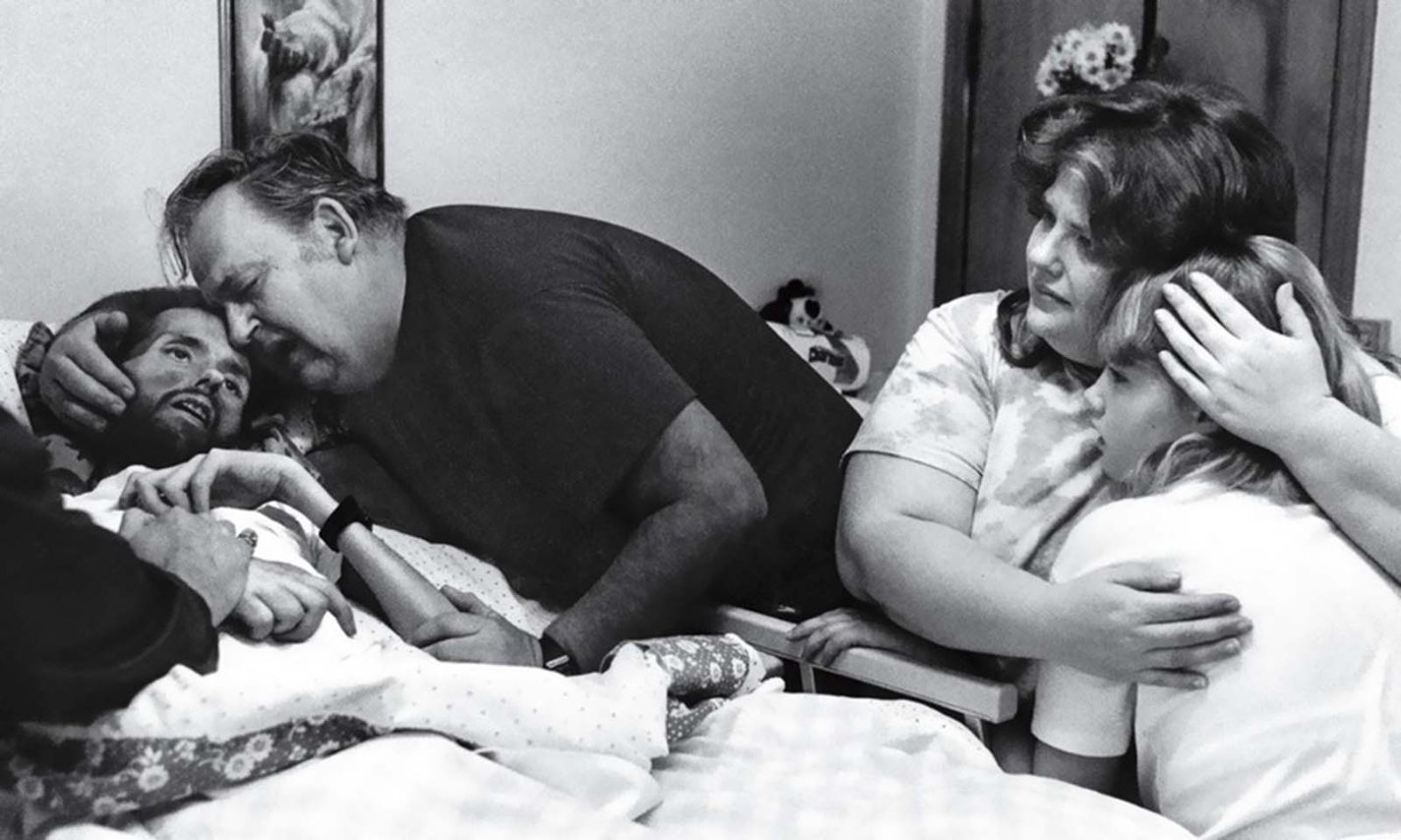
82. The Face of AIDS, Therese Frare, 1990.
The first HIV/AIDS awareness campaign started with a photo of dying American HIV/AIDS activist David Kirby. Therese Frare was very close to Kirby’s family, who invited her to share their sorrow over David’s last breath. Publication of the photo in LIFE changed public imagination about the disease and became a part of history. Kirby’s family allowed Benetton to use this image in an advertising campaign as a method to reach a worldwide audience.
The HIV/AIDS was considered a “gay disease,” his historical photos series was criticized by the Catholic church as an allusion to the Virgin Mary cradling Jesus Christ pietà.
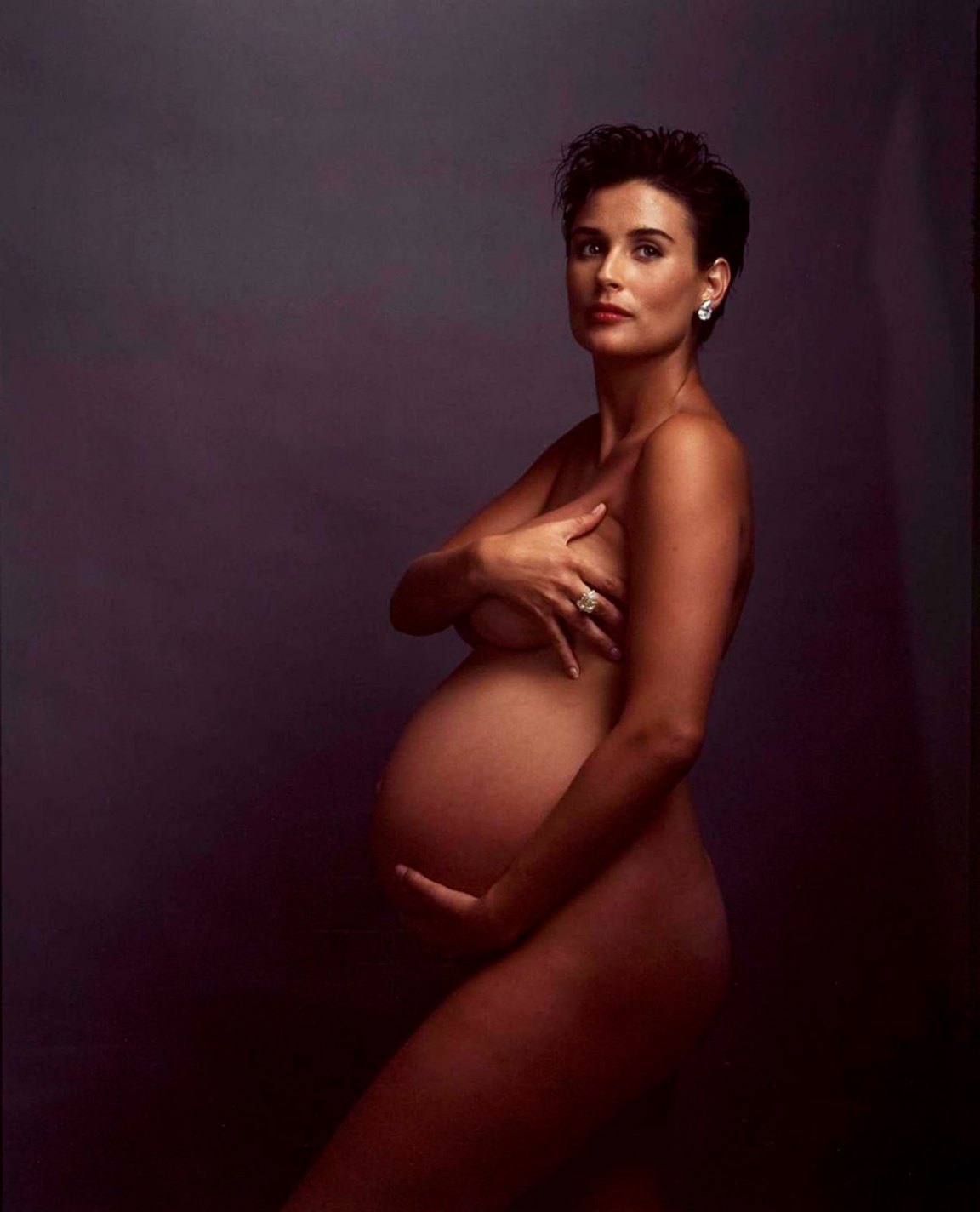
83. Demi Moore, Annie Leibovitz, 1991.
Naked photo of pregnant Demi Moore on the cover of Vanity Fair became a bomb. This cover sets a trend of intimate pictures of pregnant celebrities, as well as ordinary moms. Annie Leibovitz created an aura of royalty over Moore’s pregnancy, and the golden light made the photo look-alike medieval painting. Single photos have changed the whole perception: pregnancy lost its intimacy and became sexualized.
‘I look beautiful pregnant,’ and not ashamed of it.” – said Tina Brow about historical photos series.
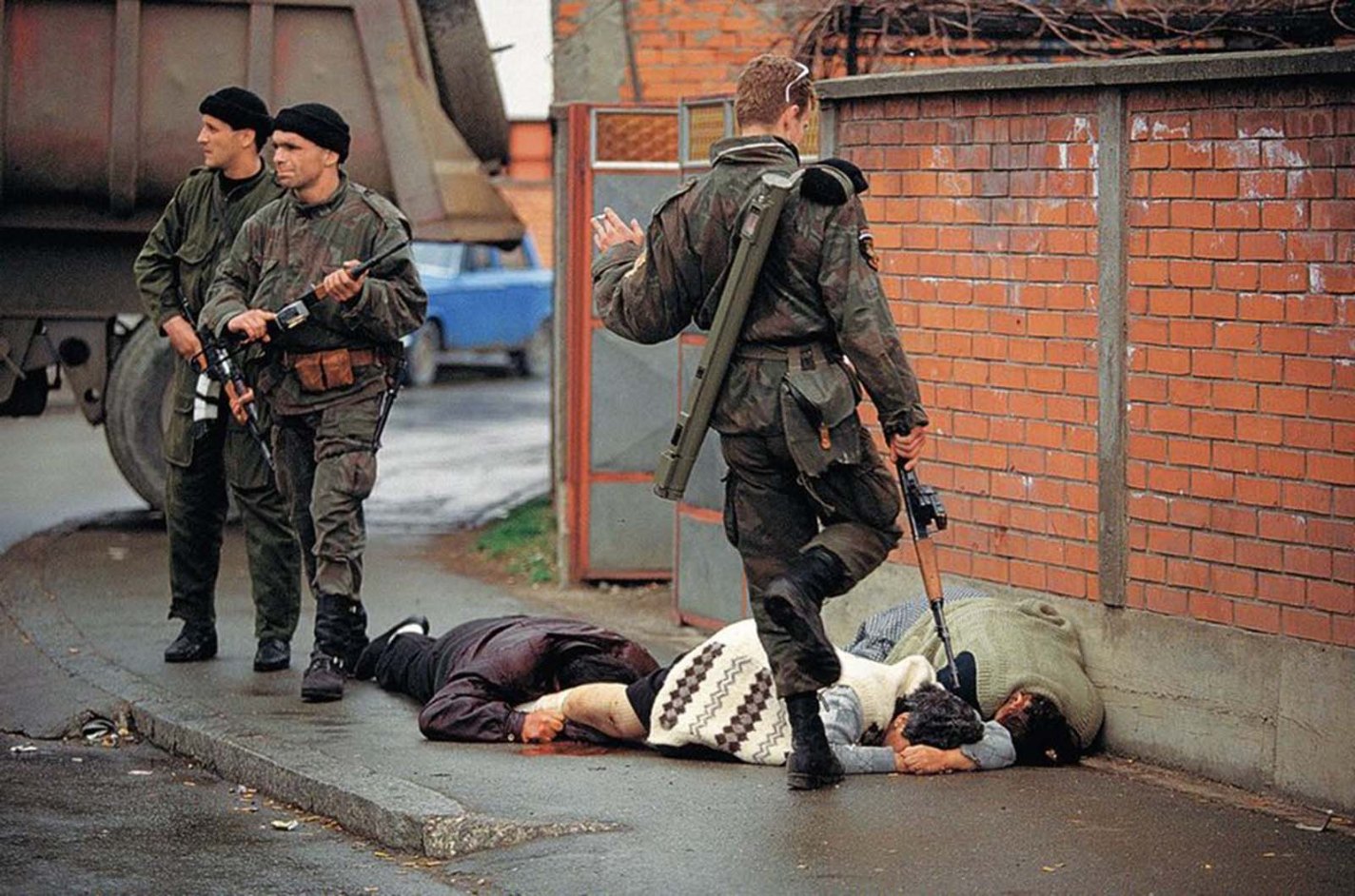
84. Bosnia, Ron Haviv, 1992.
A photo of a Serb Volunteer Guard checking is shooted Muslim woman already dead put Ron Haviv in the hit list of Zeljko Raznatovic. The picture was made at the beginning of the 3-year Bosnian war, which took over 100,000 lives. The photo raised the question of the international response to the conflict.
The official start of the war is considered April 6, 1992, when the Bosnian capital Sarajevo was attacked. However, the battle began on April 1, 1992, when the paramilitary Serbian Volunteer Guard under the command of Zeljko Rajnatovic (nicknamed “Arkan”) crossed the Serb-Bosnian border and, after attacking the city of Bijeljina, committed the first massacre of Bosnians.
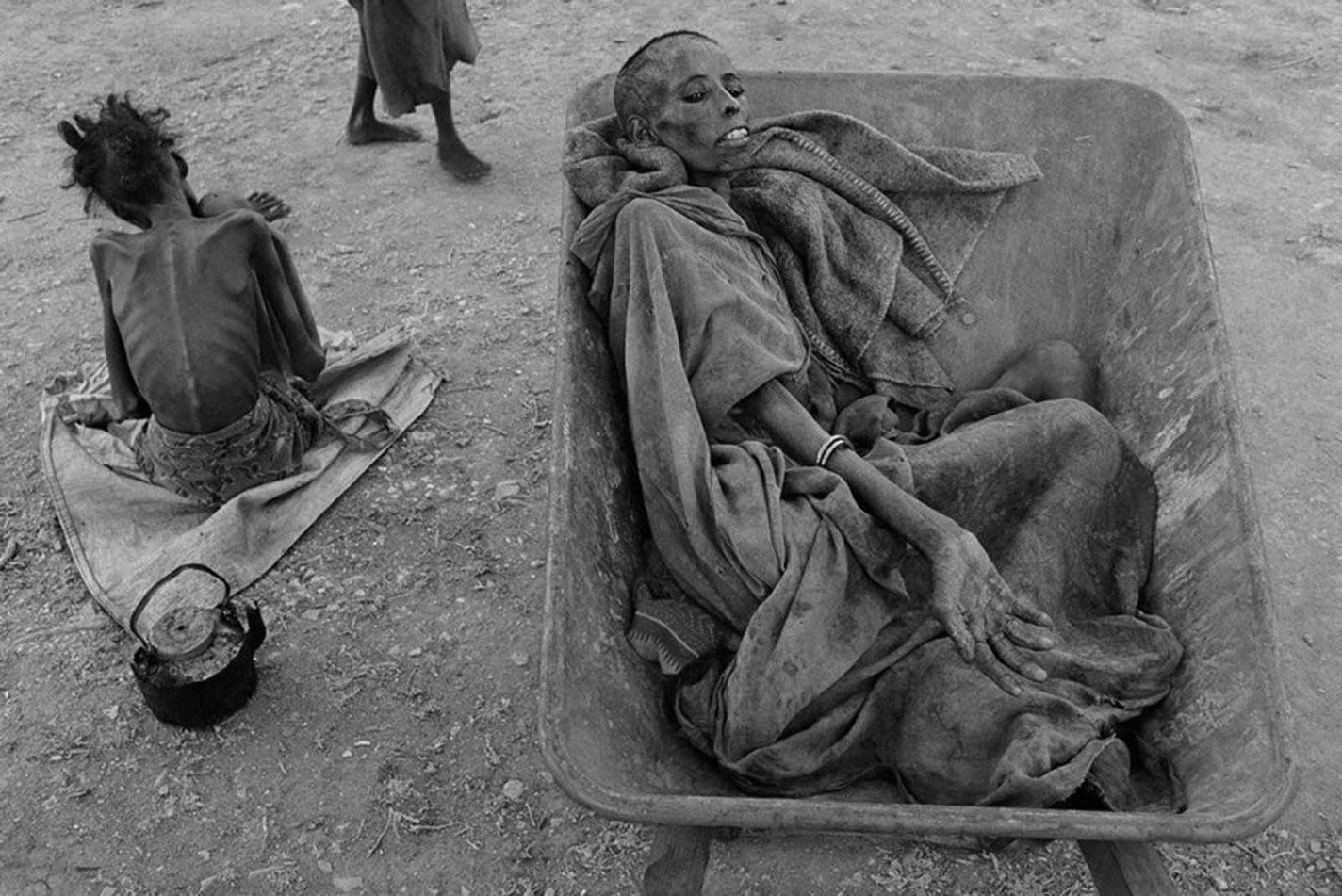
85. Famine in Somalia, James Nachtwey, 1992.
Most of Mogadishu, and therefore the country, was controlled by the bandits.
War in 1991 destroyed Somalia’s infrastructure. The state has virtually ceased to exist. The drought resulted in famine and violent epidemics. By the fall of 1992, more than half of Somalia’s population, nearly 5 million people, were suffering from hunger and diseases, more than 300 thousand people died. Most of the dead were children. About 2 million refugees were forced to flee their homes, fleeing hunger, disease, and civil war.
Despite the massive supply of food and medicine organized by the world community, the Somali refugees’ situation did not change U.N.proved. UN humanitarian assistance often did not reach the target, being gathered in the hands of armed groups.
James Nachtwey captured a scene of a woman waiting to be taken to a feeding center. The historical photos forced public support for the Red Cross and saved one and a half million people. Maybe the best thing in history that one photo can do.
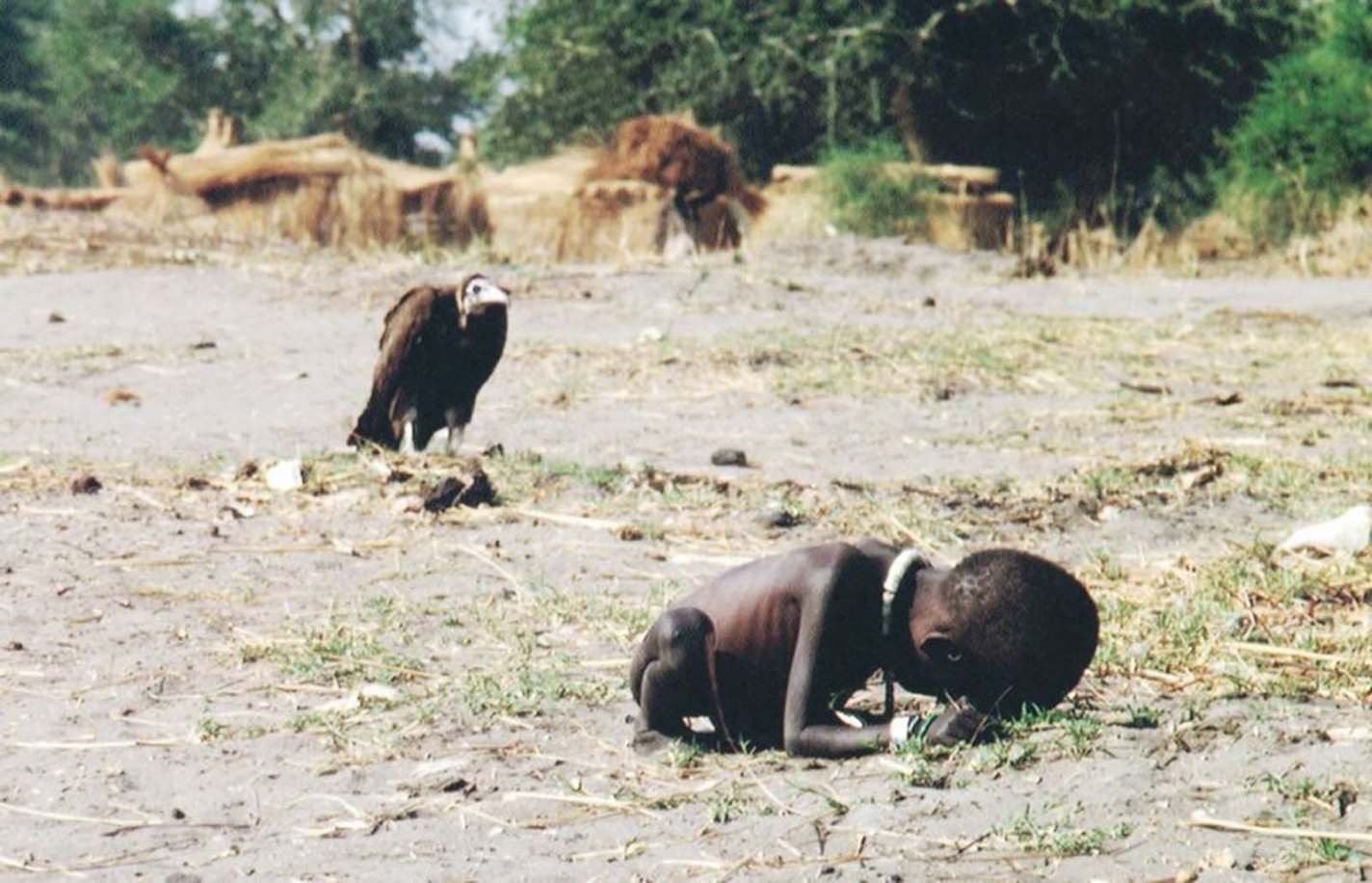
86. Starving Child and Vulture, Kevin Carter, 1993.
On March 25, 1993, the photo was made by South African photographer Kevin Carter in Sudan, during a mass famine and became a classic photojournalism example. It made the author famous, but the fame was bitter: ) the newspaper wrote: “A person who adjusts his lens just to take a good picture of a suffering child is like a predator, just another vulture.”
Behind the story, other photographers told the fact that there were many similar images, and by positioning the camera, the distance of 10 meters can be seen as 1. The child survived and died in 14 years after this history photo (from malarial fever).
Carter won a Pulitzer for his historical photos, but the burden of the death he saw pushed him into depression and suicide.

87. Pillars of Creation, NASA, 1995.
“Pillars of Creation” – clusters of interstellar gas and dust in the Eagle Nebula, about 7000 light-years from Earth. The objects in the photograph received the name “Pillars of Creation” because gas and dust in them are involved in forming new stars with the simultaneous destruction of clouds under the light of already established stars.
The original photograph of the Pillars of Creation is composed of 32 separate images taken by four cameras. The photo shows the light emitted by various chemical elements in the cloud, depicted in different colors in the composite photo: green indicates hydrogen, red indicates singly ionized sulfur, and blue indicates doubly ionized oxygen atoms.
Black rectangles resembling a staircase in shape in the upper right corner of the image arose because the camera in the top right quadrant took photographs in higher magnification. When they were reduced to the same scale as historical photos from other cameras, space was inevitably formed in this part of the photograph.
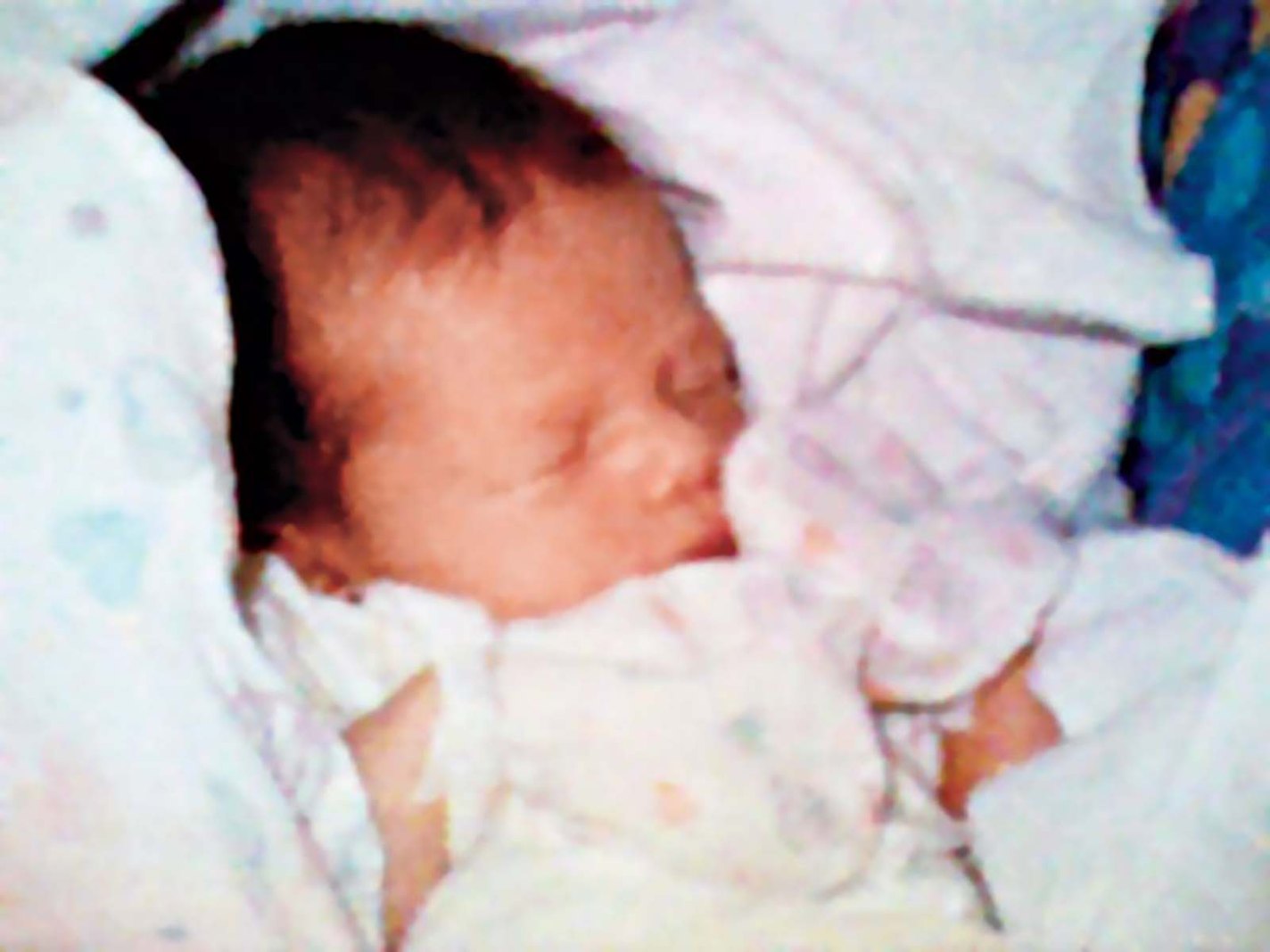
88. First Cell-Phone Picture, Philippe Kahn, 1997.
Today, even the most low-cost smartphone is equipped with a pair of cameras and able to take quite good pictures or make a video. But not so long ago, people were forced to carry bulky cameras to capture important life moments. Everything changed in 1997. At the hospital in Santa Clara, California, Philip Kahn took the first mobile picture and shared it with loved ones. It was a photograph of his newborn daughter Sophie.
Kahn wanted to share the good news with everyone close as soon as possible. Therefore, a few months before his daughter’s birth, he began to prepare for this event, and his wife supported this idea.
To capture the newborn daughter, Philip combined a mobile phone, laptop, and digital camera. On the camera, he took a photo of his daughter in a resolution of 320×240 pixels and sent it using a cell phone to a home server encoding an automatic notification system for thousands of email accounts. Letters immediately began to come to him with questions about how he managed to do this. The first phone photo should stay as an icon in the digital history book.

89. 99 Cent, Andreas Gursky, 1999.
Andreas Gursky is the highest-paid photographer globally, creating large-scale photographs for which the most significant museums of modern art are fighting.
He is one of the first artists who began to process images on a computer to achieve better detail, change the color scheme, add new elements, and eliminate unnecessary ones. Gursky prints his works of enormous size, and they consist of a large number of individual frames, neatly assembled in a graphical editor. This gives tremendous detail, even at such a large size.
In the “99 cents” photograph, Gursky added a reflection of goods to the ceiling, creating a repeatability effect.
The photo’s history is somewhat ironic: this shot of an American store with goods of 99 cents Gursky conceived as a metaphor for the problems of modern consumer society. Recently, someone bought it for 2.2 million dollars – a metaphor for the global art market.
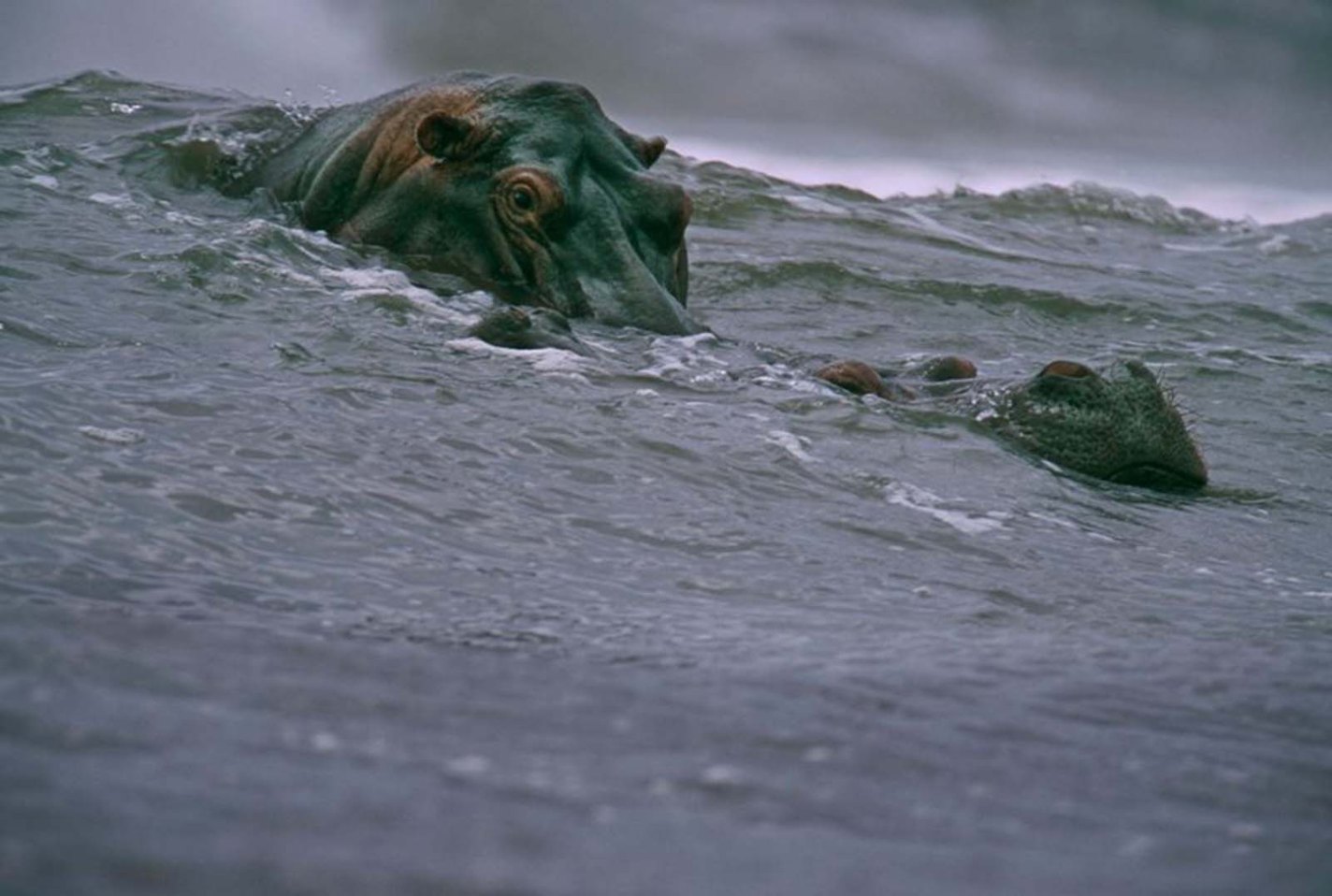
90. Surfing Hippos, Michael Nichols, 2000.
Hippos usually do not enter the sea, living near rivers and lakes. Sometimes they just enjoy the waves in the surf. In 2000 National Geographic published a photo with hippos swimming in the ocean. Healthy animals swam in the Atlantic Ocean under heavy clouds.
Michael Nichols traveled 2,000 miles from the Congo to the Gabon ocean coast. During hіs trip, he captured many natural wonders of Africa; but the most amazing image was waiting until the end of the journey.
These historical photos were used as part of an ecology campaign to attract the world’s attention to the necessity of wildlife preservation, especially in developing countries.
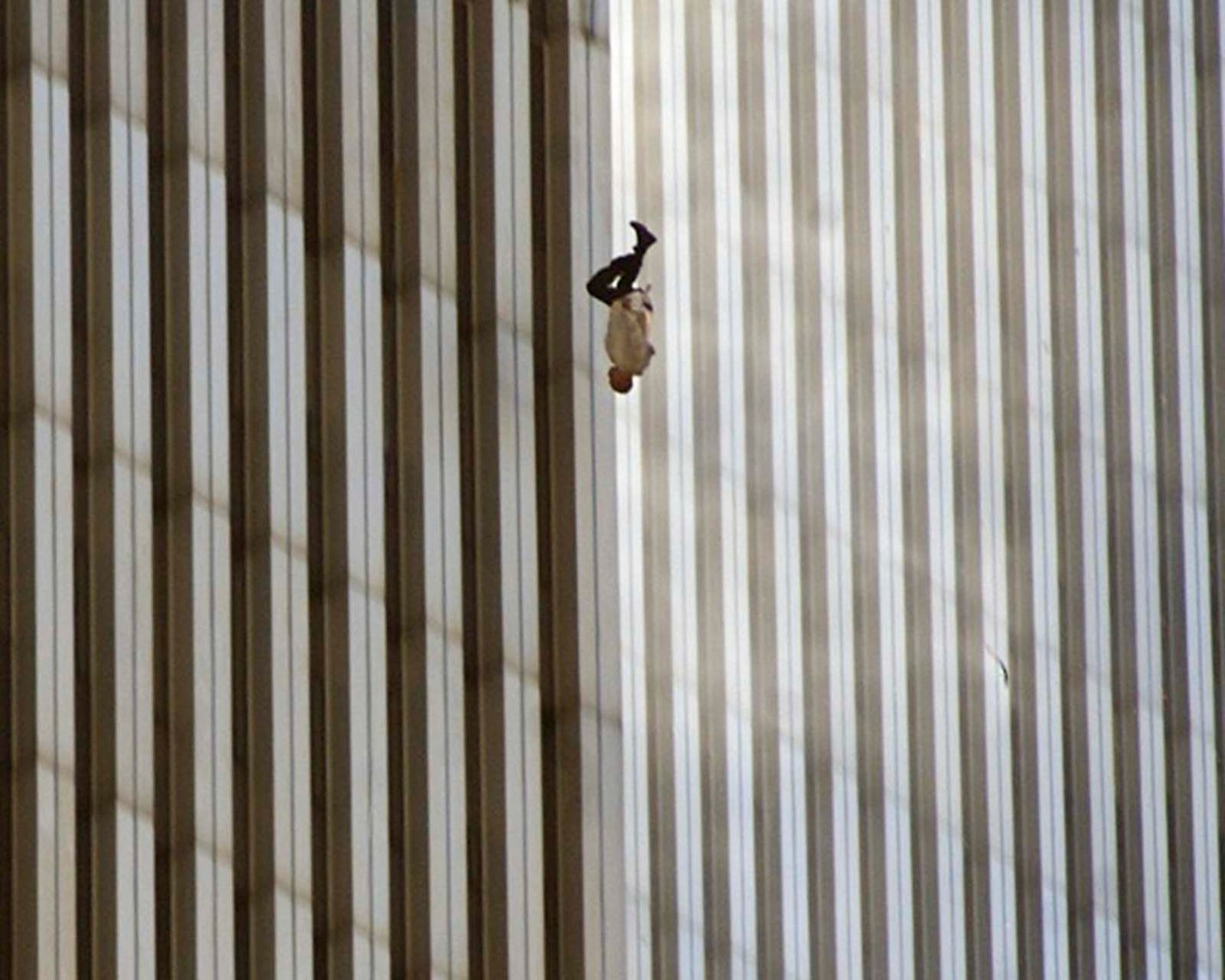
91. Falling Man, Richard Drew, 2001.
September 11, at least 200 people were thrown or were forced to jump out of the burning towers of the World Trade Center. One of them became a symbol of the tragedy alongside the image of burning towers. That day people jumped to escape from smoke and fire so as not to fall under the collapsing ceilings and the floor, for the last time to breathe freely before death. On average, the fall lasted about 10 seconds. Some tried in vain to use the curtains as parachutes – none of them survived.
Journalists have made many attempts to find out the person from the historical photos of Richard Drew but still have not succeeded. The photo “The Falling Man” is called the sharpest image of the 21st century’s human despair.
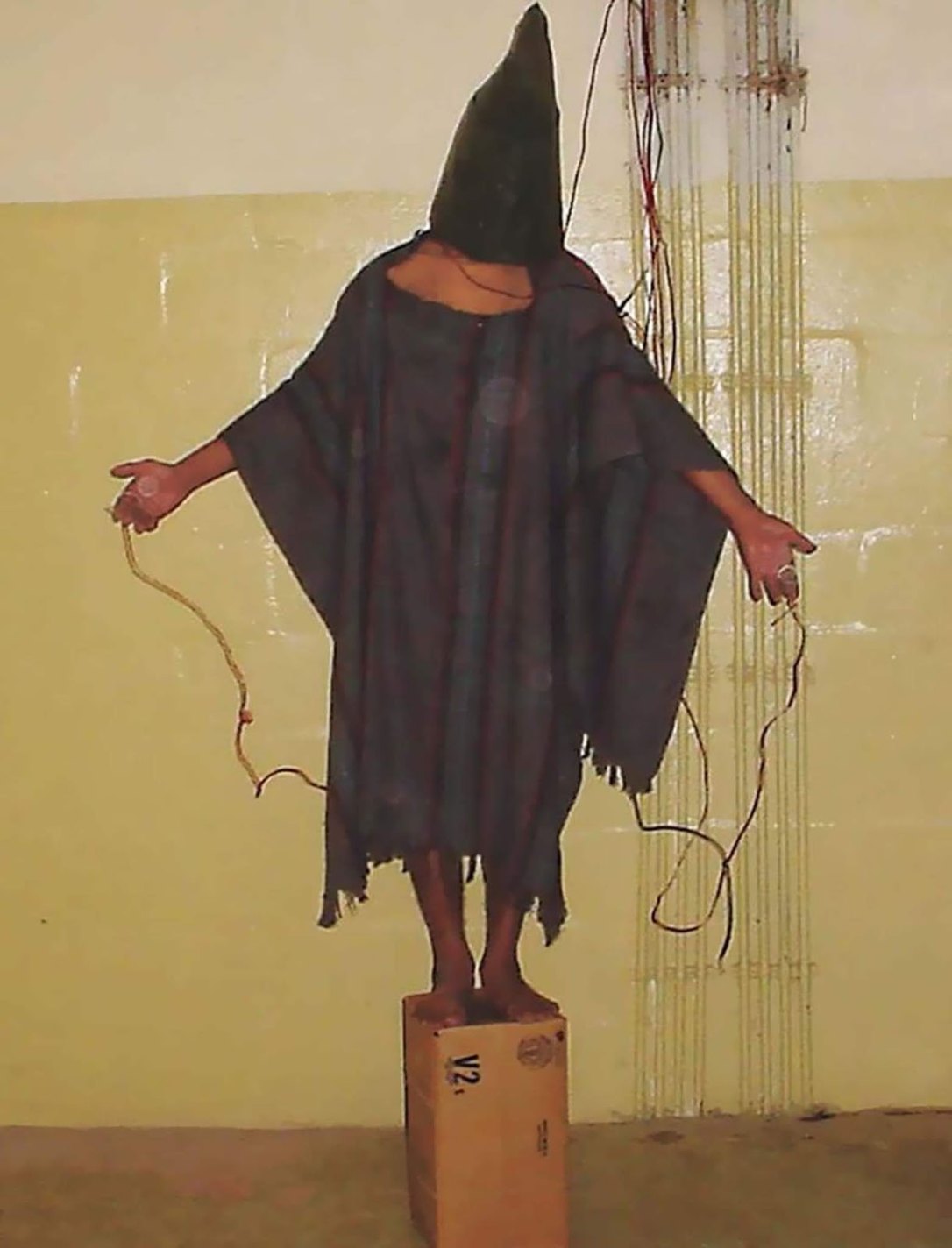
92. The Hooded Man, Sergeant Ivan Frederick, 2003.
War is the environment where the one who has some power feels permissiveness. Ivan Frederick was one of several soldiers who participated in torturing Iraqi prisoners at Abu Ghraib prison. He and ten other soldiers tortured, raped, beat, physically abused prisoners. Representatives of the Interim Governing Council of Iraq called torture “a hateful practice aimed at humiliating the dignity of Iraqis.”
During the U.S.rtures, US troops took historical photos, posing against the backdrop of their victims. The photo and video materials became evidence in the court.
One, where a man stands on the box with wires, was “staged” by Sabrina Harman and was appropriate for newspapers. The victim was told that if he moves, he’ll get an electric shock.
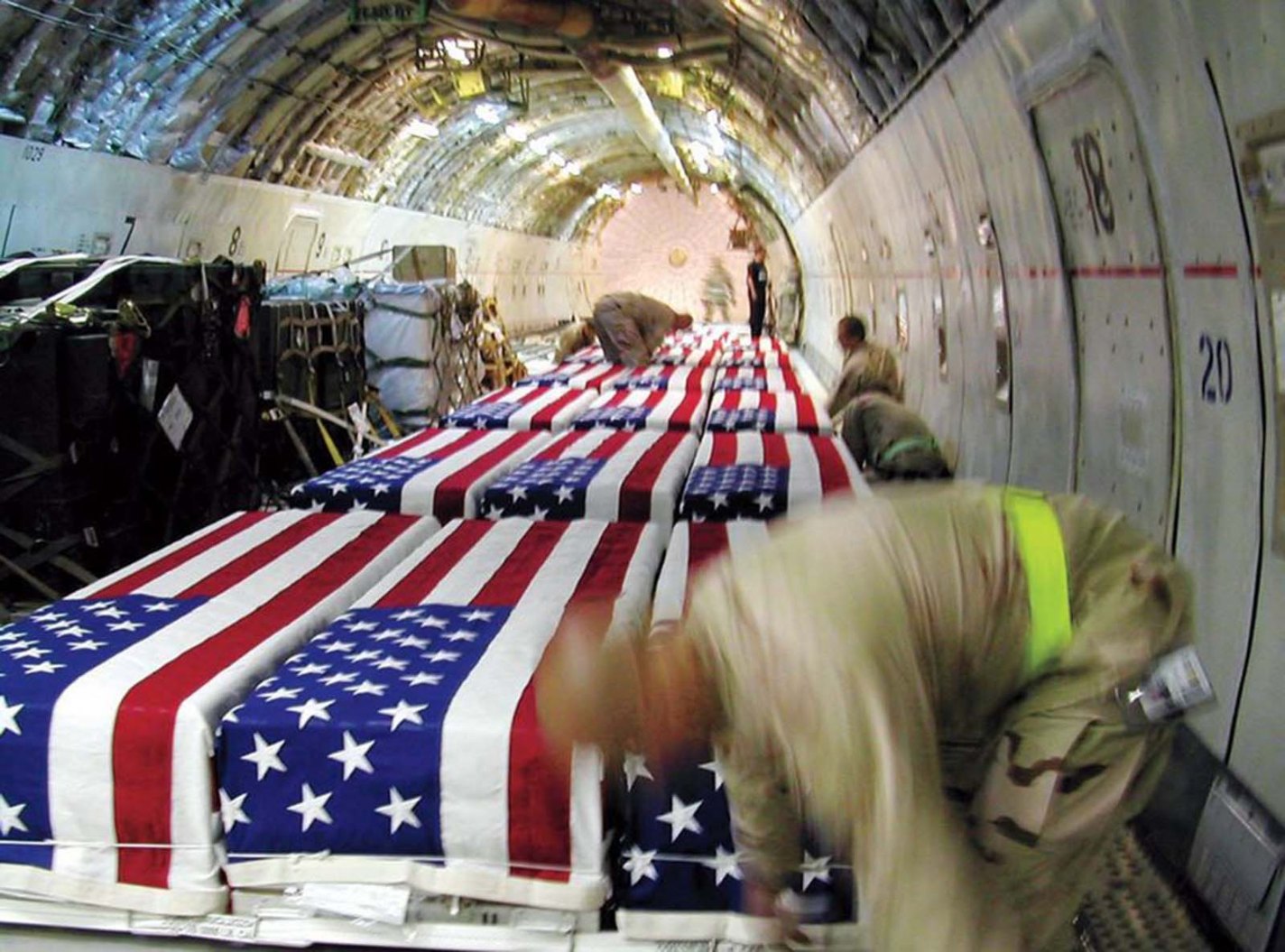
93. Coffin Ban, Tami Silicio, U.S.04.
The US government didn’t want to show the scale of people lost during the Iraq war. No photos or videos of issues associated with death were shown to the public until Tami Silicio dared to cross the permission and took the picture more than 20 flag-draped coffins on their way from Kuwait to Dover Air Force Base in Delaware. She sent a pictuU.S. to the US, where it was put on the Times issue cover. The need for censoring such documentary photos was controversial, Silicio lost her job, but society saw the real price of the war. Here’s why these historical photos are such important.
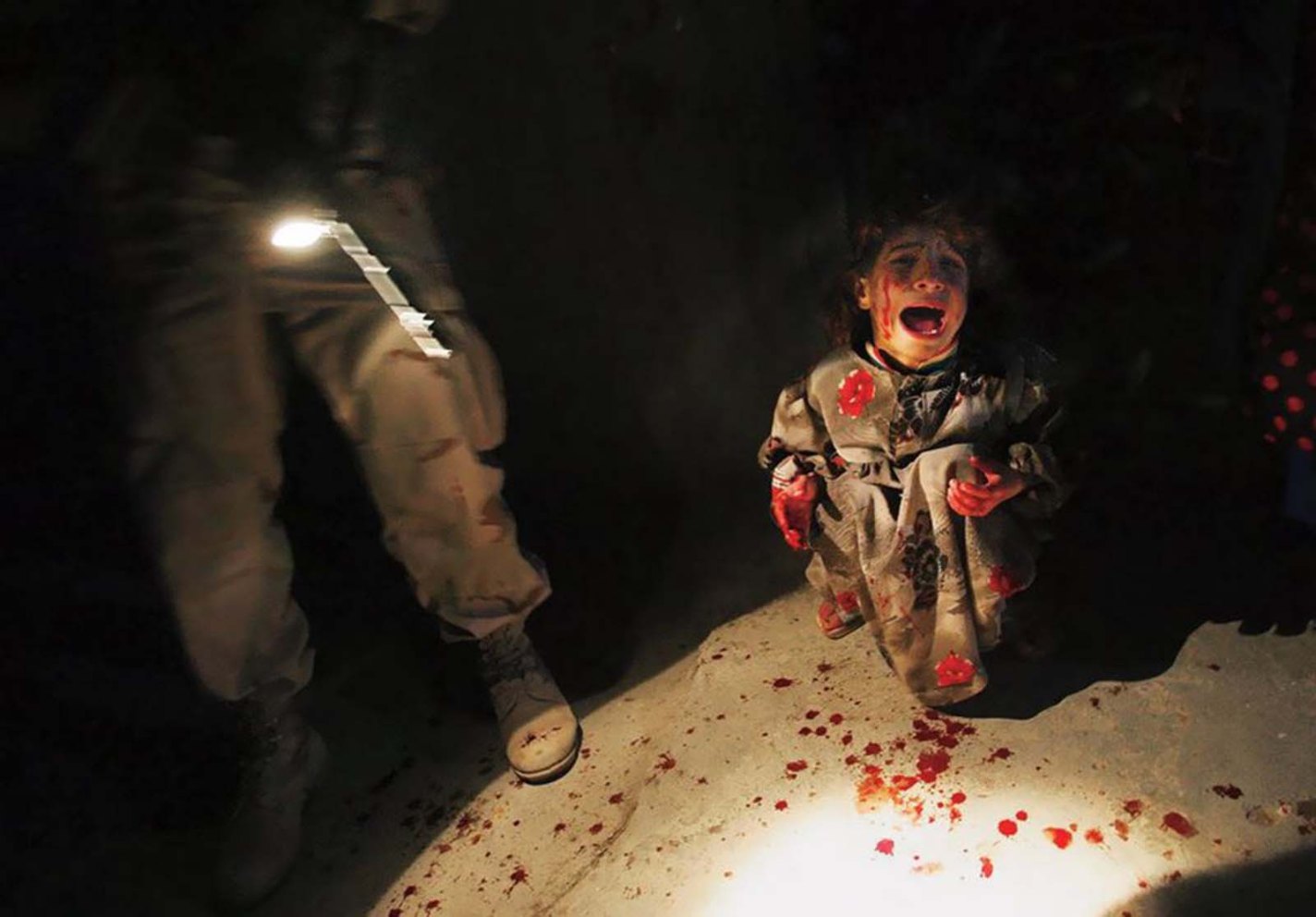
94. Iraqi Girl at Checkpoint, Chris Hondros, 2005.
Chris Chondros took photos of a crying orphaned girl during American intervention in Iraq. Soldiers patrolled the streets of the city at sunset. The car approaching the patrol did not stop, despite the warning fire and soldiers shooting to kill. There was a family in the car. Father and mother in the front seats were dead immediately. Six children in the back seat survived, one boy was injured. One of them, the little girl, has become a symbol of the insanity of the Iraq war. Society was already skeptical about the necessity of the American presence in Iraq, and this history photo spread worldwide. A tragic story in historical photos.
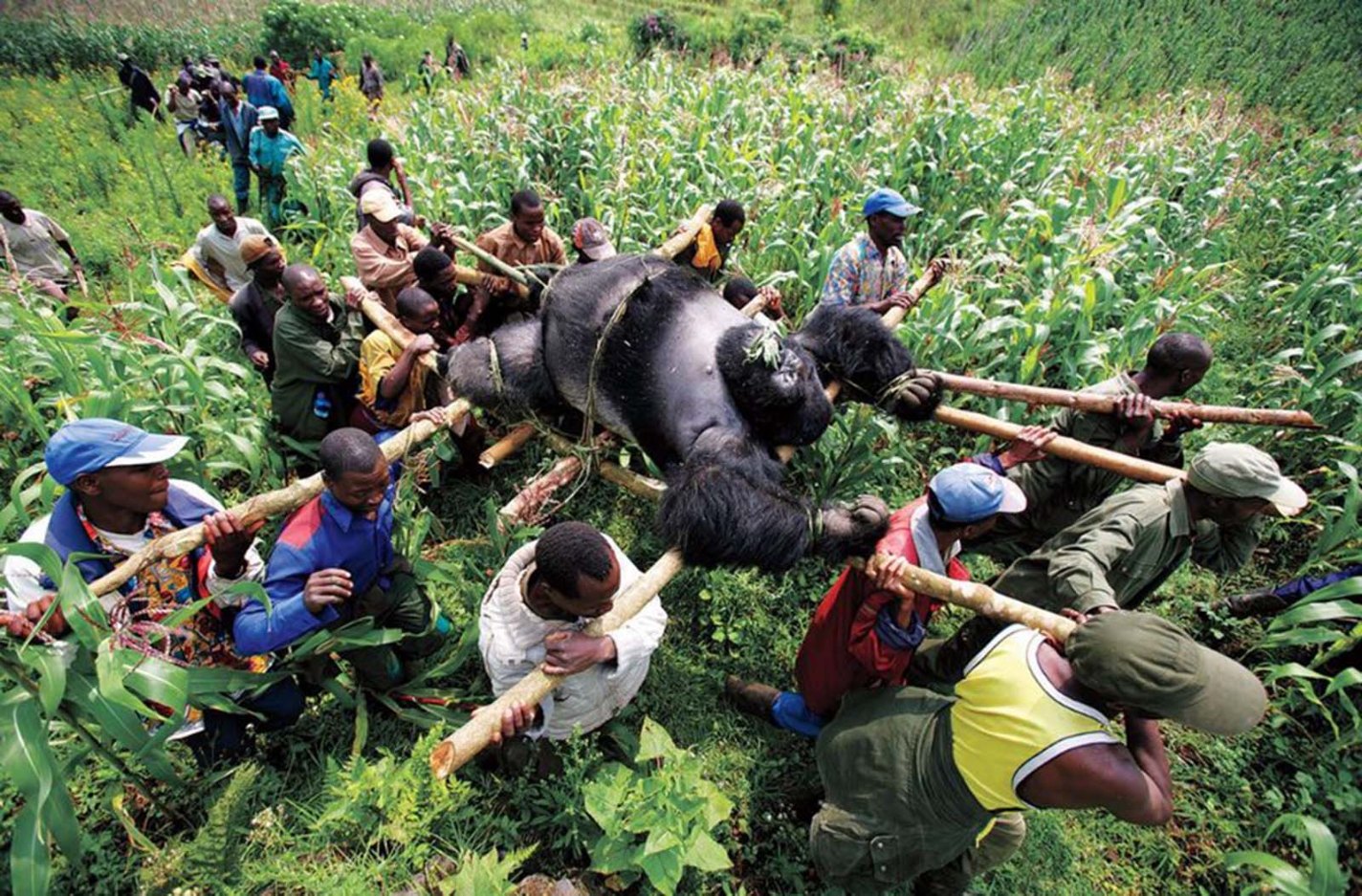
95. Gorilla in the Congo, Brent Stirton, 2007.
African wildlife is unique and requires preservation. The necessity of protecting local ecotopes, such as Virunga National Park in the Democratic Republic of Congo, was exposed to the public by Brent Stirton photos.
One, where residents and park rangers carry a rare eastern gorilla named Senkwekwe, was the top topic on National Geographics.
The massacre of 7 gorillas killed by people involved in the illegal charcoal trade horrified villagers and the whole world. The photo where the big gorilla is carried as an ancient king to a special burial place for gorillas is considered the best Stirton work. We hope that these historical photos will help gorillas survive.

96. The Death of Neda, Unknown, 2009.
Within a couple of days, published in Internet accidental murder turned into a symbol of protest against the regime of Mahmoud Ahmadinejad.
Neda Agha-Soltan stacked in a traffic jam caused by demonstrators gathered in Tehran on Karegar Avenue and neighboring streets. It was hot, and Neda decided to get out of the car to watch the demonstrators. According to her music teacher, who accompanied her, there was a sound similar to crackling after a while. It was a shot from a sniper rifle. The bullet hit the girl in the chest; she fell on the roadway and, bleeding, died in a few minutes.
The murder had huge international resonance, but the Iranian government tried to hide the circumstances, claiming that NU.S.a was a US agent. Massive processions in the memory of Neda proved that the informational war was lost.
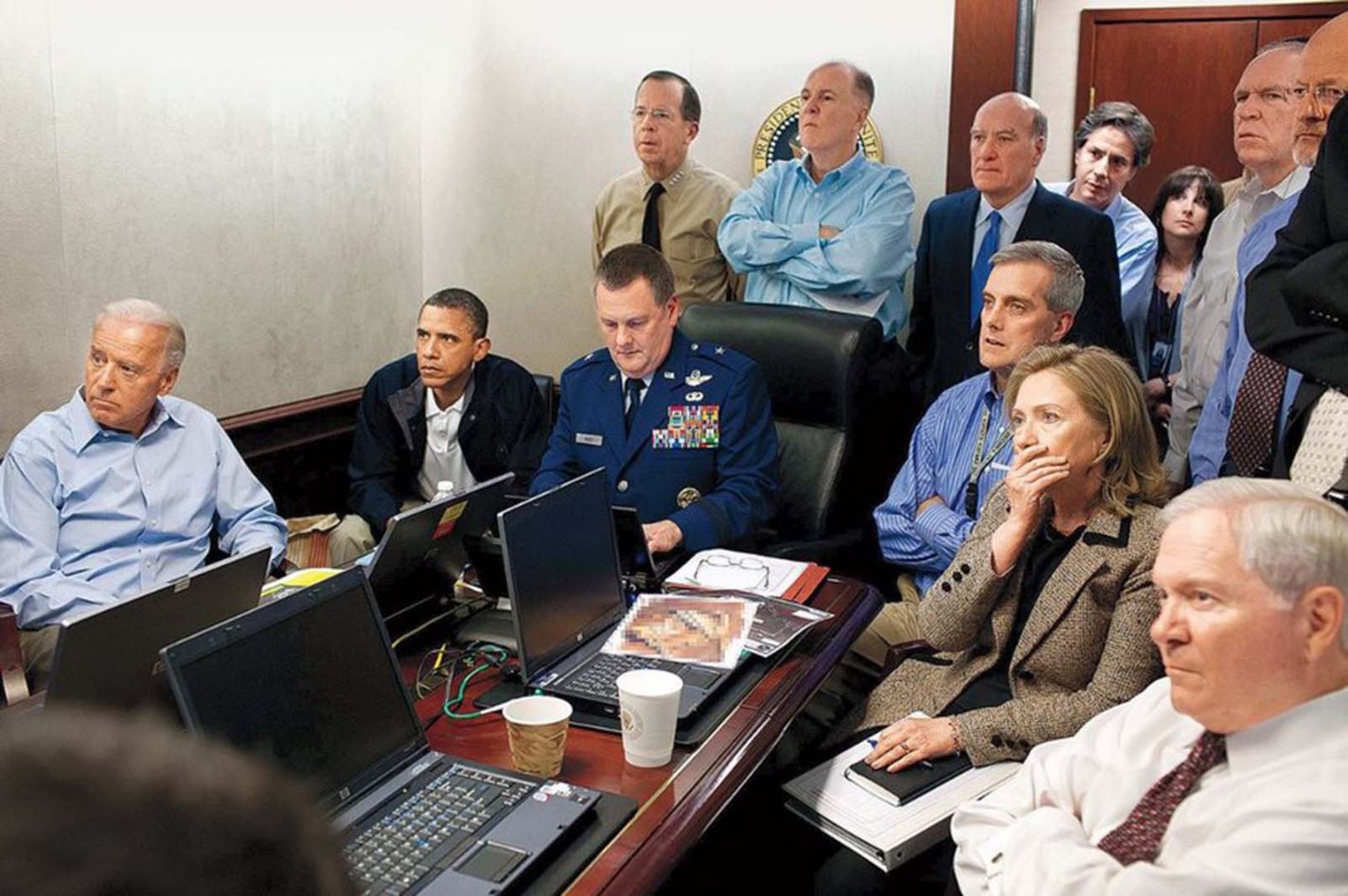
97. The Situation Room, Pete Souza, 2011.
Osama bin Laden represented the danger of terrorism for all society and the day when Barack Obama launched Operation Neptune Spear. The operation was carried out by SEAL Team Six group. President and his administration watched the action filmed in real-time by a drone camera.
Pete Souza’s photo was the only visual information about Osama’s death – there were nobody photos, no other materials. The White House Situation Room comprises several different conference rooms, and to monitor this mission, the President with the national security team moved into a small one. Souza made nearly 100 historical photos, but all were from the same corner, due to lack of space. But this photo seems to capture the historical moment at its best.
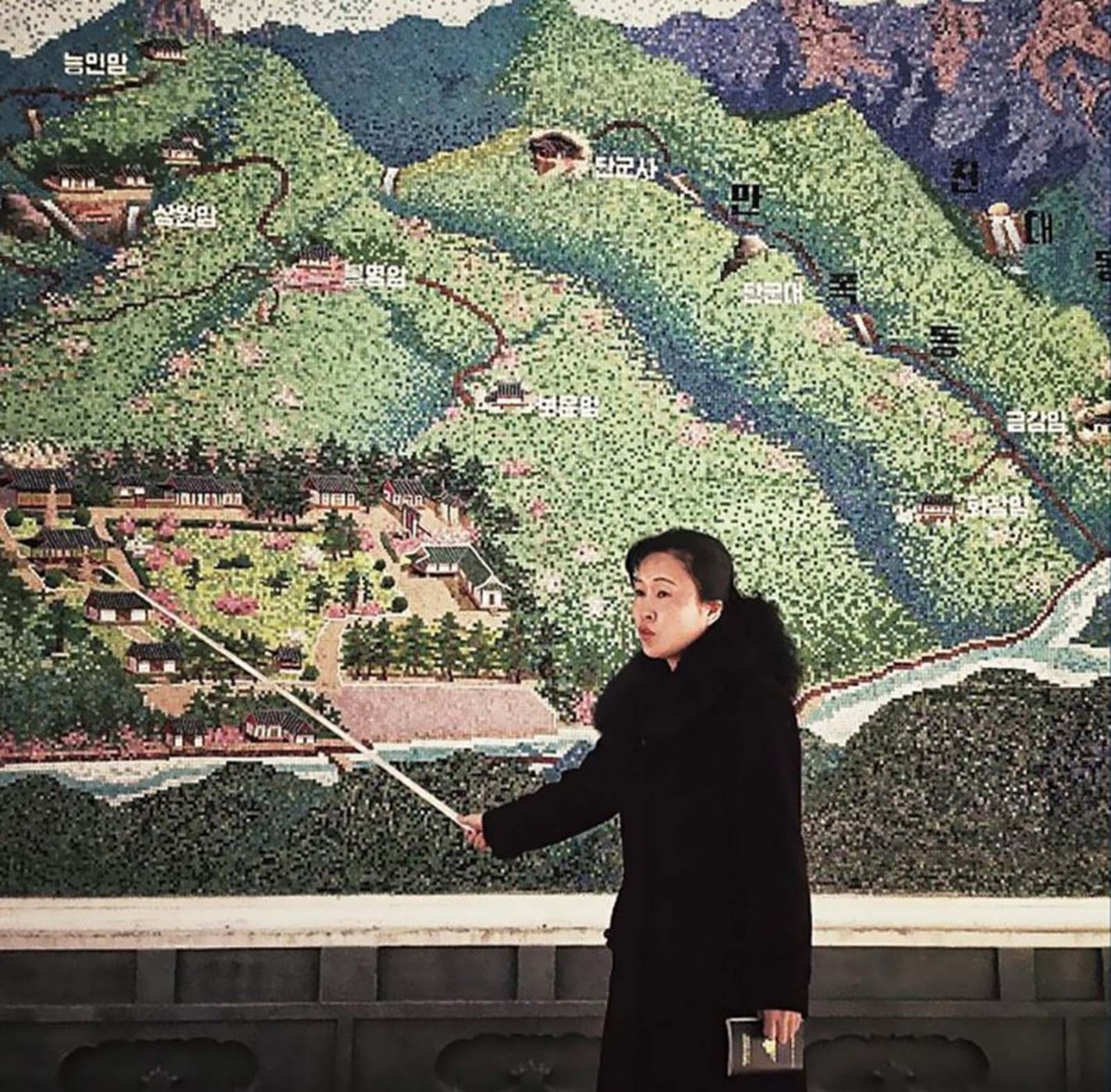
98. North Korea, David Guttenfelder, 2013.
North Korea has been closed to the world for many years. All information flow was censored in both directions – inside and outside of the country. David Guttenfelder, a former chief Asia photographer for the Associated Press, was one of few journalists who could enter North Korea. He documented official events, but the availability of a 3G connection allowed him to raise the voile on military state realty.
He published photos of daily life on his Instagram. “The window [into] North Korea has opened another crack, and meanwhile, for Koreans here who will not have access to the same service, the window remains shut.” We hope that these historical photos will become an illustration of Korean history books one day.

99. Oscars Selfie, Bradley Cooper, 2014.
Selfie of Ellen DeGeneres and Hollywood stars, who appeared on her Twitter right during the Oscar ceremony, became the most popular in history. To date, this Twitter post @TheEllenShow has been retweeted almost 4 million times. This photo became the most viral advertisement for Samsung cell phones. The device on which Bradley Cooper took a picture was provided by the company for Ellen as a part of an advertising campaign a few hours before the T.V.ow. The TV version of making the most twitted selfie clearly shows the white Samsung Galaxy Note 3. Native advertisement of the phone paid back all the funds Samsung spends on the 86th Oscar ceremony. The history of the whole Hollywood decade in one photo.

100. Alan Kurdi, Nilüfer Demir, 2015
Aylan Kurdi is a Syrian 3-year-old refugee of Kurdish descent who tragically died along with several relatives on September 2, 2015, when his family tried to cross the Mediterranean Sea.
At night, along with a dozen other tribesmen, the Kurdi family tried to cross the Mediterranean Sea in two boats, trying to get from Turkey to the Greek island of Kos. According to the stories of survivors, at least 12 people, the trip was the last. Alan himself, his 5-year-old brother Galip, and Rehan’s mother died. Only Abdullah’s father survived.
On September 2, 2015, the boy’s body was thrown onto the Turkish coast near the city of Bodrum, and the body of his mother and, a hundred meters away, brother were also found near him.
Historical photos of Aylan’s body, taken by Nilüfer Demir on the coast of Turkey near the city of Bodrum, were published in many media and attracted significant attention as a symbol of refugees’ tragedy.
As she later said: “I wanted to make the child’s silent scream heard.”
This image is comparable to the historical photos a Vietnamese girl Kim Phuk, burnt by napalm, published in 1972 during the Vietnam War. The resonance in social media made by this photo pushed governments to open closed frontiers for refugees.
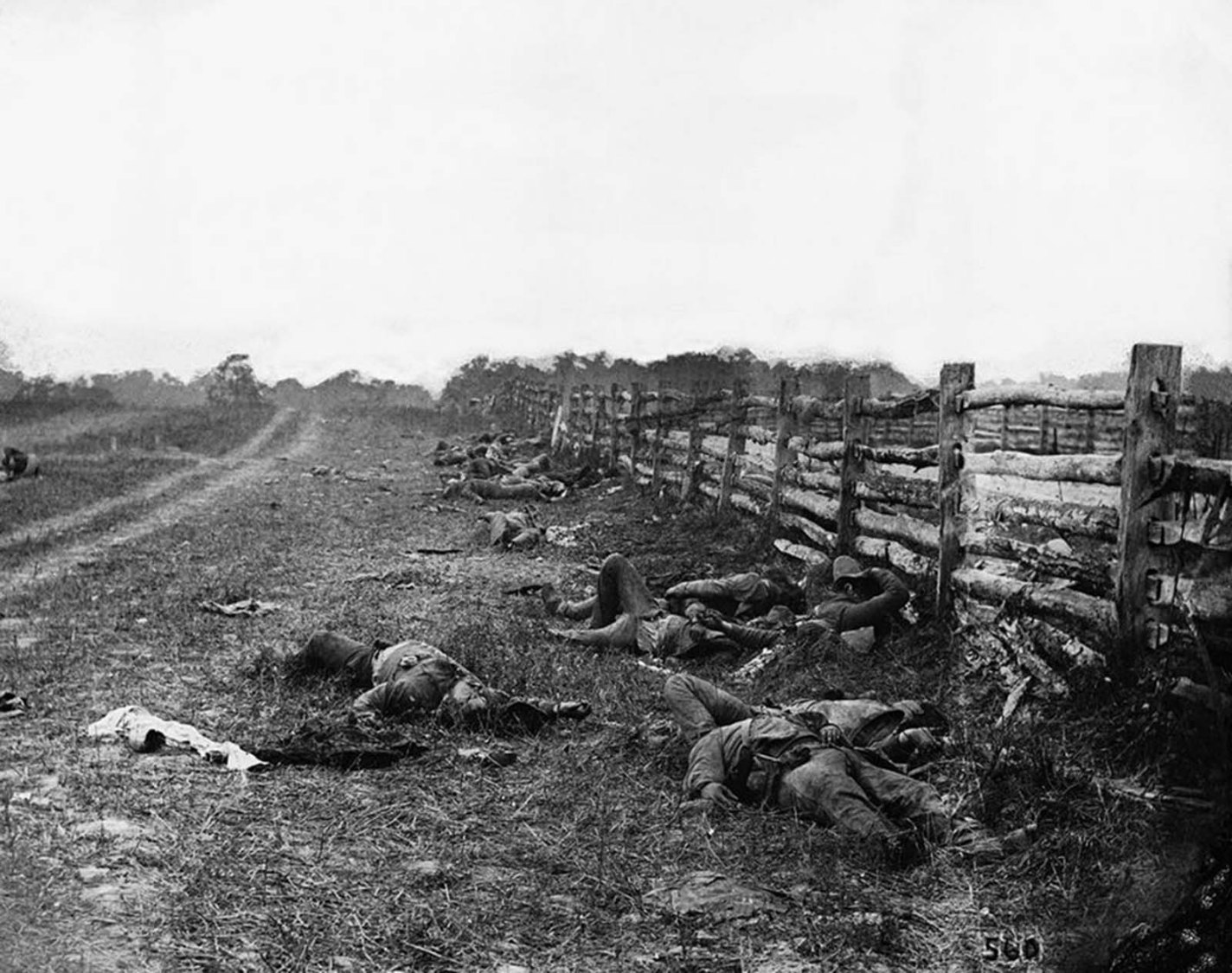
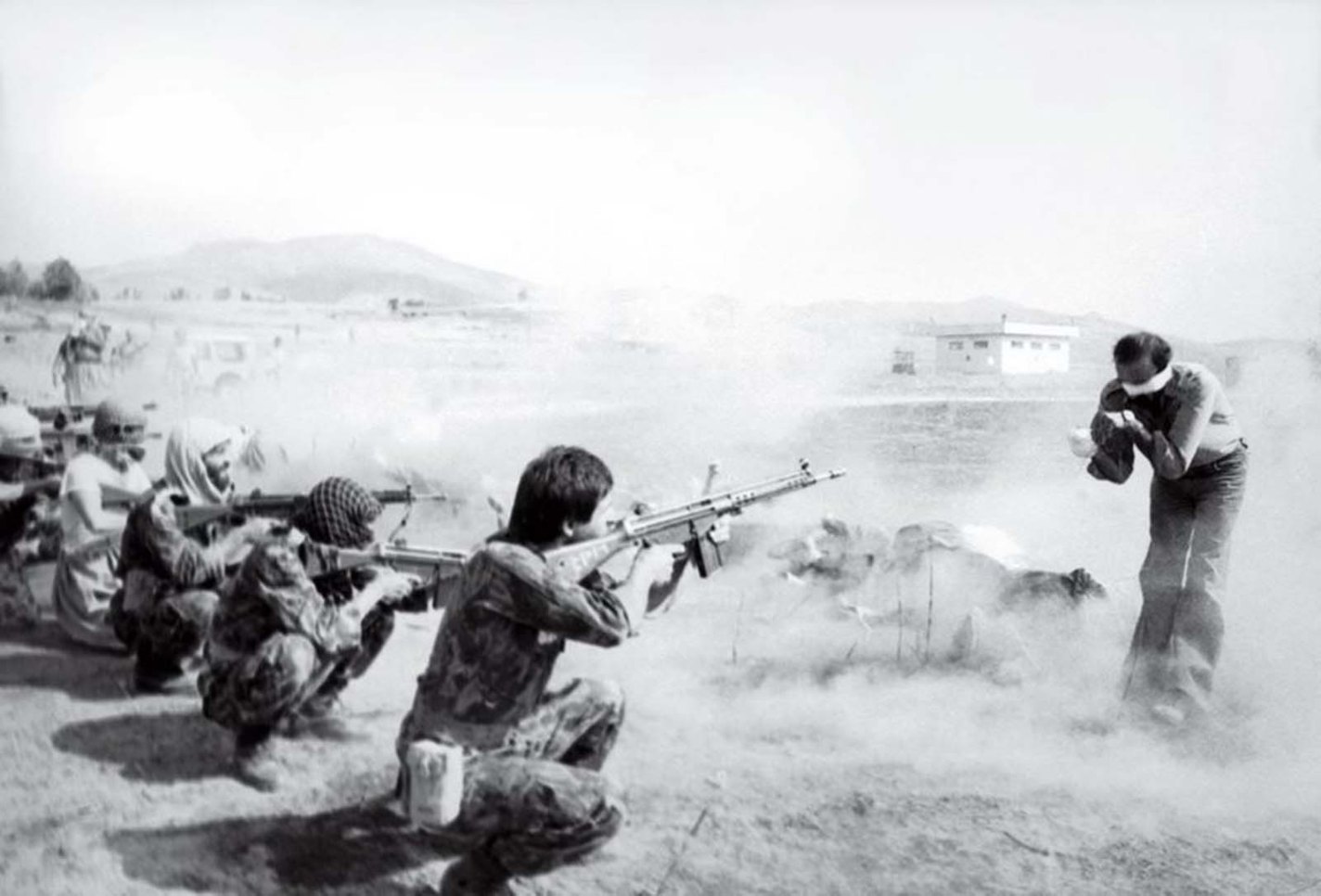
[…] emphasized the perfectly captured shot, made this image an iconic one, the one in the list of the Top 100 most influential photos in history, according to Time […]
[…] dollars for this shot and already a nominal Pulitzer prize. Later this image was named among other Top 100 most influential photos, according to Time […]
[…] she brought from her trip to Nicaragua, and it was rightly picked by Time magazine to be one of 100 influential photos in history. Just look at this Molotov Man: raw revolutionary romanticism is filling each pixel of this […]
[…] main photo’ Munich massacre’ belongs to the Top 100 most influential pictures in history, according to TIME […]
[…] Barack Obama’s recalled the Minamata images in autobiography. He mentioned a photo in the LIFE magazine of a woman holding a disabled child in the bath. When Obama became president of the United States, he made several moves towards an international agreement to limit the use of mercury. One of these photos definitely deserves a place among Top 100 most influential photos in history. […]
[…] Pulitzer prize but did not win. Nevertheless, the ‘Tankman’ occupied its place in the Top 100 most influential photos in history according to Times […]
[…] Winston Churchill started to build his character from a very young age. This titan of politics of the 20th century has always excited the imagination of both countrymen and foreigners. People said that Churchill was fifty percent American, and one hundred percent British. A young Winston Churchill convinced himself that he was born to write history. And he succeeded in doing this. The photo of Winston Churchill is among the TOP 100 most influential pictures in history. […]
[…] Many of the Pulitzer Prize winning photos correspond with the Top 100 most influential pictures in history. […]
Not 17 but 12 people were killed in Munich massacre 1972.(K. Strumpf photography).